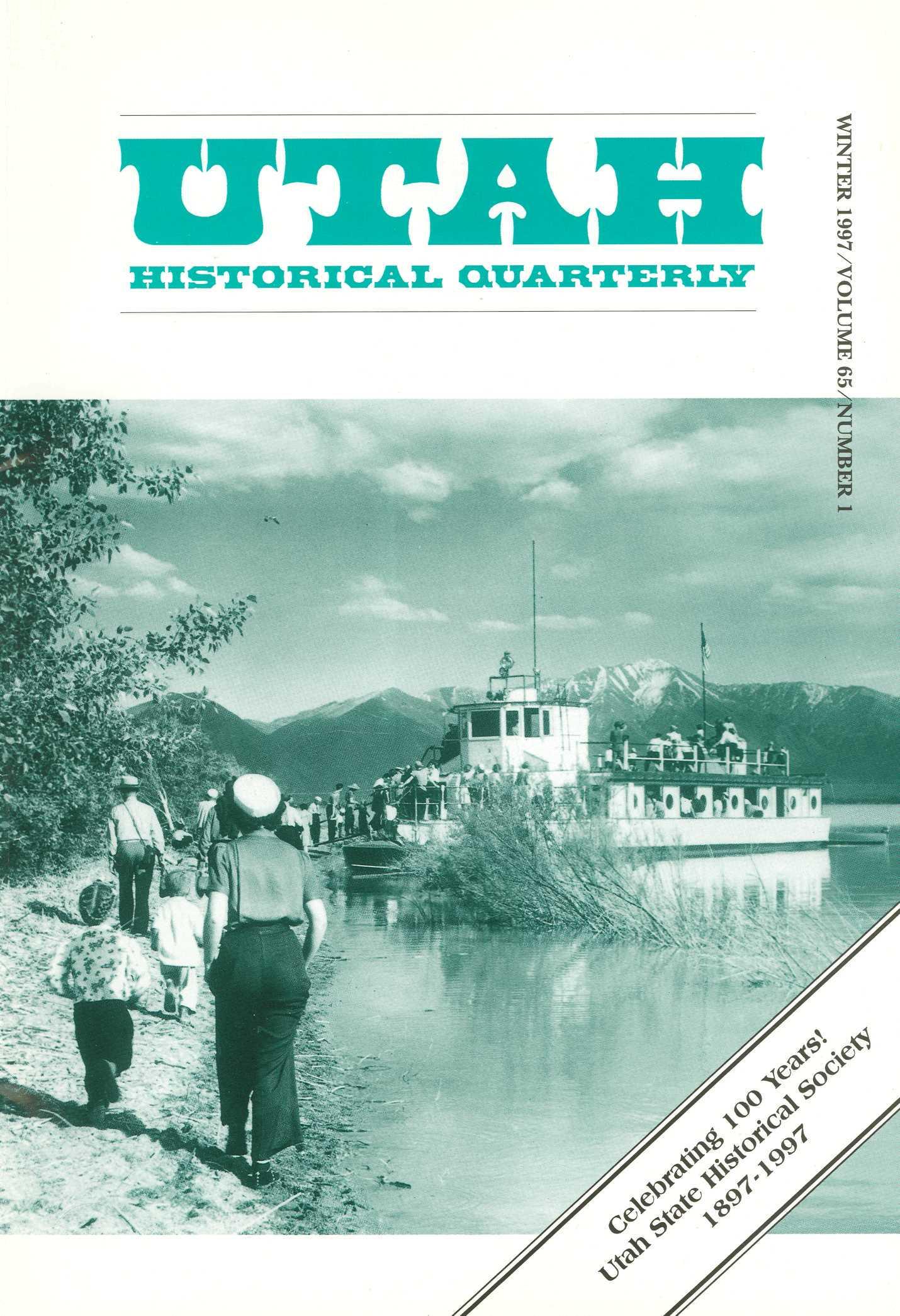
<o to o C5 Or FSF! i i **\ ^ *v.~. v . <J#
UTAH HISTORICAL QUARTERLY (ISSN 0042-143X)
EDITORIAL STAFF
MAX J. EVANS, Editor
STANFORD J LAYTON, Managing Editor
MIRIAM B. MURPHY, Associate Editor
ADVISORY BOARD O F EDITORS
MAUREEN URSENBACH BEECHER, Salt Lake City,1997
AUDREY M GODFREY, Logan, 1997
JOEL C JANETSKI, Provo, 1997
ROBERT S MCPHERSON, Blanding, 1998
ANTONETTE CHAMBERS NOBLE, Cora, WY, 1999
JANET BURTON SEEGMILLER, Cedar City,1999
GENE A SESSIONS, Ogden, 1998
GARY TOPPING, Salt Lake City, 1999
RICHARD S VAN WAGONER, Lehi, 1998
Utah Historical Quarterly was established in 1928to publish articles, documents, and reviews contributing to knowledge of Utah's history The Quarterly is published four times a year by the Utah State Historical Society, 300 Rio Grande, Salt Lake City, Utah 84101 Phone (801) 533-3500 for membership and publications information. Members of the Society receive the Quarterly, Beehive History, and the bimonthly Newsletter upon payment of the annual dues: individual, $20.00; institution, $20.00; student and senior citizen (age sixty-five or over), $15.00; contributing, $25.00; sustaining, $35.00; patron, $50.00; business, $100.00
Materials for publication should be submitted in duplicate, typed double-space, with footnotes at the end. Authors are encouraged to submit material in a computer-readable form, on 5!4 or 3!4 inch MS-DOS or PC-DOS diskettes, standard ASCII text file For additional information on requirements contact the managing editor Articles represent the views of the author and are not necessarily those of the Utah State Historical Society
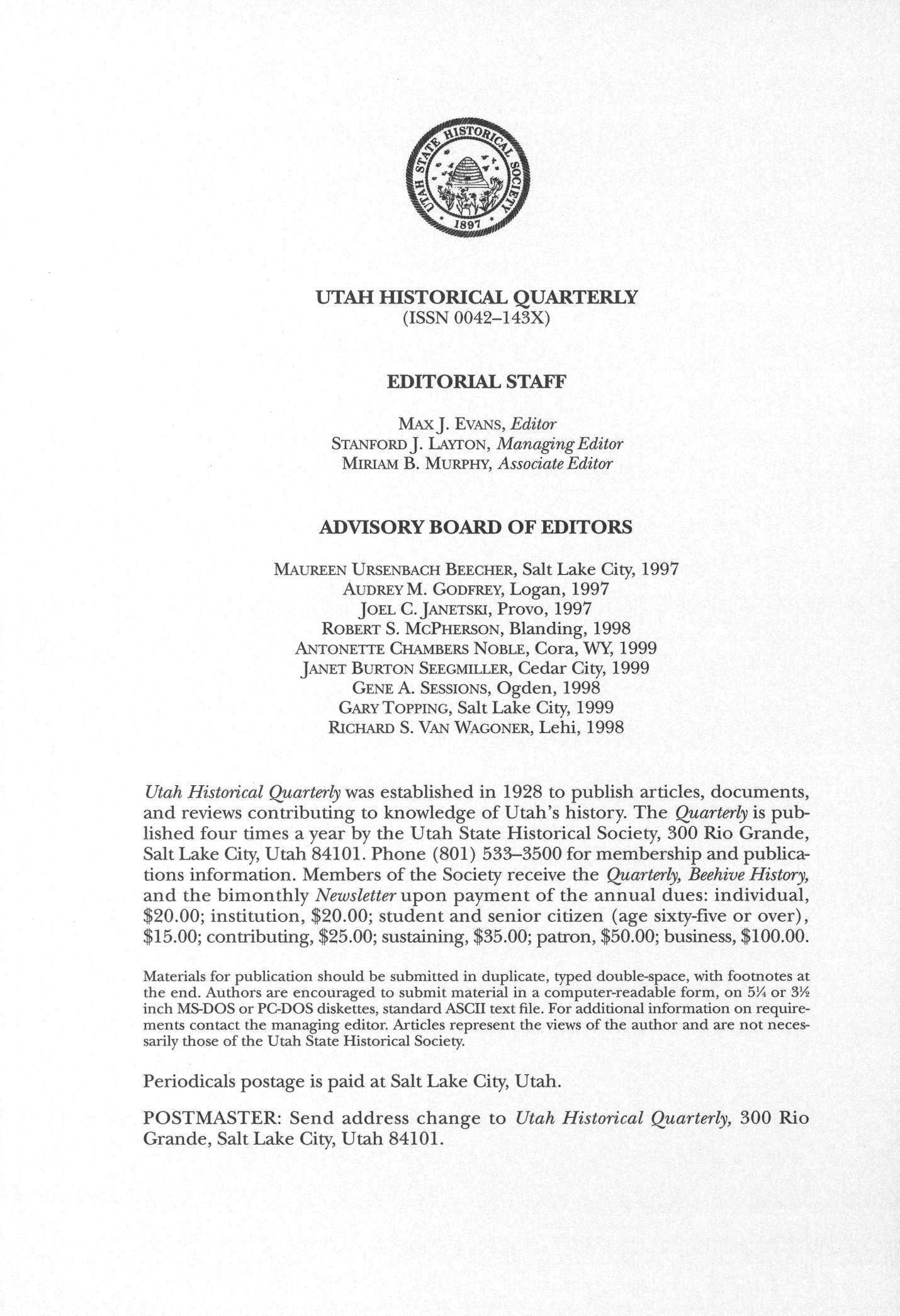
Periodicals postage is paid at Salt Lake City, Utah
POSTMASTER: Send address change to Utah Historical Quarterly, 300 Rio Grande, Salt Lake City, Utah 84101.

HISTORICA L QUARTERL Y Contents WINTER 1997 \ VOLUME 65 \ NUMBER 1 IN THIS ISSUE 3 HOWARD R. ANTES AND THE NAVAJO FAITH MISSION: EVANGELIST OF SOUTHEASTERN UTAH ROBERT S MCPHERSON 4 THE SENSATIONAL MURDER OFJAMES R HAYAND TRIAL OF PETER MORTENSEN CRAIG L. FOSTER 25 A COMMON SOLDIER AT CAMP DOUGLAS, 1866-68 CATHERINE H ELLIS 49 THE S.S. SHO-BOAT: QUEEN OF UTAH LAKE D. ROBERT CARTER 64 BOOKREVIEWS 88 BOOKNOTICES 95 THE COVER The S.S. Sho-Boat was the largest excursion vessel ever to operate on Utah Lake. She was designed, built, and operated by two Utah County men, Elmer Smith and Hewitt Strong, who loved the lake and loved to sail on it. Courtesy of Roland Strong. © Copyright 1997 Utah State Historical Society
WILLIAM B. SMART and JOH N TELFORD. Utah: A Portrait DELMONT R. OSWALD 88
THOMAS LYON and TERRY TEMPEST WILLIAMS, eds. Great and Peculiar Beauty: A Utah Reader JAMES M. ATON 89
FREDERICK S BUCHANAN Culture Clash and Accommodation: Public Schooling in Salt Lake City, 1890— 1994 ROGER H THOMPSON 90
BRIGITTE GEORGI-FINDLAY The Frontiers of Women's Writings: Women's Narratives and the Rhetoric of Westward Expansion RUSSELL BURROWS 91
ARTHUR KING PETERS. Seven Trails West STANLEY B. KIMBALL 92
JOH N S MCCORMICK AND JOH N R SILLITO, eds. A World We Thought We Knew: Readings in Utah History DENNIS L LYTHGOE 93
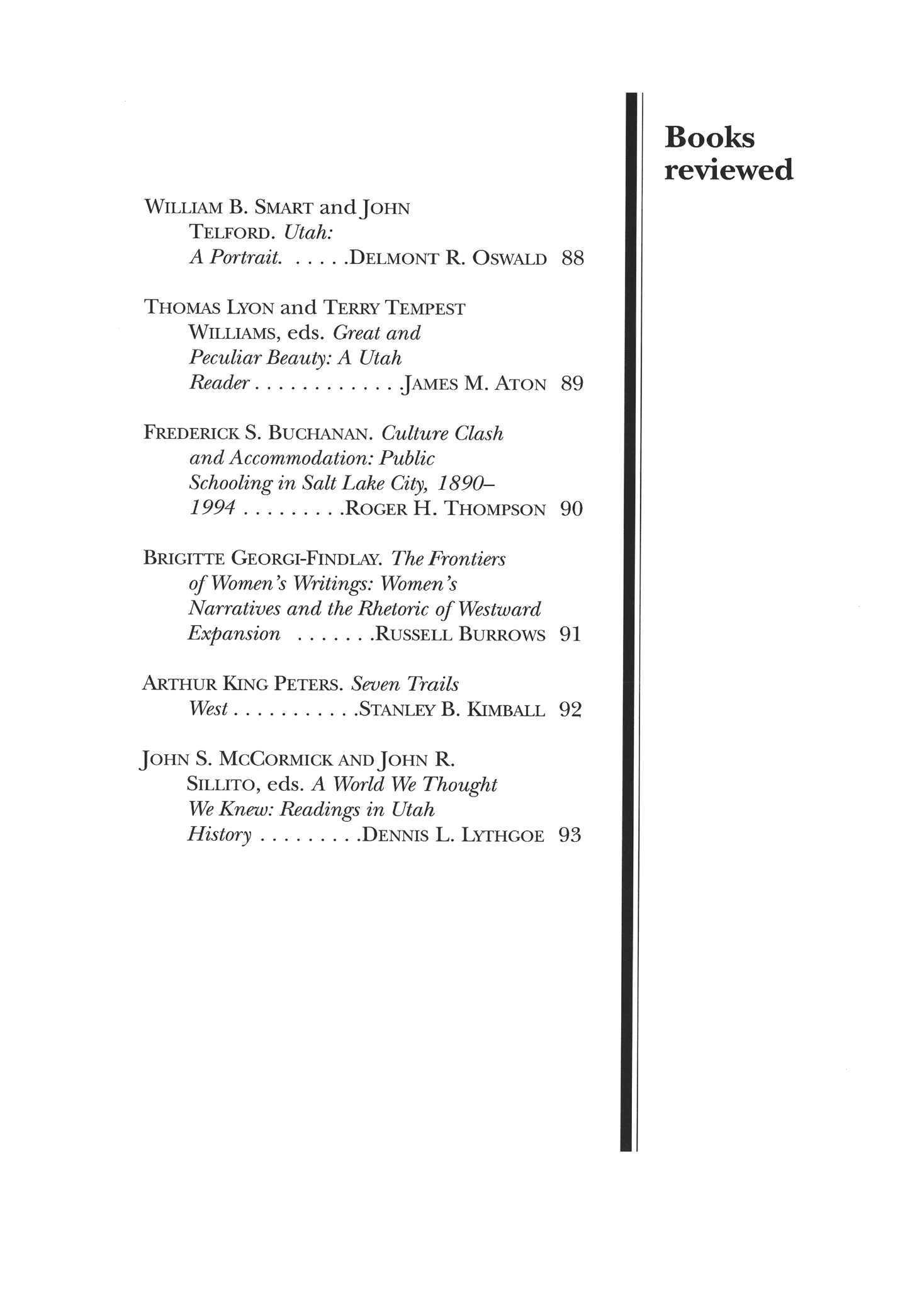
Books reviewed
In this issue
The Four Corners area seemed to cling to its frontier heritage much longer than most other regions of the West. Settled relatively late amidst some of the nation's most rugged terrain features, it remained inaccessible and uninviting in the minds of most potential visitors and homeseekers Yet, for those of a particular mindset—those seeking challenge and adventure— it presented grand opportunities. Such a man was Howard Antes. Making his way to the region near the turn of the century, this eccentric preacher sought to promote reform and economic improvement among the Navajos. In many ways his own worst enemy, Antes at different times and in a variety of ways alienated local ranchers, reservation officials, and many of the native peoples he tried so eagerly to help These dynamics, along with the man's singular triumph, are related in the first article.
During the same time, a remarkable drama was unfolding in Salt Lake City. James R Hay had just been murdered, and one of the most sensational trials in our state's history was soon to follow. Its extraordinary nature was heightened by questions of the validity of evidence claimed to have been received through divine revelation, therefore earning a special niche in judicial history Not until now, in our second selection, has the complete story been fully researched, completely analyzed, and finally told.
Next comes a small but engaging piece detailing the unlikely adventures of a soldier who deserted while assigned to duty at Fort Douglas following the Civil War. Much of the story comes from letters he wrote that have been preserved—quite uncommon for enlisted men of that time and circumstance The denouement is equally uncommon and is sure to leave the reader wearing at least the shadow of a smile
The final offering is a feel-good account of enterprise and success begun during the Great Depression The S.S. Sho-Boat, designed and built by two local entrepreneurs, provided entertainment and escape to thousands of people who paid a quarter or two for a scenic or romantic excursion across the waters of Utah Lake. The story will not only rekindle old memories for a few and serve as a testament to the entrepreneurial spirit for others but will also remind us all that there is nothing wrong with a bit of old-fashioned nostalgia now and then.

i V
"Looking south across the San Juan River from Navajo Faith Mission, Aneth, Utah, 1901." Photograph by Charles Goodman.
Navajo Faith Mission School in Aneth, Utah, 1901; photograph by Charles Goodman. Inset: Howard R. Antes, 1894. All photographs are courtesy of the San Juan Historical Commission and were donated by Lorena C. Antes.
Howard R, Antes and the Navajo Faith Mission: Evangelist of Southeastern Utah
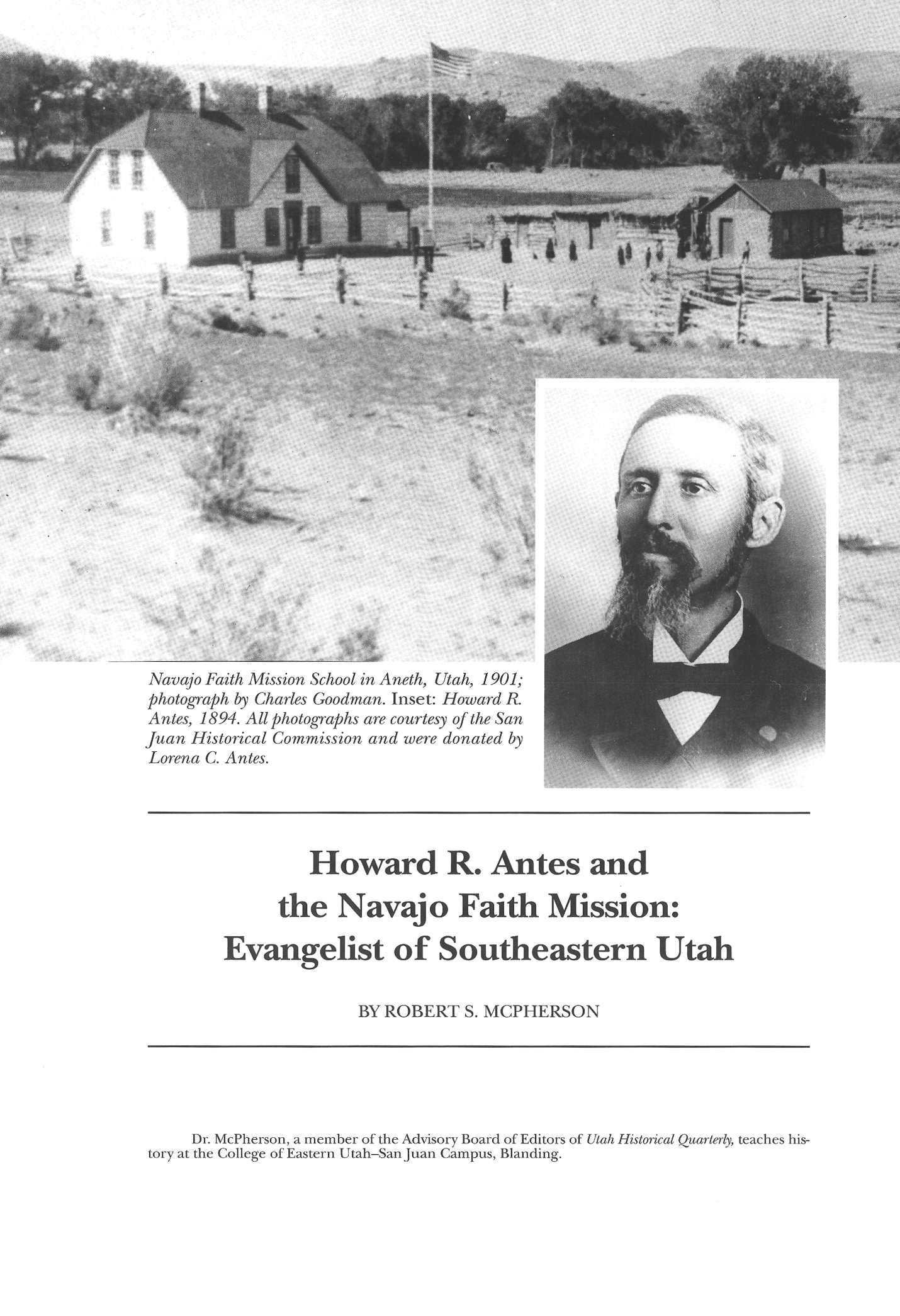 BYROBERT S MCPHERSON
Dr McPherson, a member of the Advisory Board of Editors of Utah Historical Quarleiiy, teaches history at the College of Eastern Utah-San Juan Campus, Blanding
BYROBERT S MCPHERSON
Dr McPherson, a member of the Advisory Board of Editors of Utah Historical Quarleiiy, teaches history at the College of Eastern Utah-San Juan Campus, Blanding
IN 1890 THE FEDERAL GOVERNMENT OFFICIALLY PROCLAIMEDthe American West settled, the frontier epoch in United States history closed. Native Americans surviving the westward movement had been relegated to a reservation system and a "civilizing" process designed to eventually end Indian culture In the East there arose a growing number of white advocates of various programs for Indian people, but only a few of these reformers actually lived and worked in the West. One person who put his sentiments into action was a Methodist missionary named Howard Ray Antes who, with his wife Evelyn (Eva), settled along the San Juan River in the Four Corners area of southeastern Utah.
Born on October 20, 1850, in Homewood, Illinois, Antes received his training for the clergy in the East before moving to Colorado. His early years of ministry speak of a person dissatisfied with his lot in life—in 1887 he started with a church in Windsor, Colorado; in 1889 he served as a missionary to the Navajo in New Mexico; from 1890 to 1893 he was back in Colorado laboring in the Florence Circuit; in 1894 he preached in Glenwood Springs, Colorado; and a year later he requested to be on his own as a nonsectarian minister.1
Yet this record of ill-fated starts belonged to a man with unshakable principle and zeal. In fact, his zeal was probably the cause of his undoing in these early assignments. Described as an "old fashioned Methodist minister," he was a "holiness preacher" who emphasized a strict interpretation of biblical tenets. Drinking, gambling, and womanizing were sins unacceptable to his beliefs, though his parishioners desired a more liberal approach to ethical behavior. He faced the demands of his congregation head on, refused to change his ways, and chose instead to move on. 2
Howard and Eva Antes came to the San Juan River country armed with almost puritanical faith. Writing in a self-published newspaper called The Navajos Evangel, Antes told of electing not to be tied to any particular denomination in order to be "entirely free to wholly followJesus."3 "Literal obedience" to the commandments and a "prac-

5
1 Paul Millette, archivist, Iliff School of Theology, to author, July 28, 1993.
- Telephone conversation with Lorena Antes, June 18, 1991
3 Howard R Antes, The Navajos Evangel, October 1901, pp 1-2
tical appropriation" of biblical promises created a covenant with God and, the missionaries believed, "His Spirit would make his will known to us; and, saving us from fanaticism, give enough wisdom to perform present duty, and enough faith to take a step forward in search of the next one." In responding to God's call they had avoided "all serious want, and [been] protected and guarded from harm, and even prospered far beyond [their] worthiness." The land and conditions they had chosen to settle in would exact every ounce of their zeal in the years to come.
The Anteses spent the first year of their mission in Jewett, New Mexico, at the Methodist Woman's Mission founded in 1891 by Field Matron Mary Eldridge.4 In 1895 Howard and Eva traveled sixty-five miles northwest to a sparsely populated community then called Holyoak. The couple, "with the help of many Navajos, and a few white men, whose hearts God touched to kindly assist us," spent three weeks building a wagon road over rough terrain. 5 They purchased some property from a man leaving the area and eventually obtained the post office, which they named Anath (Aneth), a Hebrew term meaning "Answer." Their primary goal was to establish the Navajo Faith Mission to bring succor to the Indians during the height of the 1890s depression and an accompanying drought.
Antes fashioned his first home of logs but soon started on an adobe dwelling Built with the help of several contributions from Mrs Henry Ledyard, a wealthy advocate from Rhode Island, the singlestory, 29 x 46-foot structure was plastered with lime inside and out, then marked off in squares in imitation of stone masonry. The Ledyard Home, as it came to be called, had eleven bedrooms and a pantry. The dwelling served as a home for the Anteses and "neglected Indian children" who came to the mission for education and religious
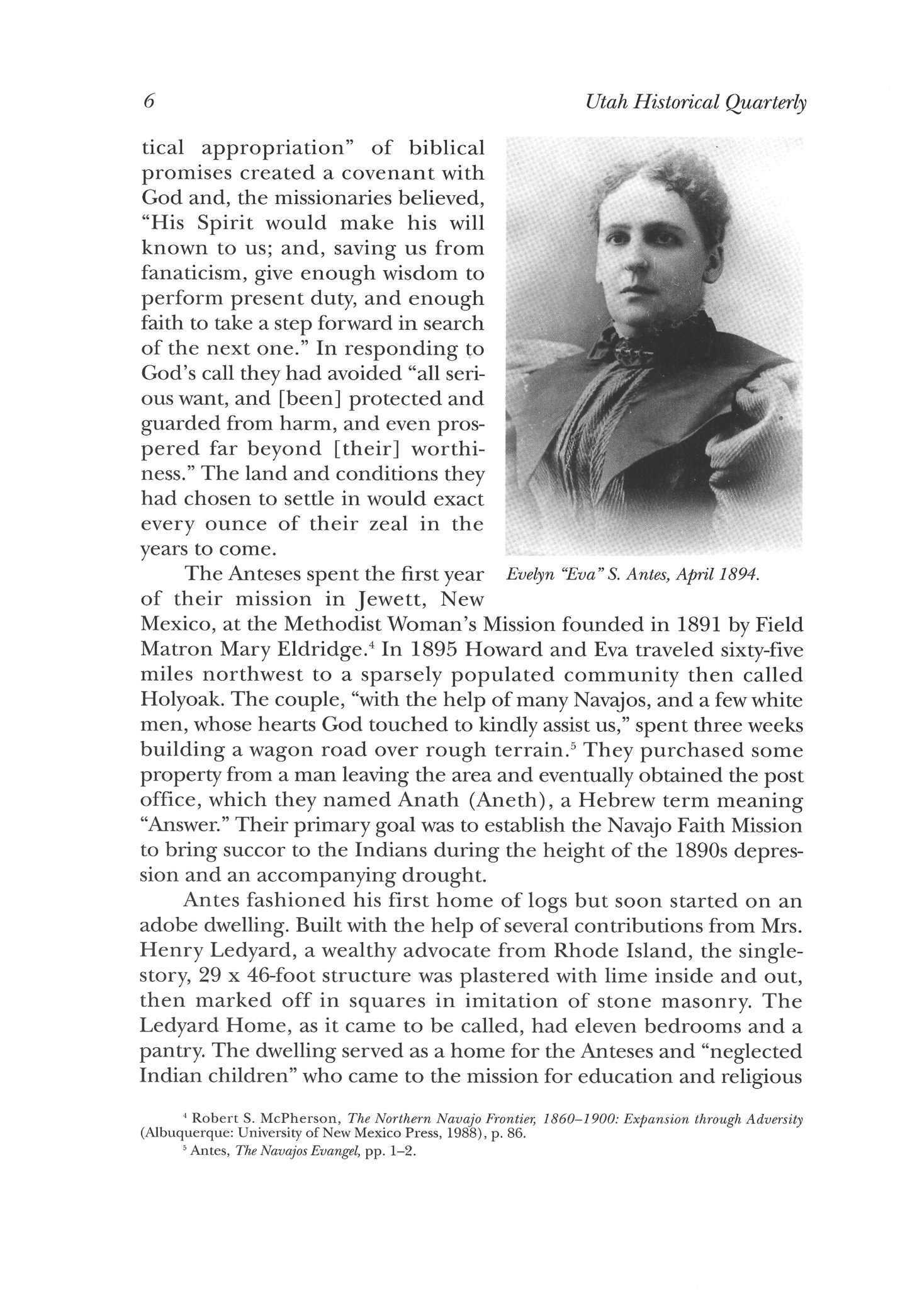
6 Utah Historical Quarterly
Evelyn "Eva"S. Antes, April 1894.
4 Robert S. McPherson, The Northern Navajo Frontier, 1860-1900: Expansion through Adversity (Albuquerque: University of New Mexico Press, 1988), p 86
5 Antes, The Navajos Evangel, pp 1-2
The Navajo Faith Mission
instruction. A smaller school building and a number of wooden shelters completed the structures comprising the Navajo Faith Mission.
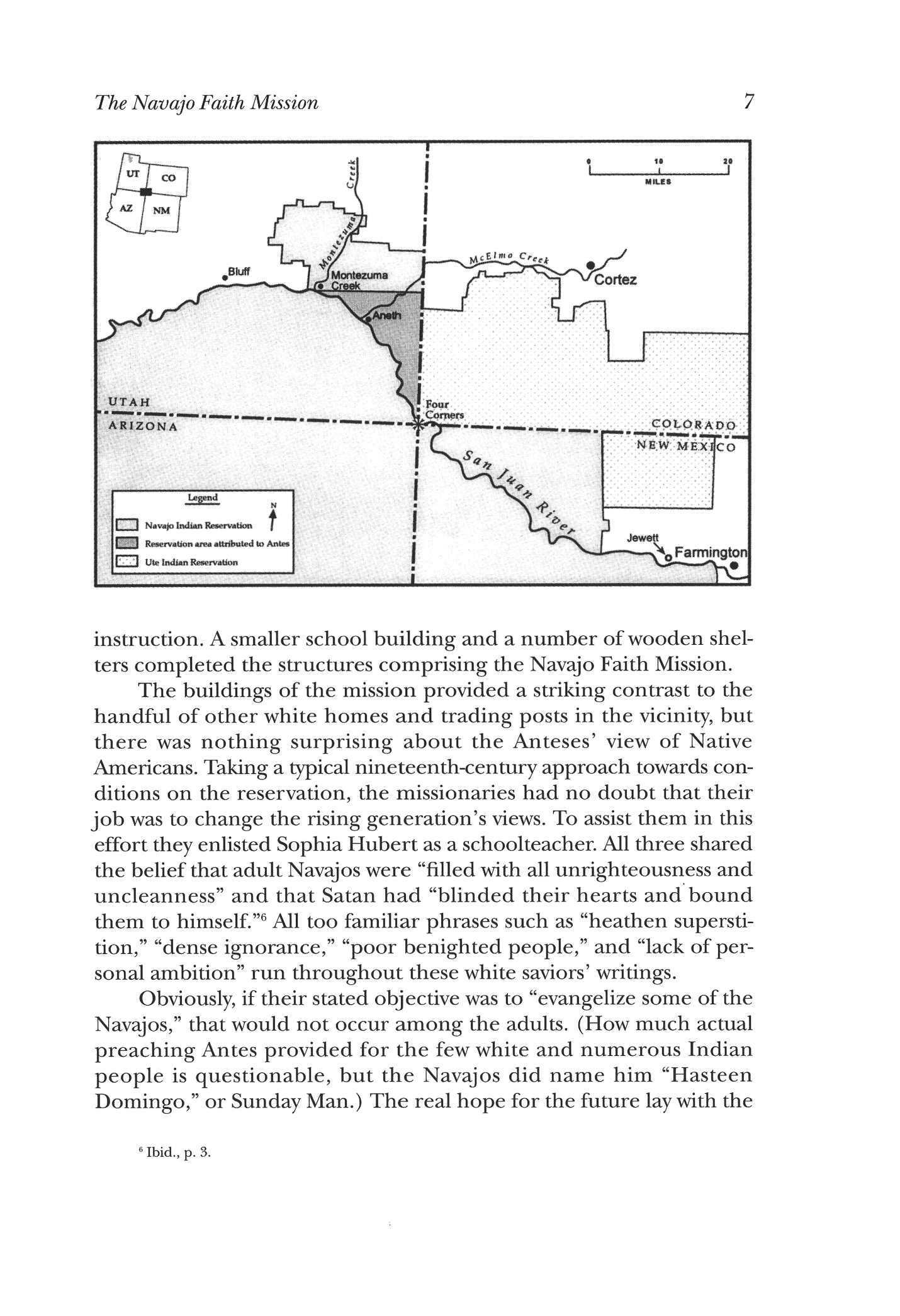
The buildings of the mission provided a striking contrast to the handful of other white homes and trading posts in the vicinity, but there was nothing surprising about the Anteses' view of Native Americans. Taking a typical nineteenth-century approach towards conditions on the reservation, the missionaries had no doubt that their job was to change the rising generation's views To assist them in this effort they enlisted Sophia Hubert as a schoolteacher. All three shared the belief that adult Navajos were "filled with all unrighteousness and uncleanness" and that Satan had "blinded their hearts and bound them to himself."6 All too familiar phrases such as "heathen superstition," "dense ignorance," "poor benighted people," and "lack of personal ambition" run throughout these white saviors' writings.
Obviously, if their stated objective was to "evangelize some of the Navajos," that would not occur among the adults. (How much actual preaching Antes provided for the few white and numerous Indian people is questionable, but the Navajos did name him "Hasteen Domingo," or Sunday Man.) The real hope for the future laywith the
Ibid., p 3
1
ti ;•:' 1
I"*,- -,"| Vte
fj Navajo Indian Reservation j
Reservation area attainted to Antes
Indian Reservation
children The mission would serve as a "rescue home or nursery" for young Navajos where they could learn the rudiments of reading, writing, and speaking English with the Bible as a text. When the children reached adolescence they would be removed to another settlement away from the reservation where their transformation into "industrious, intelligent Christians and citizens" would be completed. In 1901 the Lord had not yet identified that spot, but by 1904the Gold Medal Orchard and Farm situated in upper McElmo Canyon just outside of Cortez, Colorado, became the sought-after location. This last point—removing the Indians from the reservation—is important in understanding future conflicts. To Antes's wayof thinking, Indian reservations were a product of a federal policy that intentionally kept the Navajos in a "cesspool of ignorance and superstition and immorality."7 The Navajos were "penned up with the tribal herd on a desert where not even white men could herd sheep profitably." Raising children and women for barter, laziness, and relaxed enforcement of federal rules concerning education were only a few of the problems fostered by a government inattentive to the civilizing process. Hope of temporal and religious salvation remained with the children.
Although Antes may have felt a strong aversion to what he saw happening to Navajo adults, he nevertheless assumed a helpful, neighborly approach with those around him. For example, Old Mexican, a Navajo living in the Montezuma Creek-Aneth area, recalled how "Andy" gave him boards and instructed him on building a headgate to control irrigation water. Old Mexican often went to the mission and received counsel. One time Antes chided him for chasing after women, even though he already had two wives and a number of offspring The Navajo complained that he would happily "take care of my children, buy them clothes, and give them something to eat every once in a while. . . . But I don't care to go back and live with those women. I am scared of my oldest wife. She might do something to me if I were to go back to them." 8 The missionary encouraged him to return to his fatherly duties, and shortly thereafter he once again started providing for his children.
Yet Old Mexican and his problems were only a peripheral concern compared to the mission school that opened in 1899. The facility persisted for eight years with its highest enrollment reaching fifteen
7 Ibid., p. 4.

8 Utah Historical Quarterly
8 Walter Dyk, A Navaho Autobiography (New York: Viking Fund, 1947), pp. 84, 95-96.
The Navajo Faith Mission
students. This figure is hardly representative of the estimated 250 Navajos living nearby along the river, but sheep herding and farming were far more critical for survival than the rudimentary curriculum the mission offered.9 Indeed, when Sophia Hubertjoined the Anteses she estimated that another fifty or sixty potential pupils lived within ten to twelve miles up and down the river.10
Facilities at the mission continued to grow. By 1904 the site

9 William T Shelton, "Report of Superintendent in Charge of Navaho on San Juan," August 12, 1905, Report of the Commissioner of Indian Affairs (Washington, D.C.: GPO, 1905), pp 267-68
10 Sophia Hubert to Commissioner of Indian Affairs, December 5, 1902, J Lee Correll Collection, Navajo Archives, Window Rock, Arizona (hereinafter cited as NA)
Navajo Faith Mission, photographed by Charles Goodman in 1901. In both photographs the adults are Howard R. Antes, Eva Antes, and Sophia Hubert; the Indian children are unidentified boarding school students.
boasted the Ledyard Home, a smaller school building, and surrounding farm lands and orchards located on the river's flood plain. Antes never took up homestead rights on this property.11 Instead, he put all of his energy into dispensing charitable donations from the East to the Navajos who, according to Antes, were still destitute. He and Eva encouraged the blanket-weaving industry by loaning the wool and dyes necessary for production and "furnishing people with ton after ton of clothing and flour" to sustain them through the winter.12 Antes also stored sacks of corn at the mission for the Navajos who "could not keep it at home without being obliged to give it away."13 Making coffins and burying the dead were other community services provided by the mission
Little wonder when the citizens of Bluff in 1902 petitioned the government to help the starving Navajos that Antes, along with LDS Bishop Jens Nielson of Bluff and Samuel Shoemaker, a government farmer stationed in Farmington, New Mexico, were the men recommended for this humanitarian effort.14 Agent George W. Hayzlett soon received instructions from the secretary of the interior to investigate the situation and to help the 6,000 impoverished Indians in San Juan County—a population statistic far out of line with other sources—by spending $3,000 to purchase emergency rations Hayzlett met Shoemaker in Farmington and then went to the mission to begin his investigation.
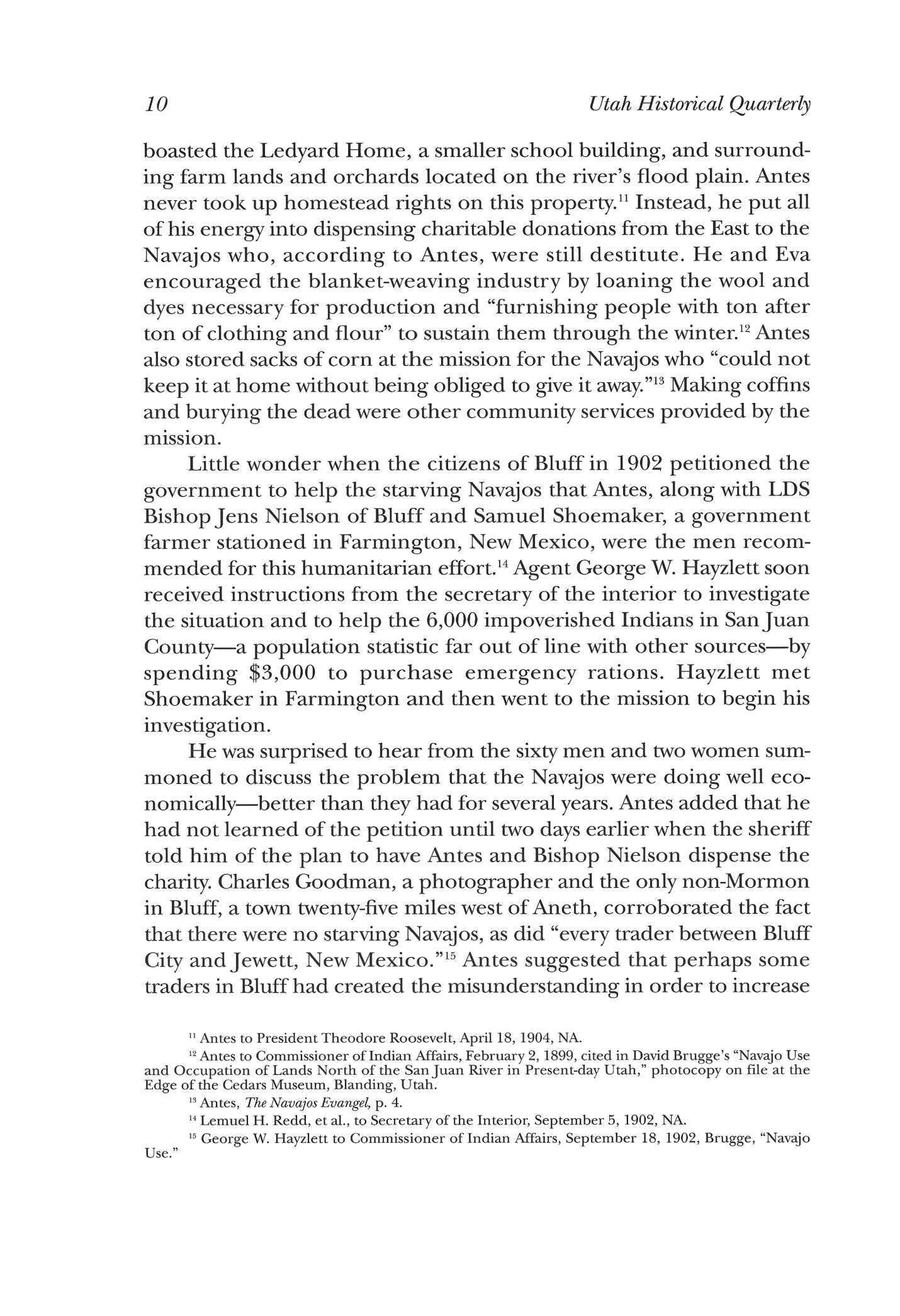
He was surprised to hear from the sixty men and two women summoned to discuss the problem that the Navajos were doing well economically—better than they had for several years. Antes added that he had not learned of the petition until two days earlier when the sheriff told him of the plan to have Antes and Bishop Nielson dispense the charity. Charles Goodman, a photographer and the only non-Mormon in Bluff, a town twenty-five miles west of Aneth, corroborated the fact that there were no starving Navajos, as did "every trader between Bluff City and Jewett, New Mexico."15 Antes suggested that perhaps some traders in Bluff had created the misunderstanding in order to increase
11 Antes to President Theodore Roosevelt, April 18, 1904, NA
12 Antes to Commissioner of Indian Affairs, February 2, 1899, cited in David Brugge's "Navajo Use and Occupation of Lands North of the San Juan River in Present-day Utah," photocopy on file at the Edge of the Cedars Museum, Blanding, Utah
13 Antes, The Navajos Evangel, p 4
14 Lemuel H Redd, et al., to Secretary of the Interior, September 5, 1902, NA
15 George W Hayzlett to Commissioner of Indian Affairs, September 18, 1902, Brugge, "Navajo Use."
10 Utah Historical Quarterly
The Navajo Faith Mission
their own business through government contracts, but he provided no clear evidence to support his supposition.
Before leaving the region Hayzlett noted that there were no white settlers (excluding those at the mission and three trading posts) along the river for seventy or eighty miles, that the Indians had dug an estimated twelve miles of irrigation ditches "madejust as well as any white man could have done," and that the Navajos should file individual allotments on these lands Antes agreed to obtain the necessary forms and assist the Indians in filling them out.
Despite what had been said at the meeting, people in the region continued to report destitute Navajos through the winter of 1903. Sheriff C. L. Christensen assured Hayzlett that there were sixty-five families or 536 Navajos who needed employment and commodities The agent responded by contacting Shoemaker and telling him to construct another ditch and to pay Indian laborers on it a dollar a day. Emergency funds of $243.50 met only part of the need, but eventually the "crisis" subsided.16 Whether it was the machinations of traders seeking profit or humanitarian ideals that sparked interest, the end result created the desire for greater Navajo self-sufficiency and more ditches outlined on the agent's agenda.
This incident was not the first, nor would it be the last, that placed Antes in a questionable situation. Since his arrival in 1895 there really was no other spokesman for the Navajos living along the river as they confronted livestock owners interested in public grazing lands. The government owned a vast amount of territory in San Juan County that was there for the asking The county commissioners helped oversee activities on public land and obtained revenue for the land's use, but it was open to any applicant. Meanwhile, reservation lands strained to meet the needs of expanding livestock herds, unclaimed water sources were nonexistent or inadequate, and agents could not effectively patrol the boundaries. This, coupled with the attitude that Native Americans needed to become more self-sufficient by taking out individual allotments, encouraged Navajos and agents alike to look for solutions across the San Juan
By 1898 Antes took pen in hand on behalf of the Navajos. He accused Fred Adams, county tax assessor from Bluff, of locating Indian livestock north of the river and charging an inflated license fee of three or four sheep or goats per one hundred while white livestock
16 Hayzlett to Commissioner of Indian Affairs, January 16, 1903, ibid
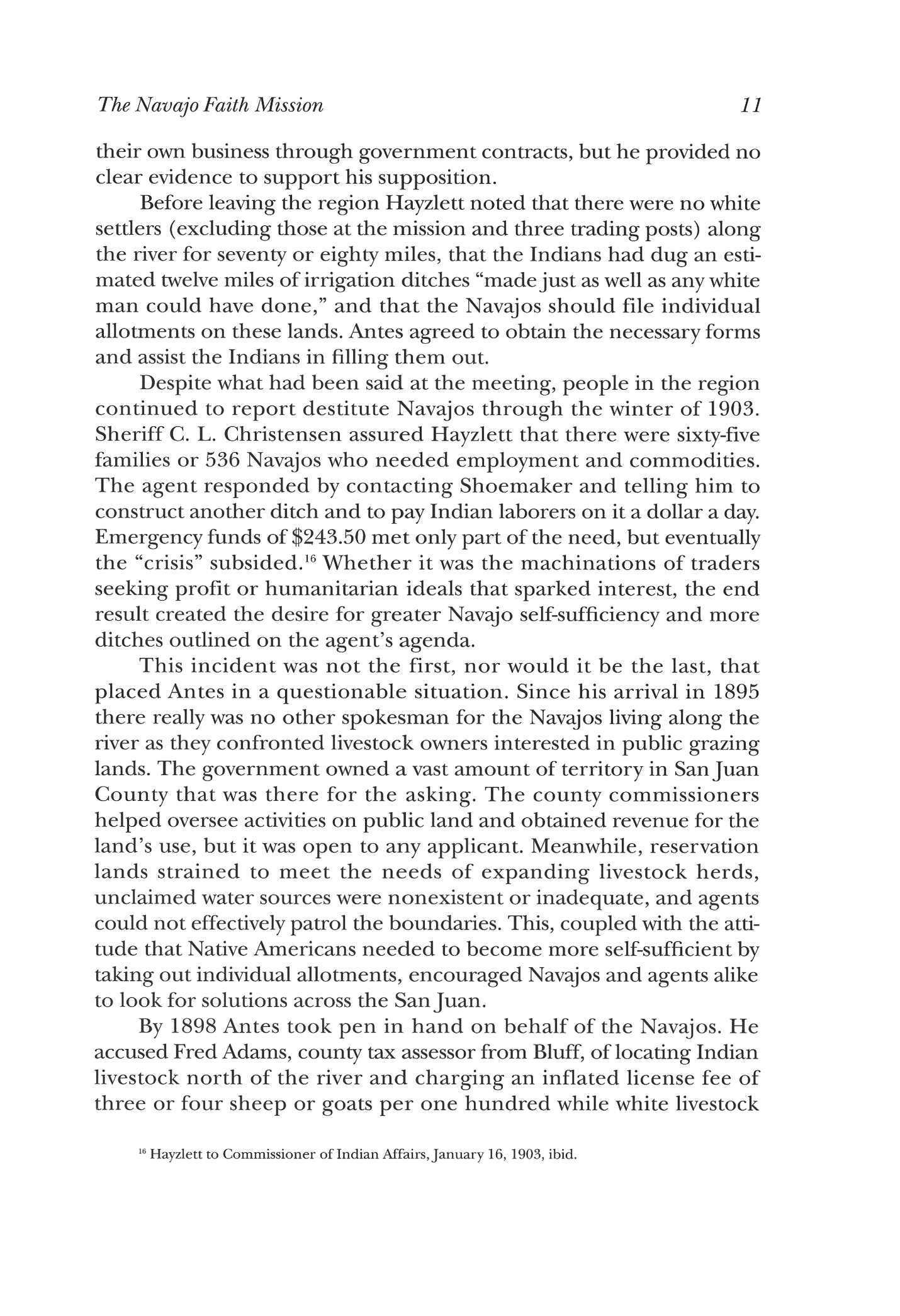
11
owners paid only two-and-a-half cents per head. To Antes, this was pure and simple extortion designed to force the Navajos with their large herds back onto the reservation. When told that the "interference of a missionary" was unnecessary, he wrote to Secretary of the Interior C. R. Bliss requesting that he intervene.17
Antes argued that the land was so barren and rocky it was suitable for no other occupation, noting that "fifty miles above us and twentyfive miles below us along the SanJuan River, there are but two [white] men who have a few acres of cultivation" and a couple of trading posts. Because Indian flocks would starve on the sandy, rocky wastes of the reservation, Antes maintained, they should have untaxed access to the resources north of the river Sprinkled throughout this plea were phrases like, "As their friend . . . and as the friend of God, which I know you are also" and, in referring to the Navajo, "destruction of as poor and friendless creatures as our merciful Father in heaven ever called upon us all to show mercy unto, as we hope to receive mercy."18
Antes's letter obtained the desired effect Bliss turned to W A Jones, commissioner of Indian Affairs, who turned to Hayzlett. The response came shortly. The Indians had the right to be there and should not be taxed. As for Mr. Adams, he had overstepped his legal bounds by using "false pretense."Jones sent a letter directly to Antes, stating that the Navajos should pay no taxes as long as they kept the livestock on unoccupied lands and that the missionary should collect evidence to bring Adams to trial.19
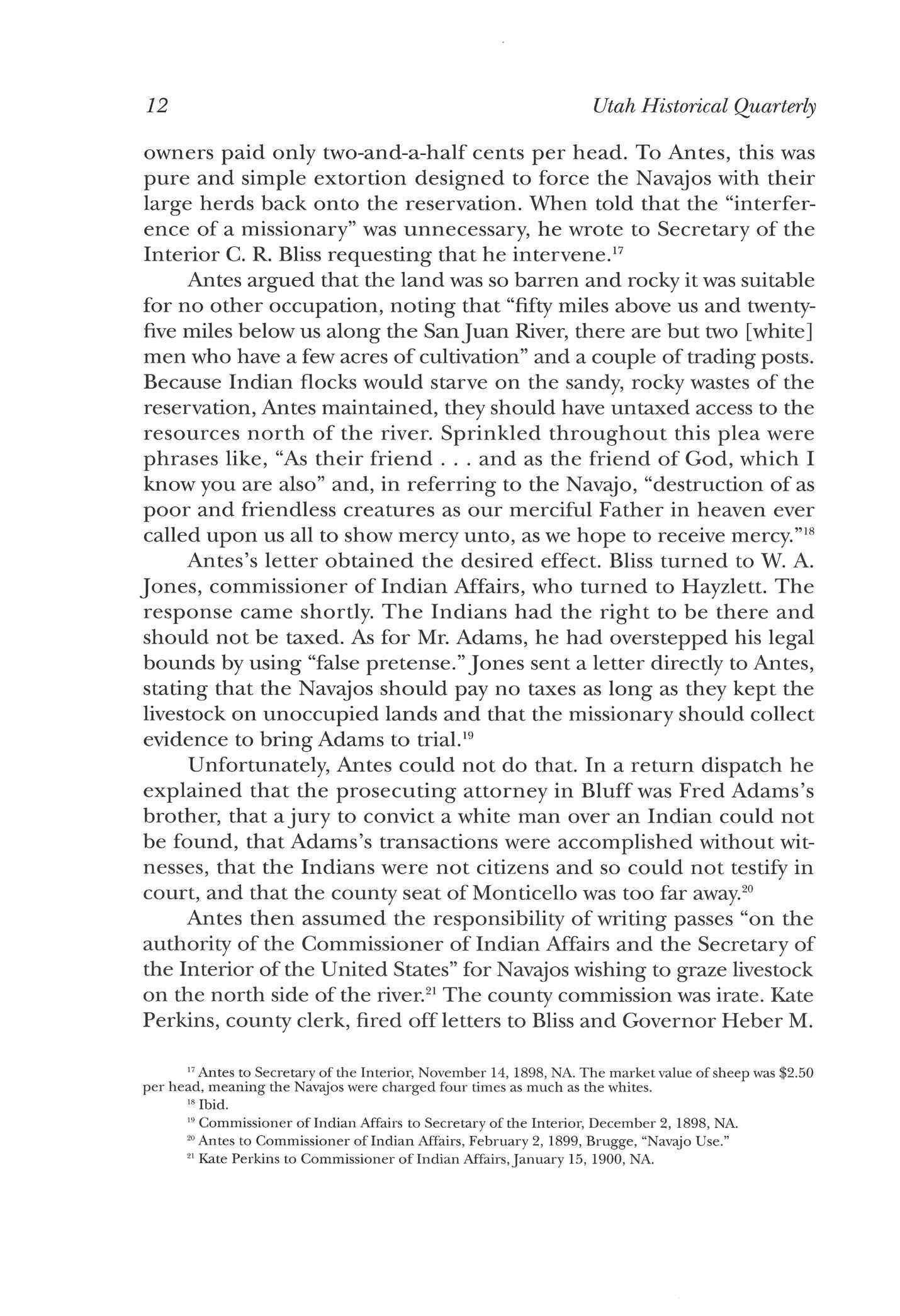
Unfortunately, Antes could not do that. In a return dispatch he explained that the prosecuting attorney in Bluff was Fred Adams's brother, that ajury to convict a white man over an Indian could not be found, that Adams's transactions were accomplished without witnesses, that the Indians were not citizens and so could not testify in court, and that the county seat of Monticello was too far away. 20
Antes then assumed the responsibility of writing passes "on the authority of the Commissioner of Indian Affairs and the Secretary of the Interior of the United States" for Navajos wishing to graze livestock on the north side of the river.21 The county commission was irate Kate Perkins, county clerk, fired off letters to Bliss and Governor Heber M.
18 Ibid
12 Utah Historical Quarterly
17 Antes to Secretary of the Interior, November 14, 1898, NA The market value of sheep was $2.50 per head, meaning the Navajos were charged four times as much as the whites.
19 Commissioner of Indian Affairs to Secretary of the Interior, December 2, 1898, NA
20 Antes to Commissioner of Indian Affairs, February 2, 1899, Brugge, "Navajo Use."
21 Kate Perkins to Commissioner of Indian Affairs, January 15, 1900, NA
Wells, demanding to know if Antes had the power he claimed and if the Navajos could actually use the lands tax free. The county commission cited an 1897 ordinance requiring that all livestock be licensed, that failure to do so was a misdemeanor, and that the penalty would be double the original value of the license.22 True to bureaucratic form, Commissioner of Indian Affairs Jones stated that as long as the Navajos had paid the proper tax and followed the guidelines of the county and the state, they were as free to use the lands as any white man. If they did not break the law, no action could be taken against them.23 The subject of the missionary's assumption of power was not discussed
Antes saw in the situation another opportunity to end the turbulence over range lands. Government surveys conducted through the area in 1899 and the increased interest in ditch building for agricultural purposes had fostered the idea that perhaps the lands near the San Juan should become a permanent part of the reservation. As a solution to the problems of self-sufficiency for a burgeoning population, advocates pointed out that "land along the river can be irrigated and put under a state of cultivation far cheaper per acre than any other part of the reservation."24
The time was right. In 1903 William T. Shelton, with his aggressive, straight-forward, no-nonsense personality, assumed responsibilities as the first superintendent of the new Shiprock Agency, which included Utah lands south of the river Although that area was peripheral to much of the activity in New Mexico and Arizona, Shelton never lost sight of its potential. The Navajos petitioned him for surveying help to put in ditches there.
Meanwhile, Antes had again decided to champion the Navajo cause On April 10, 1904, he wrote to President Theodore Roosevelt, asking for an extension of the reservation Chester A Arthur had granted the first such extension by executive order in 1884, which had moved the boundary to the SanJuan River. In 1892 mining and homestead interests had forced the return of some of these lands to the public domain, but in 1908 they again returned to reservation status. The lands in the Aneth-Montezuma Creek area were the first that Navajos had requested north of the river. Antes pointed out that a

The Navajo Faith Mission 13
22 Ordinance found in Minutes, San Juan County Commission, April 26, 1880, to March 1900, p 245, County Courthouse, Monticello, Utah
23 W A Jones to Heber M Wells, February 1, 1900, Record Group 75, Letters Received, Office of Indian Affairs, 1881-1907, Bureau of Indian Affairs, National Archives, Washington, D.C
24 Hayzlett to Commissioner of Indian Affairs, July 28, 1903, Brugge, "Navajo Use."
number of white settlers had attempted to farm the region and had given up. There remained only three stores, the Navajo Faith Mission, and the post office operated by Antes He anticipated the end result of an extension of the reservation would be less friction between stockmen and Indians and more desirable conditions for the Navajos.25 Shortly after this communication, Shelton visited the area. Although he described it primarily as a wasteland and believed the morals, customs, and progress of the Navajos in the region "far below the average," he also felt they would work if given the right opportunity. He cited as proof the fact that they had already cut a ditch 200 yards long and twelve feet deep, using only picks, shovels, a level, and plumb-bob for surveying and construction. Unfortunately, all this work could be erased if a major flood scoured the drainage.26
The next question was how to best secure the land Harriet M Peabody, a charity worker among Navajos in the area, thought that individual allotments would be the most practical. She noted how the Indians, most of whom were clustered around the mouth of McElmo Creek, had fenced their lands and built irrigation ditches. They lacked some technical expertise that a farmer could provide, and so she recommended that a trader in Aneth named James M. Holley be given this position.
Shelton agreed in part. He felt Antes's suggestion of annexing the land was good, but he noted that if the Indians had to obtain it through homesteading it would take them twenty-five years to clear its title. On the other hand, if Roosevelt issued an executive order that the land would be protected from encroachment by livestock owners, the Navajos would have access to it and messy legal entanglements would be avoided.27 The three traders living there—Holley, Bryce, and Kermode—could remain unmolested.
Friction continued to fuel the movement to obtain the land Holley reported to Shelton that "Mormons at Bluff were hauling away fences from around Indian gardens and the logs from their homes. He named Frank Hyde,John Adams,Joe Barton, Lemuel Redd, and KumenJones, many of whom were traders. Holley believed these tactics were designed to force the Indians back across the river Holley had probably hoped to tarnish his competitors' reputations, since
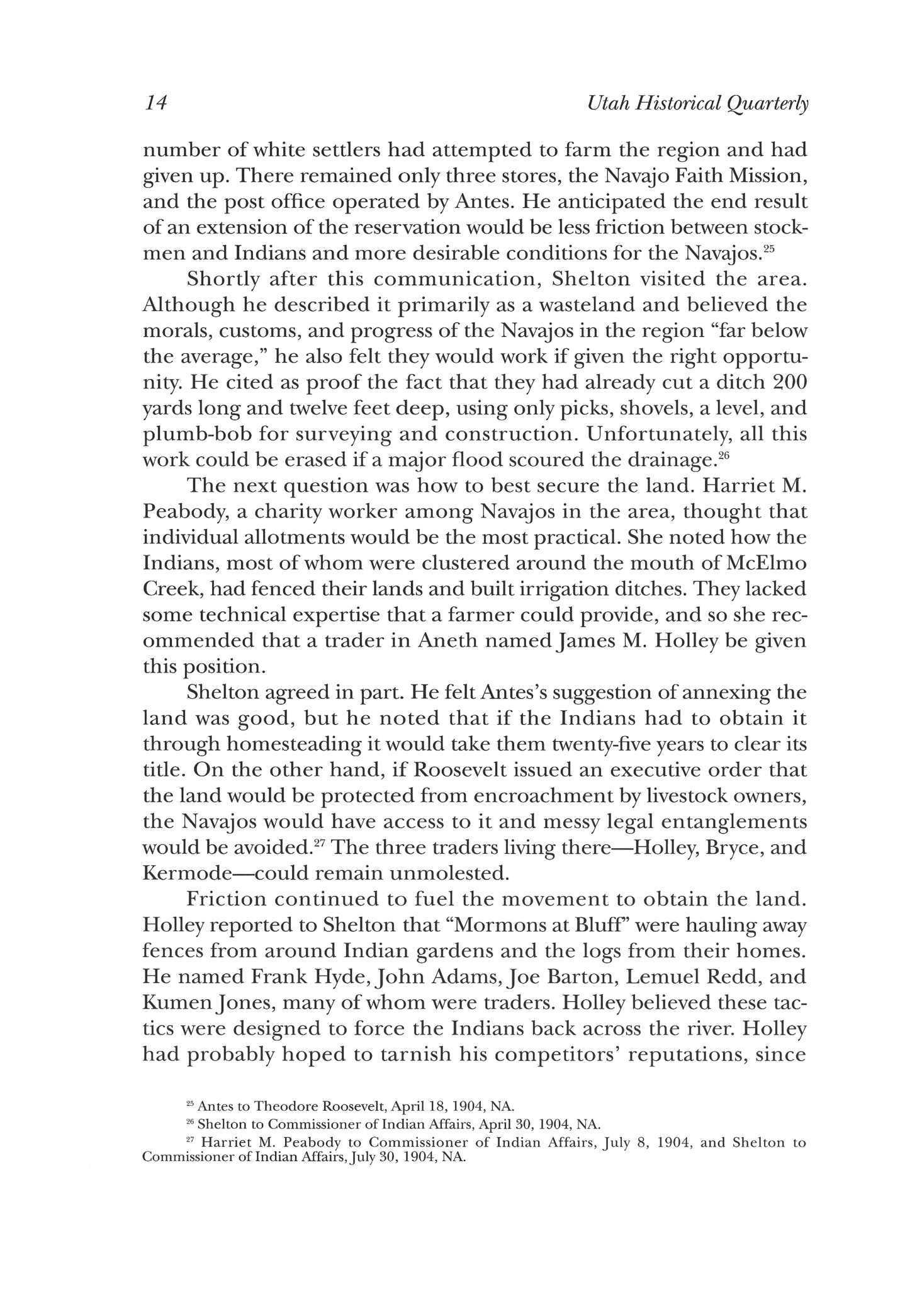
14 Utah Historical Quarterly
25 Antes to Theodore Roosevelt, April 18, 1904, NA
26 Shelton to Commissioner of Indian Affairs, April 30, 1904, NA
27 Harriet M. Peabody to Commissioner of Indian Affairs, July 8, 1904, and Shelton to Commissioner of Indian Affairs, July 30, 1904, NA
The Navajo Faith Mission 15
Shelton investigated the complaints with Navajos and found no basis for the accusations. Holley, in almost the same breath, had also asked Shelton to recommend him for a government position to work with the Indians, which he soon obtained.
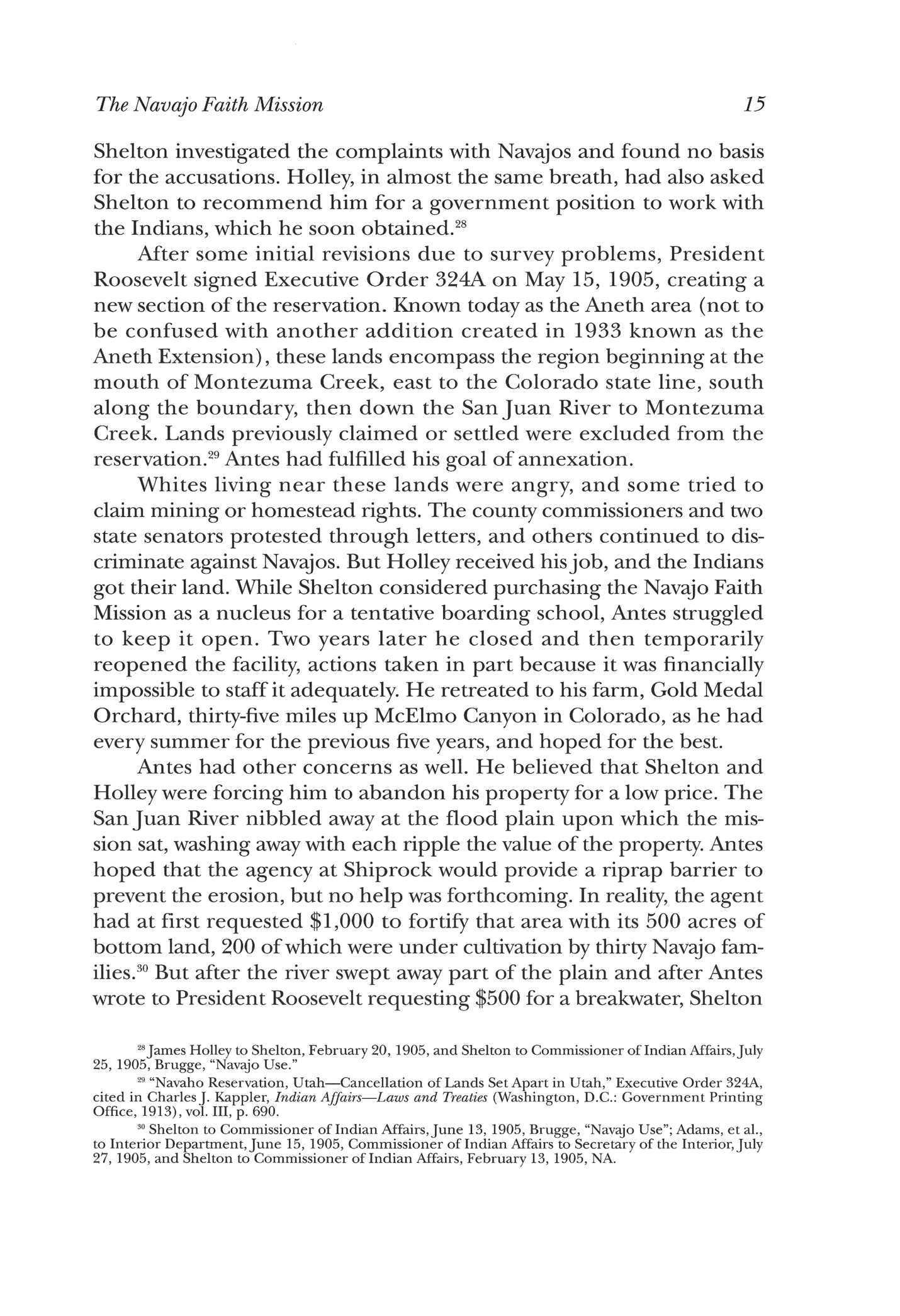
28
After some initial revisions due to survey problems, President Roosevelt signed Executive Order 324A on May 15, 1905, creating a new section of the reservation. Known today as the Aneth area (not to be confused with another addition created in 1933 known as the Aneth Extension), these lands encompass the region beginning at the mouth of Montezuma Creek, east to the Colorado state line, south along the boundary, then down the San Juan River to Montezuma Creek. Lands previously claimed or settled were excluded from the reservation.29 Antes had fulfilled his goal of annexation.
Whites living near these lands were angry, and some tried to claim mining or homestead rights. The county commissioners and two state senators protested through letters, and others continued to discriminate against Navajos. But Holley received hisjob, and the Indians got their land. While Shelton considered purchasing the Navajo Faith Mission as a nucleus for a tentative boarding school, Antes struggled to keep it open. Two years later he closed and then temporarily reopened the facility, actions taken in part because it was financially impossible to staff it adequately. He retreated to his farm, Gold Medal Orchard, thirty-five miles up McElmo Canyon in Colorado, as he had every summer for the previous five years, and hoped for the best Antes had other concerns as well. He believed that Shelton and Holley were forcing him to abandon his property for a low price. The San Juan River nibbled away at the flood plain upon which the mission sat, washing away with each ripple the value of the property Antes hoped that the agency at Shiprock would provide a riprap barrier to prevent the erosion, but no help was forthcoming. In reality, the agent had at first requested $1,000 to fortify that area with its 500 acres of bottom land, 200 of which were under cultivation by thirty Navajo families.30 But after the river swept away part of the plain and after Antes wrote to President Roosevelt requesting $500 for a breakwater, Shelton
28 James Holley to Shelton, February 20, 1905, and Shelton to Commissioner of Indian Affairs, July 25, 1905, Brugge, "Navajo Use."
29 "Navaho Reservation, Utah—Cancellation of Lands Set Apart in Utah," Executive Order 324A, cited in Charles J Kappler, Indian Affairs Laws and Treaties (Washington, D.C.: Government Printing Office, 1913), vol Ill, p 690
30 Shelton to Commissioner of Indian Affairs, June 13, 1905, Brugge, "Navajo Use"; Adams, et at, to Interior Department, June 15, 1905, Commissioner of Indian Affairs to Secretary of the Interior, July 27, 1905, and Shelton to Commissioner of Indian Affairs, February 13, 1905, NA
changed his mind The agent felt that it would require between $2,000 and $3,000 to restore the river to its original channel and that the missionary should protect his own property. Moreover, although Antes had offered two years earlier to sell the mission for $1,500 as a possible boarding school, it was now too late, since "the best of it has been destroyed."31
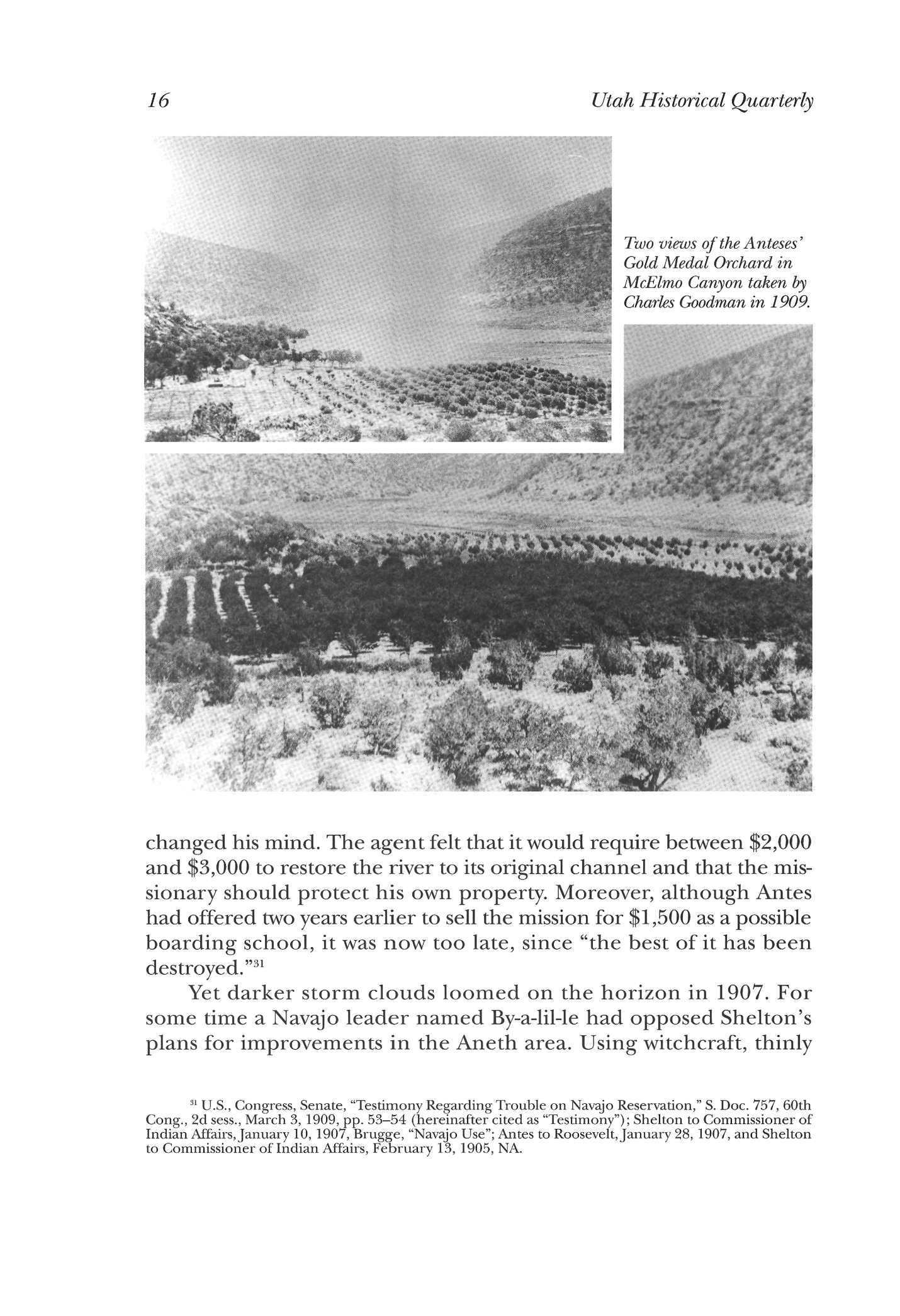
Yet darker storm clouds loomed on the horizon in 1907 For some time a Navajo leader named By-a-lil-le had opposed Shelton's plans for improvements in the Aneth area Using witchcraft, thinly
31 U.S., Congress, Senate, "Testimony Regarding Trouble on Navajo Reservation," S Doc 757, 60th Cong., 2d sess., March 3, 1909, pp 53-54 (hereinafter cited as "Testimony"); Shelton to Commissioner of Indian Affairs, January 10, 1907, Brugge, "Navajo Use"; Antes to Roosevelt, January 28, 1907, and Shelton to Commissioner of Indian Affairs, February 13, 1905, NA
16 Utah Historical Quarterly '- ' • , '« « -
Two views of the Anteses' Gold Medal Orchard in McElmo Canyon taken by Charles Goodman in 1909.
/ %.
'**$*$
Smj^'-iSk
veiled threats, and outright force, he coaxed and coerced a faction of Navajos to resist government programs. By-a-lil-le encouraged his followers to avoid sending their children to school, refuse to use the government sheep-dip vats located at the mouth of Montezuma and McElmo creeks, and defy the orders of Navajo policemen. On October 27, 1907, Shelton and his Indian police led Captain H. O. Williard and two troops of the Fifth Cavalry on a surprise attack of the Navajos' camp. The Indians started shooting, and the soldiers returned fire, killing two and wounding another. They captured By-alil-le along with eight men deemed equally quarrelsome. The troublemakers were marched to Shiprock, Fort Wingate, and then Fort Huachuca, Arizona, where they spent two years at hard labor.32

Although the incident ended quickly and by most accounts was well handled, Antes seized the opportunity to wage another crusade— this time against Shelton Why their relationship had deteriorated is not entirely clear. Perhaps it stemmed from the disagreement over building the riprap dam to protect the mission property, or Shelton's loss of interest in purchasing the site, or a growing misunderstanding over an adopted Navajo boy (to be discussed later), or inaccurate information Antes received from biased sources Whatever the reason, the missionary resorted to the same techniques that had worked so well before. He fired off letters to Colorado Senator H. M. Teller and to the editor of the Denver Post. In them he accused the troops of opening fire on "the poor, defenseless, people," abusing the prisoners, shooting Indians in the back, destroying crops, stealing corn, and scaring the Navajos into the hills. Then the troops withdrew, leaving "the settlers to the mercy of bloodthirsty Indians coming from Cortez."33
Within six months of the incident, Colonel Hugh L. Scott, superintendent of the U.S Military Academy and investigator for the government, received word to proceed to Utah and determine the truthfulness of the charges. He arrived in Aneth on April 19, 1908, and sent for Antes, who was staying on his farm in McElmo Canyon On April 21 the investigation began with Captain Williard, Agent Shelton, Navajo interpreter Bob Martin, Colonel Scott, and Reverend Antes present in the schoolhouse.
The burden of proof rested with the minister, who first called
32 Earl D. Thomas, "Report, Department of Colorado," War Department Annual Reports, 1908, vol. 3 (Washington, D.C.: GPO, 1908), pp 151-52
33 "Testimony," p 29
17
The Navajo Faith Mission
Navajo witnesses Many had difficulty understanding what it meant to be sworn in Antes tried to clarify the procedure through Martin and said, "Does he [the witness] know God heard what he said and is strong enough to punish him if he told a lie?" which received the reply, "He does not think so."34 Eventually some of the witnesses understood enough to be acceptable to all concerned; with others, the panel just agreed to let them speak.
Old Mexican related his experience. He had been in the midst of lambing season when a man approached him and his older brother to attend the hearing. Disinclined at first, he relented and met with "an old man with white hair, dressed up in a uniform with an eagle on his shoulder." Two Indians, one an Apache and the other a Kiowa, "dressed up all in feathers," plus five Navajo policemen and Shelton, comprised the group. Old Mexican said the agent and the missionary had argued long and hard, but he was reluctant to say much about Bya-lil-le because he did not know him that well. As far as this witness was concerned, the matter was already settled. A stronger reason was blurted out when Shelton asked him if he was still afraid of By-a-lil-le, to which Old Mexican replied, "I'm afraid of him all right That's all I'm going to tell you No more."35
Antes asked that the session adjourn to Mancos, Colorado, where a white witness named Oliver lived, but Scott denied the request, saying that this man had been summoned, had not shown up, and so was "unwilling." The investigation dragged on until almost midnight. The colonel closed on a question to Antes, asking if the missionary had the right to talk to Indians even if a government agent forbade it. Antes said he had the right to talk to anyone he pleased when his home was off the reservation, and even though now the boundary change had encompassed his property it did not change this right Scott, who disagreed, believed that the whole problem resulted from this attitude
The following day, Williard and Shelton built their defense. For nine hours the two men systematically destroyed the allegations brought against them and proved that previous Indian testimony was inconsistent and inaccurate. Williard presented a detailed statement showing the absurdity of claims that the Navajos carried high-powered rifles but supposedly had no ammunition, that one of Antes's witnesses who claimed to have been sleepy could conveniently recall specific details when necessary, that no Indian had been shot in the
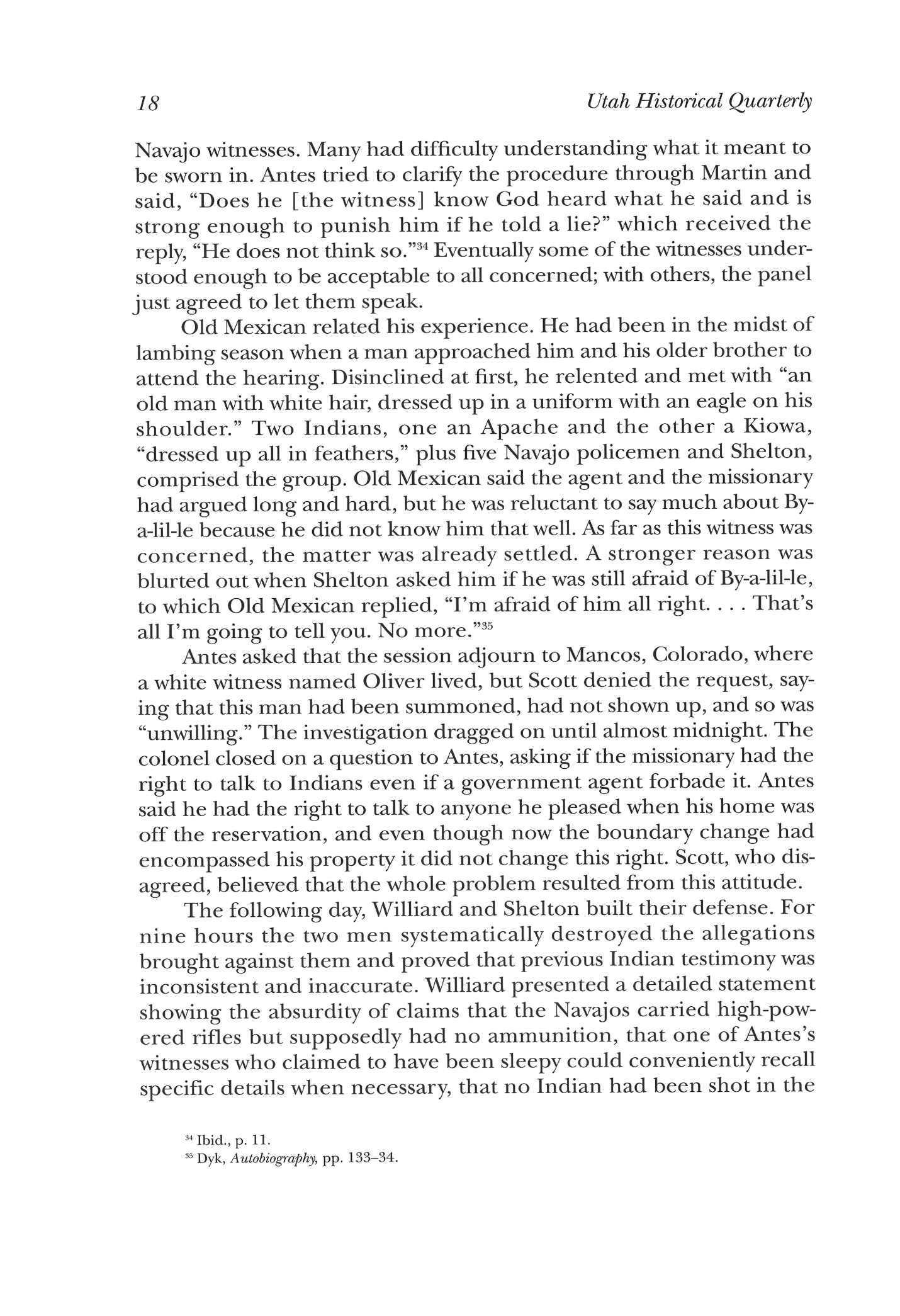
"Ibid., p 11
35 Dyk, Autobiography, pp 133-34
18 Utah Historical Quarterly
back, that the soldiers had taken steps to bury the dead, that nothing was stolen, and that crops purportedly destroyed during the fight had already been harvested Summarizing his feelings, Williard hotly protested that Antes's allegations "were wilfully and deliberately false and malicious . . . , based on hearsay of the flimsiest character, without an iota of truth [and that he] had been made the butt and scapegoat of a personal feeling of animosity between Mr. Shelton and Mr. Holley on the one hand and the reverend Mr. Antes on the other "36
Williard next offered testimony that shed surprising light on attitudes toward the minister. The captain asserted that he had made an inquiry into Antes's character "all the way from Gallup, New Mexico, to Aneth, Utah, and failed to develop one person who spoke well of him." Dr. W. F. Fish, whose statement Antes had cited during his testimony, said that he had been misrepresented. Even after the doctor clarified the misunderstanding of events, the minister had retorted, . . . but I will make them a whole lot of trouble anyhow; I will write every paper and magazine in the country.' He said something about doing all he could to get Shelton and Holley fired."37 Fish also caught Antes lying about a supposed police force coming to arrest the minister.
Antes was defeated. His charges were dismissed for lack of evidence, his witnesses had either not testified or were shown to be unreliable, and his motives had been called into question. Rather than struggle further he tried to back out gracefully, scraping together as much dignity as possible under the circumstances. Using the guise of protecting his witnesses from the ravages of an irate Shelton, Antes chose "to suffer the humiliation of falling down on this prosecution personally rather than let any injury come to them [i.e., witnesses]."38
This was not the first time that Antes had been "humiliated to the level of the Indians" by their agent. Though he had hoped to take this conflict to a higher court, that was now futile Antes gave Scott both an oral and a written statement relinquishing the charges and wrote to Senator Teller and the editor of the Denver Post, stating that he had believed information and made statements that have since been proven "unreliable and untrue." 3 9 The case was closed, and by 1909 Antes had abandoned much of his life on the San Juan

36 Ibid., p 31
37 Ibid., pp 40-41
38 Ibid., pp 24-25
39 Ibid., pp.38-39
19
The Navajo Faith Mission
There was yet one more episode involving the missionary to the Navajos and one more conflict with Shelton. This time it centered around a Navajo boy named Da-he-ya (He-Went-Down?) born into the Salt clan (Ashiih) in 1902. After his mother died his grandmother, Dezbaa' (Going-to-War), who lived in Aneth, assumed responsibility for the child She was impoverished, however, and decided to take the two-year-old Da-he-ya, dressed only in a velveteen shirt with a necklace of cedar berries, to the mission to remain on "loan" for three years. 40
In 1908 Dezbaa' asked to have the child back Da-he-ya, since christened Samuel S Antes by his foster parents, was now known to his blood relatives as "Little Lost Boy." In official correspondence regarding the boy, Shelton had assumed the role of wanting to do what was best for the youth. The agent had written to Antes, saying that he could either continue to keep Samuel for three to five years, applying the same procedure used to enroll a reservation student in a non-reservation school, or the foster parents could legally adopt him Both courses of action were apparently pursued.41
To the grandmother, though, there was another reason for not returning the child to her. On July 4, 1905, Samuel and another boy were playing with matches and burned down the barn at the Gold Medal Farm, creating an estimated loss of $500 The grandmother believed that Antes kept the child as payment for the lost barn. She appealed to the agent for Samuel's return while Shelton inquired as to the authority Antes had to keep the boy "off the reservation and away from his people."42
Soon Commissioner of Indian Affairs Francis E. Leupp became involved, asking Shelton for his understanding of the situation. The agent responded that two to three years before, the Navajos complained about how children attending the school had not been properly fed and clothed and how the Anteses had locked them out of the house in bad weather as punishment Shelton stated, "It is generally understood in this country that Mr Antes is not all that his title of Missionary would imply. In a few years he has changed from a poor missionary to a prosperous rancher. . . ,"43 The agent continued to enumerate Antes's shortcomings: People believed the reverend received free supplies donated by easterners and then sold them to
4(1 Shelton to Antes, February 13, 1908, NA; Lorena C Antes to author, September 8, 1991
41 Telephone conversation with Lorena Antes, June 18, 1991; Shelton to Commissioner of Indian Affairs, March 6, 1908, NA

42 Shelton to Antes, February 13, 1908, NA; Montezuma Journal (Cortez) July 7, 1905, p 1
43 Shelton to Commissioner of Indian Affairs, March 6, 1908, NA
20 Utah Historical Quarterly
The Navajo Faith Mission
die Navajos In four and a half years of experience in the area, Shelton had not found a person "who had any confidence in this self-styled 'missionary.' . . . [and Shelton himself] would not believe any statement made by him in a matter of interest to himself unless otherwise corroborated by some reliable person."44
Shelton felt that if the boy were returned to his grandmother he would be cared for as well as the "average Indian child," whereas the missionary couple, despite everything he had said against them, were "amply able to give this boy a good home." If they loved Samuel as much as they said, they should adopt him. The agent championed this cause, requesting that the offer be extended to the Anteses and, if they declined, the boy would be returned to the reservation. The commissioner agreed, and Shelton offered to help with the proceedings. Antes made a contract to keep the boy for another five years. 45
Later, when the agreement had expired, Shelton took the lad to the Shiprock boarding school. Samuel remembered the agent arriving in a cloud of dust kicked up by a red Studebaker touring car and being forcibly removed from his foster parents' home By this time Sam could write and so, like his foster father in the past, he sent a letter to the president of the United States, at that time Woodrow Wilson, asking to be returned. "I have a good home with Papa and Mama and I love them," he wrote.46 At the age of twelve and after spending a year at the Shiprock Agency school under Shelton's tutelage, Sam was formally adopted and went to live with the Anteses on a permanent basis.47
Although Antes now spent most of his time in the Cortez area, he still owned the property in Aneth and still disliked Shelton He tried to resurrect the By-a-lil-le affair by contacting the Indian Rights Association headquartered in Philadelphia. The association took on the crusade to determine if the nine prisoners' families were suffering because of the men's incarceration at Fort Huachuca.48
Shelton again assumed the task of obtaining statements, all of which basically agreed that there was no problem. The testimony that the Navajos gave about Antes, though, was again revealing. One man
44 Ibid.
45 Shelton to Antes, March 28, 1908, and Shelton to Commissioner of Indian Affairs, May 1, 1908, Brugge, "Navajo Use."
46 Frank McNitt, Richard Wetherill: Anasazi (Albuquerque: University of New Mexico Press, 1957), pp. 312-13.

47 Lorena C Antes to author, September 8, 1991
48 Donald L. Parman, "The 'Big Stick' in Indian Affairs: The Bai-a-lil-e Incident of 1909," Arizona and the West (1977): 343-60.
21
said, "I have never heard of Mr Antes giving anything to the Indians." Another testified, "My camp was near his house and I was at his place a great deal. ... I never saw or heard of him giving the Indians anything without pay."49 This same man told of how the missionary had jumped on top of his son and then chased him away because the boy had turned water into an irrigation ditch. Antes also had persuaded this father to send one of his sons away to school After the boy left, the father heard that the boy was sick, asked three times unsuccessfully that the missionary write to have the son returned, and later learned that the boy had died.
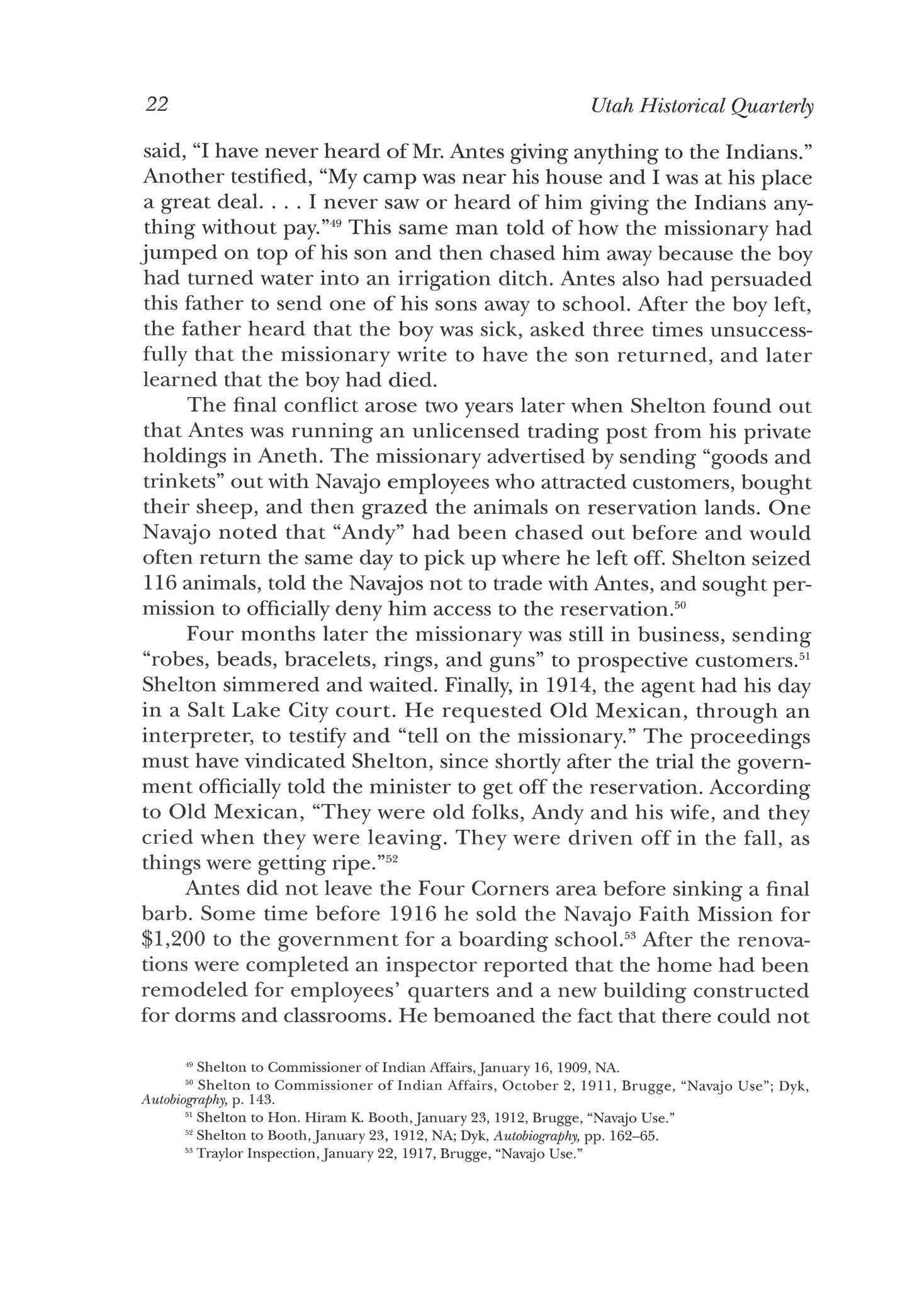
The final conflict arose two years later when Shelton found out that Antes was running an unlicensed trading post from his private holdings in Aneth. The missionary advertised by sending "goods and trinkets" out with Navajo employees who attracted customers, bought their sheep, and then grazed the animals on reservation lands. One Navajo noted that "Andy" had been chased out before and would often return the same day to pick up where he left off Shelton seized 116 animals, told the Navajos not to trade with Antes, and sought permission to officially deny him access to the reservation.50
Four months later the missionary was still in business, sending "robes, beads, bracelets, rings, and guns" to prospective customers.51 Shelton simmered and waited. Finally, in 1914, the agent had his day in a Salt Lake City court. He requested Old Mexican, through an interpreter, to testify and "tell on the missionary." The proceedings must have vindicated Shelton, since shortly after the trial the government officially told the minister to get off the reservation According to Old Mexican, "They were old folks, Andy and his wife, and they cried when they were leaving. They were driven off in the fall, as things were getting ripe."52
Antes did not leave the Four Corners area before sinking a final barb. Some time before 1916 he sold the Navajo Faith Mission for $1,200 to the government for a boarding school.53 After the renovations were completed an inspector reported that the home had been remodeled for employees' quarters and a new building constructed for dorms and classrooms. He bemoaned the fact that there could not
49 Shelton to Commissioner of Indian Affairs, January 16, 1909, NA.
50 Shelton to Commissioner of Indian Affairs, October 2, 1911, Brugge, "Navajo Use"; Dyk, Autobiography, p 143
51 Shelton to Hon Hiram K Booth, January 23, 1912, Brugge, "Navajo Use."
62 Shelton to Booth, January 23, 1912, NA; Dyk, Autobiography, pp 162-65
53 Traylor Inspection, January 22, 1917, Brugge, "Navajo Use."
22 Utah Historical Quarterly
The Navajo Faith Mission
be "a worse site selected for a school at Aneth" since all of the land that had been there a few years ago was now washed down the river Without riprapping along the riverbank, the inspector believed, the buildings would be swept away. 54 That isjust what happened in 1919.55
Why had the government purchased this dubious site? The inspector thought that even though the land was highly undesirable, Shelton had purchased it because he and others feared Antes would return to the reservation, using his property as an excuse They "sacrificed much" to prevent his return. The inspector ended his report by unwittingly testifying about the Antes-Shelton struggle: "If I wanted revenge upon anyone, I would secure employment for them in the government school at Aneth, Utah."56 Antes's crusade had ended.
According to family tradition, Shelton's legal suits forced the Anteses to sell their orchard and farm in McElmo Canyon to pay for damages. They later were "escorted for their safety" as they traveled by wagon to Gallup, New Mexico, where they boarded a train for Arizona. A short while later they went to Owens Valley and then to Pomona, California, where they spent their last years. 57 Howard died in 1928 at the age of seventy-eight.
In summarizing the accomplishments of the Anteses and the Navajo Faith Mission, one is confronted with a seeming dichotomy
The fervor that was so apparent in the early stages of the mission seemed to cool or at least become clouded over the years. No doubt the conflicts with Agent Shelton brought out the worst in both parties. The written record left by the government paints a picture of a missionary whose questionable activities were self-centered at best.
On the other hand, recent conversations and correspondence with family members and acquaintances tell of a man who sacrificed his all to help the Navajos, while at the same time excoriating the character and activities of Shelton. In fairness to this point of view, one must note that Shelton was investigated for questionable activities at the Shiprock Agency in 1916 and, though exonerated, departed under less than favorable conditions
What of the successes? Undoubtedly the major contribution of the Anteses lies in the establishment of part of the Navajo Reservation north of the San Juan River Today that area is still producing large
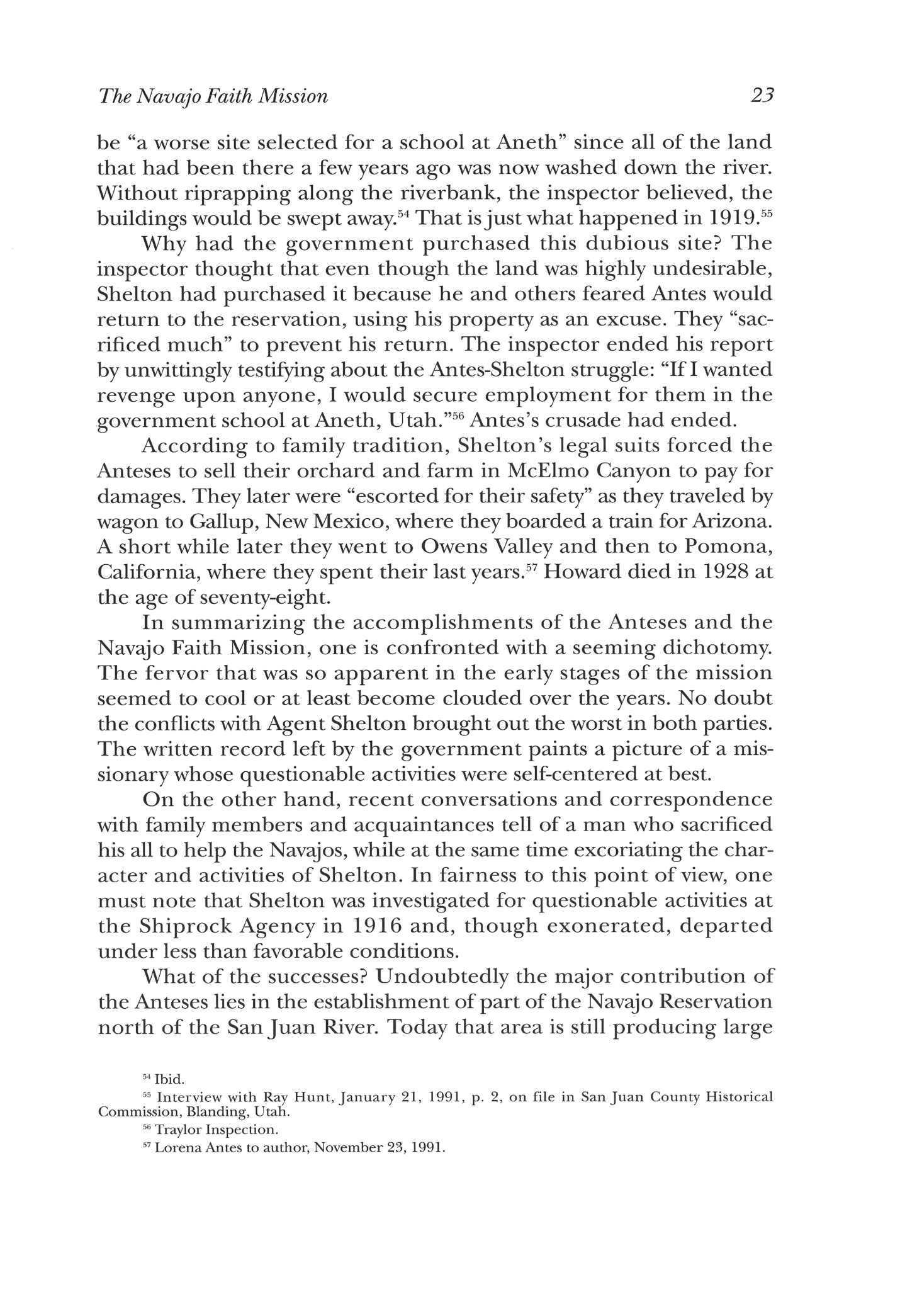
23
54 Ibid 55 Interview with Ray Hunt, Januar y 21, 1991, p 2, on file in San Jua n County Historical Commission, Blanding, Utah 56 Traylor Inspection 57 Lorena Antes to author, November 23, 1991
quantities of oil and holds the largest single population of Navajos on the LTtah portion of the reservation. Certainly another accomplishment was Antes's role as an Indian advocate against the livestock interests in the Four Corners region. Although his stance was not popular, it helped clarify the use-relationship between federal and local control of the public domain. As usual, Antes was not afraid to take pen in hand to let others—from the local agent to the president of the United States—know about things he felt needed to be corrected.

Probably his greatest personal success, yet the one least important to the rest of the world, was his mission to the Navajos. During his last days he bemoaned the fact that he had not been able to do more for the Indians One night, shortly before he died, his son Samuel came home and knelt at his father's bed and told him that he had been converted and would become a preacher. "Mr. Antes closed his eyes and said, 'Now I am ready to go.'"58
Samuel attended the Bible Institute of Los Angeles, majored in music, and became an accomplished violinist. He served as a local preacher, assistant pastor, and youth leader. On occasion during revival meetings or evangelistic conferences he would share his life history, which he entitled "From Sagebrush to the Pulpit." It became a popular recounting of the power of faith and an example of success against difficult odds.59 He died in 1983, never having abandoned his religious conviction and serving as a testament of at least one lasting conversion his father had made.
Today, there is no trace of the Navajo Faith Mission The waters of the San Juan River roll over what was once productive farm lands and orchards as it meanders its way to Lake Powell. Sheep and goats graze along the riverbank, nearby oil wells pump their black gold destined to eventually go to Texas, and the black ribbon of highway that follows the northern edge of the flood plain allows motorists easy access to what was once an isolated desert region. Indeed, for a person who does not know the history of the area, it appears as if there have been only recent developments But 100 years ago a missionary couple filled with nineteenth-century dreams of progress came to help the Navajos What is there now reflects a century of growth and development undreamed of by the Anteses. They did, however, leave a name—Aneth—the Answer.
24 Utah Historical Quarterly
Ibid
Lorena Antes interviewed by Corinne Roring,June 27, 1992, transcript in possession of author
The Sensational Murder of James R. Hay and Trial of Peter Mortensen
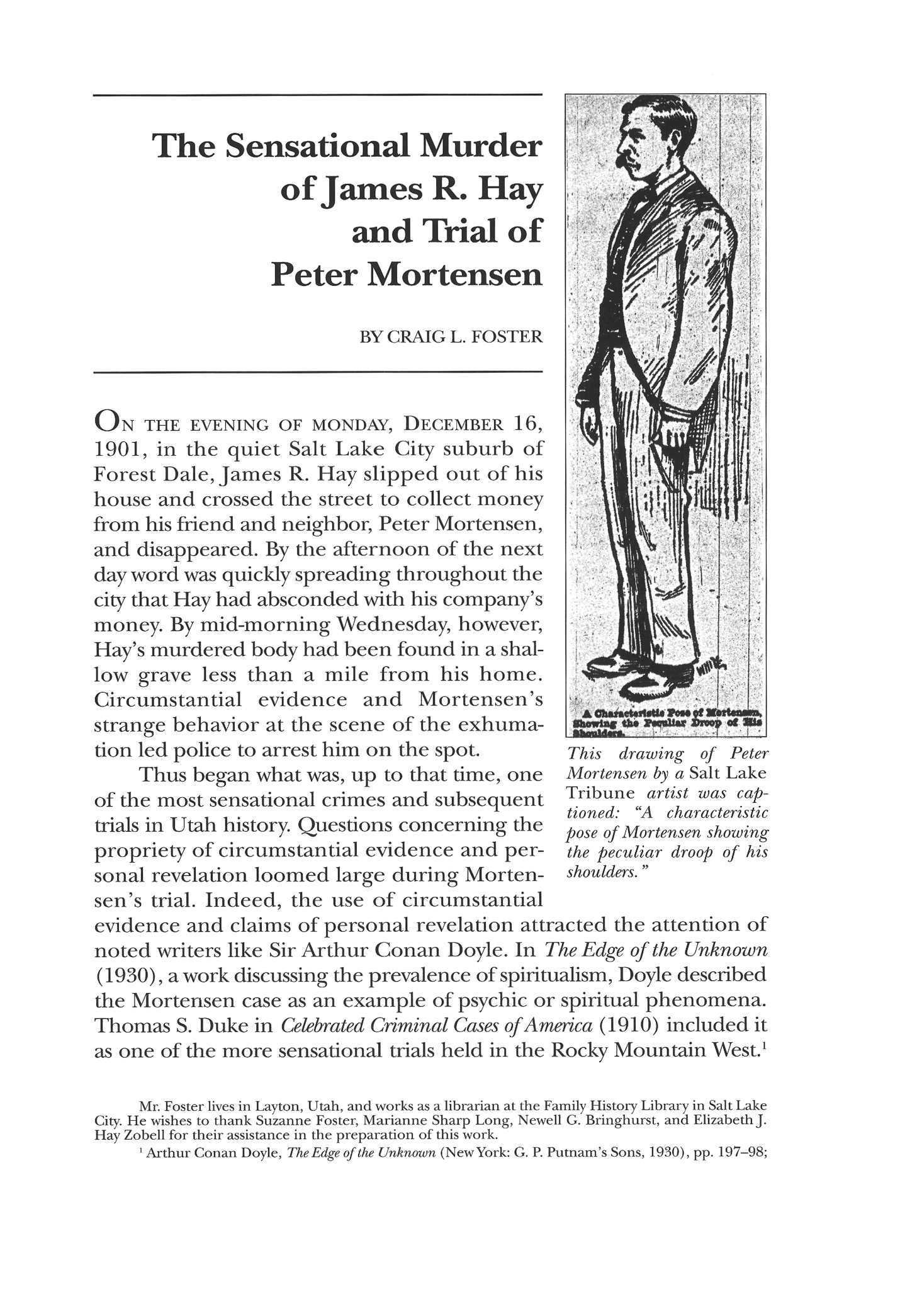 BY CRAIG L. FOSTER
BY CRAIG L. FOSTER
O N THE EVENING OF MONDAY, DECEMBER 16, 1901, in the quiet Salt Lake City suburb of Forest Dale, James R. Hay slipped out of his house and crossed the street to collect money from his friend and neighbor, Peter Mortensen, and disappeared. By the afternoon of the next day word was quickly spreading throughout the city that Hay had absconded with his company's money. By mid-morning Wednesday, however, Hay's murdered body had been found in a shallow grave less than a mile from his home Circumstantial evidence and Mortensen's strange behavior at the scene of the exhumation led police to arrest him on the spot. Thus began what was, up to that time, one of the most sensational crimes and subsequent trials in Utah history. Questions concerning the propriety of circumstantial evidence and personal revelation loomed large during Mortensen's trial Indeed, the use of circumstantial evidence and claims of personal revelation attracted the attention of noted writers like Sir Arthur Conan Doyle. In The Edge of the Unknown (1930), awork discussing the prevalence of spiritualism, Doyle described the Mortensen case as an example of psychic or spiritual phenomena. Thomas S. Duke in Celebrated Criminal Cases ofAmerica (1910) included it as one of the more sensational trials held in the Rocky Mountain West.1
7* •« . • '"-' afr•'•'•' rw ,: '•••" :>* Kb ' .% 3w'".- i ••'• j&mki IWM^im\ mi •I *I '/I E l * *'Y •JTW/I if : -• 1 (I Ii IE 1 •mil I W$ I 1 • '• AW* ^ 1 it JiW $£ll£pmm^ . V .<;', ' - '.' i ; fi1 i :-:; /.;;
77m drawing of Peter Mortensen by a Salt Lake Tribune artist was captioned: "A characteristic pose of Mortensen showing the peculiar droop of his shoulders."
Mr Foster lives in Layton, Utah, and works as a librarian at the Family History Library in Salt Lake City He wishes to thank Suzanne Foster, Marianne Sharp Long, Newell G Bringhurst, and Elizabeth J Hay Zobell for their assistance in the preparation of this work
1 Arthur Conan Doyle, The Edge of the Unknown (New York: G P Putnam's Sons, 1930), pp 197-98;
On a personal side, the Hay murder was a tragedy that greatly affected a number of lives The murder of ayoung, respectable man by afriend and neighbor shocked the city. More tragically, it shattered the lives of those intimately associated with both Hay and Mortensen.
James Robert Hay was born in 1869 in Maryborough, Victoria, Australia.Jimmy, as he was commonly known, was of Scottish stock, his parents having immigrated to Australia from their native Scotland.2 By the mid-1880s members of the Hay family had settled in Timaru, New Zealand, where they were baptized into the Church ofJesus Christ of Latter-day Saints. Following the death of Hay's father the remaining family members immigrated to Salt Lake City, residing in the Twentieth Ward Jimmy Hay obtained work as a clerk in ZCMI and through his ward activities met Aggie Sharp. In 1896 they were married in the Salt Lake Temple.3
Hay had clearly married above his social class.Aggie Sharp, born in 1876 toJames Sharp and Lizzie Rogers, came from an extremely prominent family both in terms of wealth and social status She was a granddaughter of BishopJohn Sharp of the Twentieth Ward who had been a personal friend and confidant of Brigham Young as well as a canny businessman who had helped found ZCMI, Deseret National Bank, and several railroads. Aggie's father, James Sharp, was equally impressive He had been closely associated with his father in railroading and banking and was, in 1901,president of Deseret National Bank and had an interest in several Utah railroads including the Oregon Short Line He was a former Speaker of the House in Utah's territorial legislature and a former mayor of Salt Lake City. In addition, he was a member of the LDS Board of Education and of the University of Utah's Board of Regents.
Like his father-in-law, Hay was an enterprising, hardworking man seeking financial independence. In 1891 he had left ZCMI and
Thomas S Duke, Celebrated Criminal Cases of America (San Francisco: James H Barry Co., 1910), pp 327-32. Interestingly, the Hay-Mortensen case in Duke's work followed an entry concerning another celebrated Mormon criminal case, the Mountain Meadows Massacre and Philip Klingonsmith's damning testimony against John D Lee L Kay Gillespie also discussed the case in The Unforgiven: Utah's Executed Men (Salt Lake City: Signature Books, 1991)
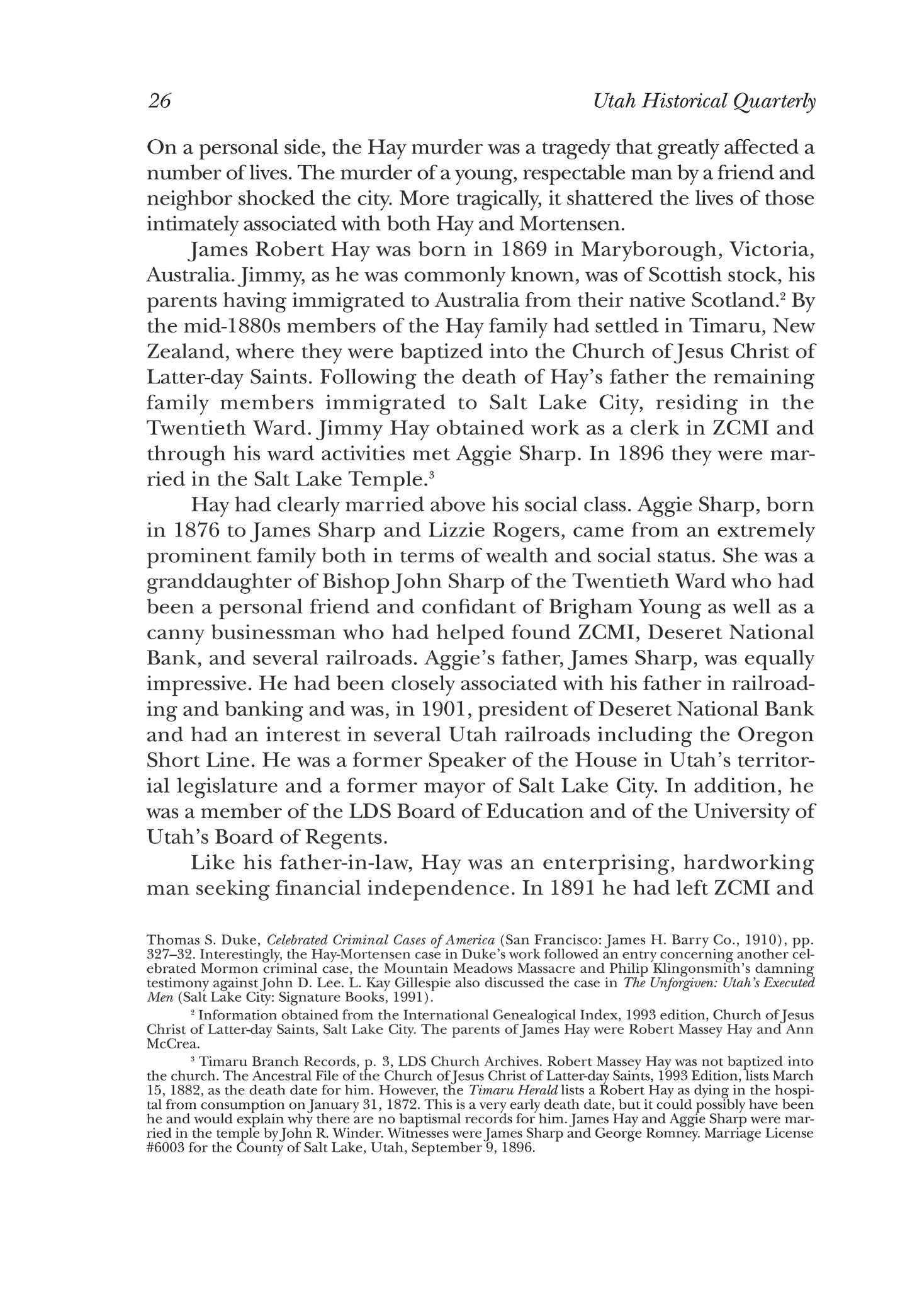
2 Information obtained from the International Genealogical Index, 1993 edition, Church of Jesus Christ of Latter-day Saints, Salt Lake City The parents of James Hay were Robert Massey Hay and Ann McCrea
3 Timaru Branch Records, p 3, LDS Church Archives Robert Massey Hay was not baptized into the church The Ancestral File of the Church ofJesus Christ of Latter-day Saints, 1993 Edition, lists March 15, 1882, as the death date for him. However, the Timaru Heraldlists a Robert Hay as dying in the hospital from consumption on January 31, 1872 This is a very early death date, but it could possibly have been he and would explain why there are no baptismal records for him James Hay and Aggie Sharp were married in the temple byJohn R Winder Witnesses were James Sharp and George Romney Marriage License #6003 for the County of Salt Lake, Utah, September 9, 1896
26 Utah Historical Quarterly
entered into a limited partnership with brothers George Ernest and William S. Romney to form the Pacific Lumber Company. By 1900 the well-known financier David Eccles had joined the firm as a director and president. Hay was a director and secretary of the company. 4 At about that time, Hay, his wife Aggie, and their two young children moved into a home in Forest Dale in what was obviously a significant step in the young couple's upward climb toward social and financial comfort and respectability. 5 There, Hay met Peter Mortensen.
Some three years older than Hay, Mortensen had been born in 1865 in Richfield, Sevier County, Utah, to Danish Mormon settlers who had experienced much hardship in their youth. Their struggle continued into Peter's childhood as his father moved the family to several towns in search of carpentry work Eventually the Mortensens settled in Ogden near a large English family by the name of Watkins.6
In 1891 Peter Mortensen married his twenty-five-year-old neighbor, Ruth Elizabeth Watkins, in the Logan LDS Temple. He followed his father into the carpentry business in Ogden. In 1897 Mortensen moved his young family to Forest Dale and took ajob at the Pacific Lumber Company By 1898 or 1899 he had decided to strike out on his own as an architect/contractor/carpenter. 7 By 1901 he was a recognized builder in the greater Salt Lake City area He was the father of five children and a teacher of theology in the Forest Dale Ward's Sunday School. In that position he came into frequent and friendly
4 According to the Articles of Incorporation for the Pacific Lumber Company, Utah State Archives, Salt Lake City, the original founders and officers were George Ernest Romney, William S. Romney, James R Hay, and Joseph E.Jensen In 1900 the company was re-incorporated with David Eccles as director and president, Ernest Romney as director and vice-president, James Hay as director and secretary, and Joseph E.Jensen and William S Romnev as directors Eccles held 150 shares of stock valued at $15,000, Ernest Romney 147 shares valued at $14,700, and the other three men one share each valued at $100 Unfortunately, the company suffered from economic problems and in 1911 had its charter of incorporation revoked for failure to pay taxes George Ernest Romney (1868-1940), a close friend of Hay, was the son of Bishop George Romney and Jan e Jamison and lived in the Twentieth Ward Bishop Romney was involved in several business ventures with Eccles, including the Oregon and Mount Hood Lumber companies and Home Fire Insurance of which James Sharp was vice-president.
5 According to AndrewJenson, Encyclopedic History of the Church ofJesus Christ of Latter-day Saints (Salt Lake City: Deseret News Publishing Co., 1941), pp 253-54, Forest Dale was a small community located on land that was originally part of Brigham Young's Forest Farm and later subdivided into individual home sites that attracted young families In 1896 the Forest Dale Ward was created
6 Monroe Ward Records, p 3, LDS Church Archives; U.S Census of 1880 for the Territory of Utah, Sevier County, Monroe Precinct, p 30; and Ogde n Fourth Ward Records, LDS Church Archives
According to information obtained from the International Genealogical Index, 1993 edition, and the Ancestral File, Charles Frederick Watkins was born and raised in Somersetshire, England He met his London-born wife, Elizabeth Mary Loud, in 1852 They eventually became the parents of eleven children, the last one born in Ogden where they settled after immigrating to America in the late 1870s
7 Logan Temple Record, Book A, p 298, and Forest Dale Ward Record, LDS Church Archives
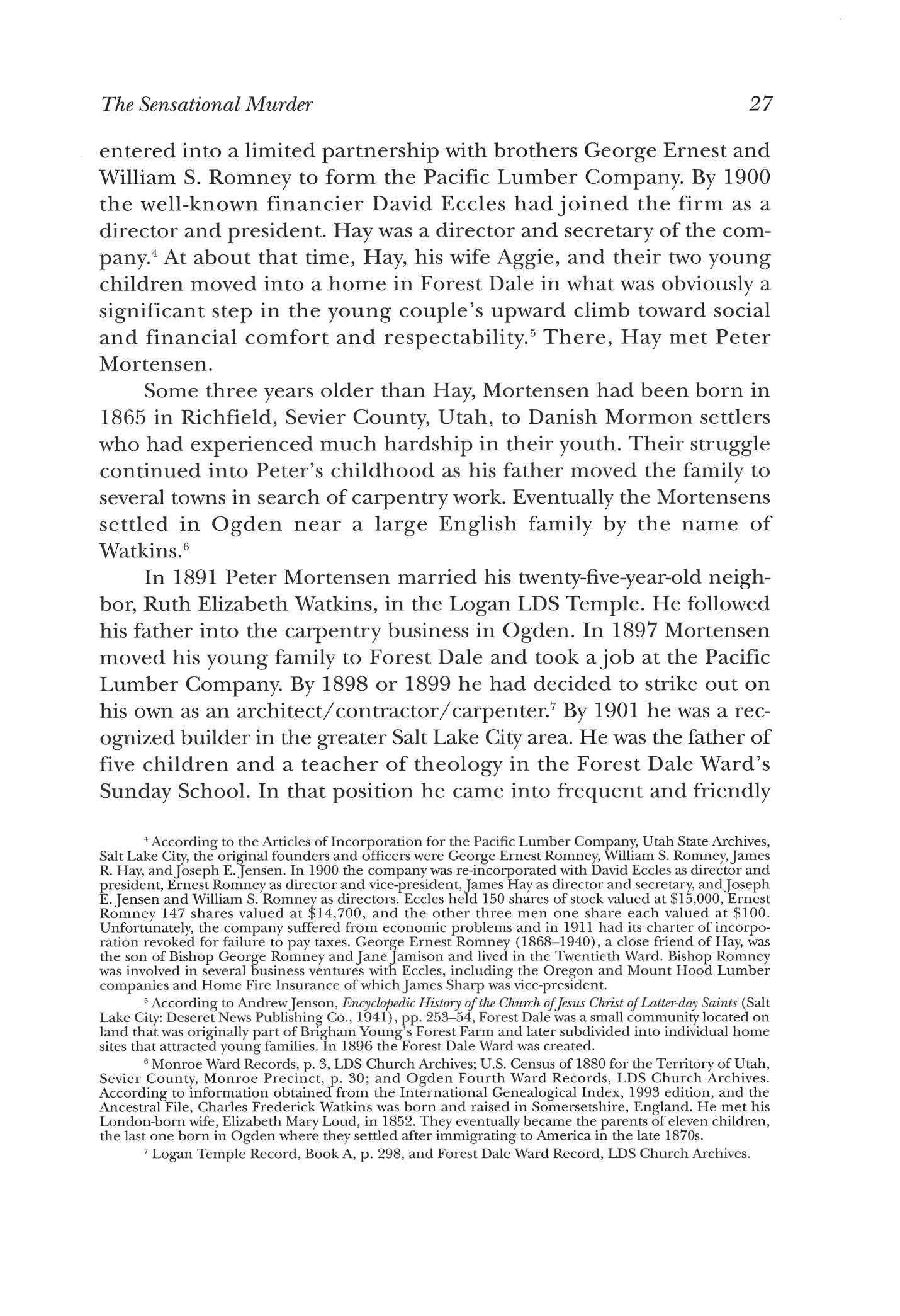
The Sensational Murder 2 7
contact with his neighbor, Jimmy Hay, who was also actively involved with Forest Dale's Sunday School.8
Although Mortensen was enjoying social stability, he was not having much success financially. Poor business practices had led him to overextend his credit He continued to get building contracts, but when clients were slow to pay for his services he in turn kept his former employer and supplier, Pacific Lumber Company, waiting for payments. In 1900 Mortensen had been forced to take out a second mortgage on his home and to turn over the mortgage note to Ernest Romney of Pacific Lumber. By December 1901 Mortensen owed the lumber company over $3,900. Both Hay and Romney pressured him to pay off his debt. Finally, on December 16, he arrived at the lumber company's office and informed both Hay and Romney that he could pay $3,800 of what he owed. Although he did not have the money with him—it was at his house—he nevertheless asked Hay to fill out a receipt and attach the mortgage note, which Hay did. As the men were preparing to leave the office, Romney specifically told Hay not to collect the money that night as it would be risky to carry so much gold at night. He told him to get it from Mortensen in the morning. Both Hay and Mortensen then took the Calder's Park tram home, arriving a little after 8:00 P.M It is not known what the two men said on the tram, but by the time they arrived in Forest Dale, Hay had agreed to collect the money that evening.
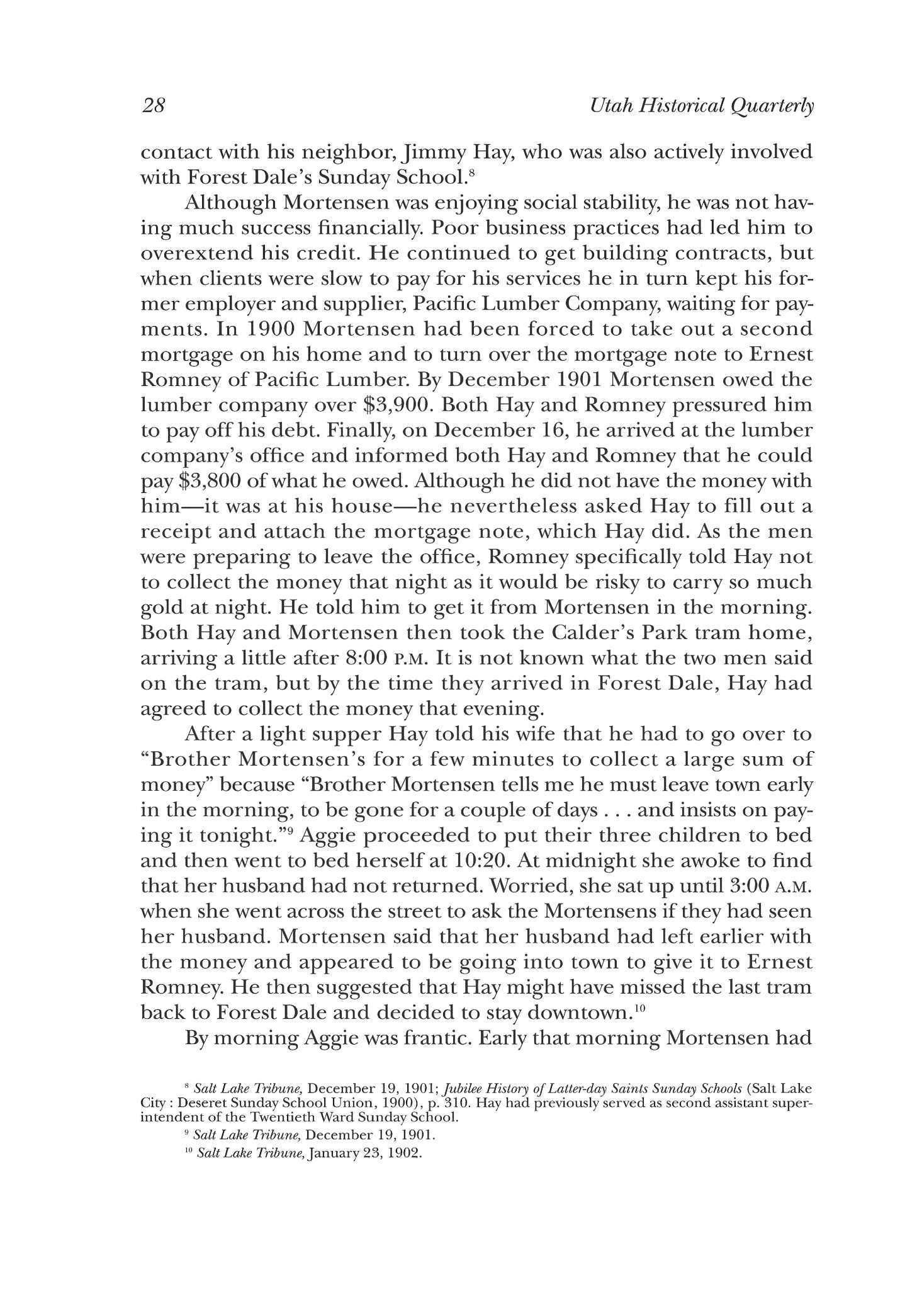
After a light supper Hay told his wife that he had to go over to "Brother Mortensen's for a few minutes to collect a large sum of money" because "Brother Mortensen tells me he must leave town early in the morning, to be gone for a couple of days . . . and insists on paying it tonight."9 Aggie proceeded to put their three children to bed and then went to bed herself at 10:20. At midnight she awoke to find that her husband had not returned. Worried, she sat up until 3:00 A.M. when she went across the street to ask the Mortensens if they had seen her husband. Mortensen said that her husband had left earlier with the money and appeared to be going into town to give it to Ernest Romney. He then suggested that Hay might have missed the last tram back to Forest Dale and decided to stay downtown.10
By morning Aggie was frantic. Early that morning Mortensen had
8 Salt Lake Tribune, December 19, 1901;
Sunday School Union, 1900),
9 Salt Lake Tribune, December 19, 1901
10 Salt Lake Tribune, January 23, 1902.
28 Utah Historical Quarterly
Jubilee History of Latter-day Saints Sunday Schools (Salt Lake City : Deseret
p 310 Hay had previously served as second assistant superintendent of the Twentieth Ward Sunday School
called on her to ask if Hay had returned When informed that he had not, Mortensen took the tram into town and met with Ernest Romney. By mid-morning both Mortensen and Romney had contacted Jimmy's father-inlaw,James Sharp, at his office in the Deseret National Bank to inform him that Hay had disappeared with $3,800. Sharp told the men to contact the police while he went to his daughter's house. Although he found Aggie in a state of panic, he took time to call on Ruth Mortensen across the street and was shown the mortgage note as evidence that Hay had received money from her husband. Sharp took the note and then escorted his daughter and her children to his own home in the center of the city.11
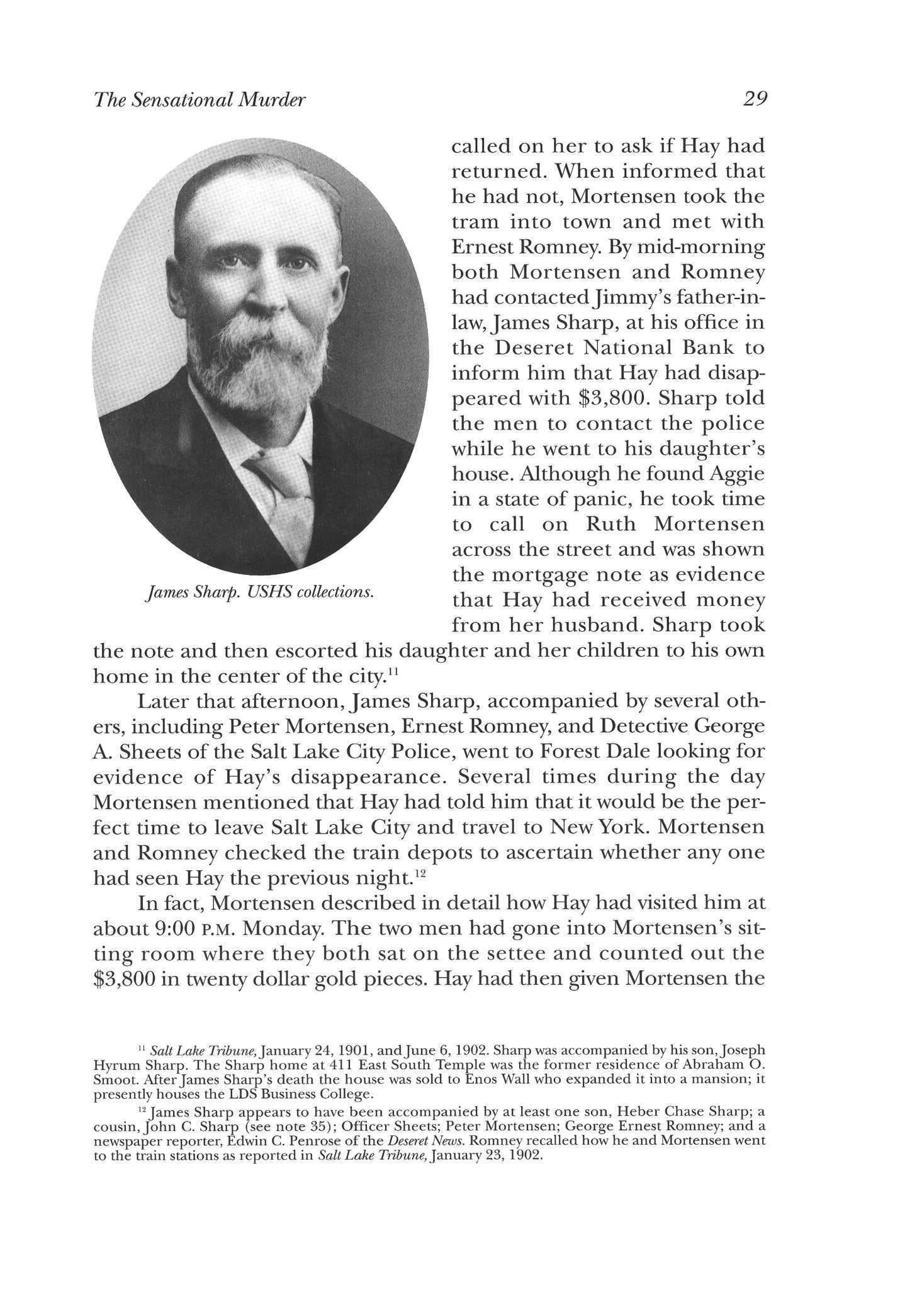
Later that afternoon, James Sharp, accompanied by several others, including Peter Mortensen, Ernest Romney, and Detective George A. Sheets of the Salt Lake City Police, went to Forest Dale looking for evidence of Hay's disappearance. Several times during the day Mortensen mentioned that Hay had told him that it would be the perfect time to leave Salt Lake City and travel to New York Mortensen and Romney checked the train depots to ascertain whether any one had seen Hay the previous night.12
In fact, Mortensen described in detail how Hay had visited him at about 9:00 P.M Monday The two men had gone into Mortensen's sitting room where they both sat on the settee and counted out the $3,800 in twenty dollar gold pieces. Hay had then given Mortensen the
The Sensational Murder 29
fames Sharp. USHS collections.
11 Salt Lake Tribune, January 24, 1901, and June 6, 1902 Sharp was accompanied by his son, Joseph Hyrum Sharp The Sharp home at 411 East South Temple was the former residence of Abraham O Smoot After James Sharp's death the house was sold to Enos Wall who expanded it into a mansion; it presently houses the LDS Business College
12 James Sharp appears to have bee n accompanied by at least one son, Heber Chase Sharp; a cousin, Joh n C Sharp (see note 35); Officer Sheets; Peter Mortensen; George Ernest Romney; and a newspaper reporter, Edwin C Penrose of the Deseret News. Romney recalled how he and Mortensen went to the train stations as reported in Salt Lake Tribune, January 23, 1902
receipt and took the money, after which Mortensen saw Hay out the door.
At the Mortensen house, James Sharp, by then very distraught, confronted Mortensen and demanded to be shown exactly where Jimmy had last been seen. Mortensen, who was on his porch, pointed down the walk and said that it was about where Sharp was standing. Unsatisfied, Sharp insisted that he be shown the exact spot. Hesitantly, Mortensen left the porch and walked to a spot about ten feet from the porch and twenty feet from the gate. Sharp exclaimed that the spot on which they were standing was where his son-in-law had been killed and that Mortensen was responsible "How do you know he is dead?" Mortensen asked. Sharp responded, "The proof is that within twentyfour hours his body will be dug up in a field within a mile of this spot."13
By Wednesday morning there was still no trace ofJimmy Hay. Mortensen was about to catch a tram into town when he and Royal B. Young14 were told by a young woman that "a body" (actually, what appeared to be a hastily dug grave) had been found. The two men rushed to the place where Frank Torgersen had been looking for a loose horse and stumbled upon a trail of blood and a mound of freshly turned earth The shallow grave was close to the tracks of the Park City Branch of the Denver & Rio Grande Railway, between Fifth and Seventh East streets, about a half-mile from Peter Mortensen's home. There was a large quantity of blood on the tracks.

Torgerson asked Mortensen if he had a shovel, since his house was closest to the grave site. Mortensen replied that he did, specifically stating that the only shovel he had was a round nosed one After retrieving the shovel, Mortensen and several others watched while Torgersen dug. As dirt was removed, marks clearly showed that a square shovel had been used to dig the grave originally. Several of the small crowd noted the marks and footprints leading to and away from the grave. When the group realized that the body was indeed Hay's, they contacted the police. 1 5 As the police exhumed the body, Mortensen paced back and forth nervously and acted as if he wanted to leave the gruesome scene When he finally headed toward his home
13 Salt Lake Tribune, January 24, 1902, and Salt Lake Herald, January 24, 1902 Present at the time of Sharp's statement were Mortensen, Heber Sharp, George Romney, reporter Edwin Penrose, detective George Sheets, and at least one other police officer.
14
15 Salt Lake Tribune, December 19, 1901, and Deseret Evening News, December 18, 1901
30 Utah Historical Quarterly
Royal Barney Sagers Young (1851-1929) was the adopted son of Brigham Young He and at least two of his three wives resided in Forest Dale He was president, secretary, and treasurer of Young Brothers Company which dealt in music, musical merchandise, bicycles, and sewing machines
The Sensational Murder
a policeman stopped him about halfway there, and he was soon placed under arrest for the murder ofJimmy Hay.
Family, friends, and neighbors initially reacted to the arrest of Peter Mortensen with disbelief. Theodore Watkins, Peter's brother-in-law,

31
Three of the principal characters in the case as sketched by an artist for the Salt Lake Tribune.
stated, "If I believed Peter were guilty of this horrible crime I would not lift a finger to save him from the penalty, but I know he never did it, and I will spend every cent I possess, if necessary to prove his innocence."16
Another brother-in-law, Richard C. Watkins, stated that he believed Peter was innocent and would investigate on his own. He added that even had he believed Mortensen to be guilty, he would take his sister, Ruth Mortensen, to his home in Provo. Ruth, for her part, was on the verge of a nervous breakdown and had secluded herself from the public
In the days following Mortensen's arrest the police, aided by members of the Sharp family and neighbors like Royal B. Young, searched and re-searched the Mortensen property for evidence. Despite great activity, they found little One significant discovery, though, was a recently washed square-nosed shovel hidden in the back of the Mortensen stable.
Hay had been killed by a shot to the back of the head from a .38caliber pistol The lengthy search of the Mortensen property and surrounding streets and fields conducted by the police failed to turn up the gun or Hay's missing hat.17
There was also a flurry of activity on the part of Mortensen's lawyers. Barnard J. Stewart, a friend and neighbor, was retained to defend Mortensen. He and his brother, Charles B. Stewart, quickly acted to keep reporters away from Mortensen and tried to have him released from jail.18 Despite their efforts to lessen publicity about the crime, the event and the circumstances surrounding it seemed to take on a life of their own. Every day, including Christmas, stories about the case and how Mortensen was reacting to the pressure appeared in the newspapers One day the headlines would read: "Mortensen is Breaking Down," while the next day's paper would carry the news that
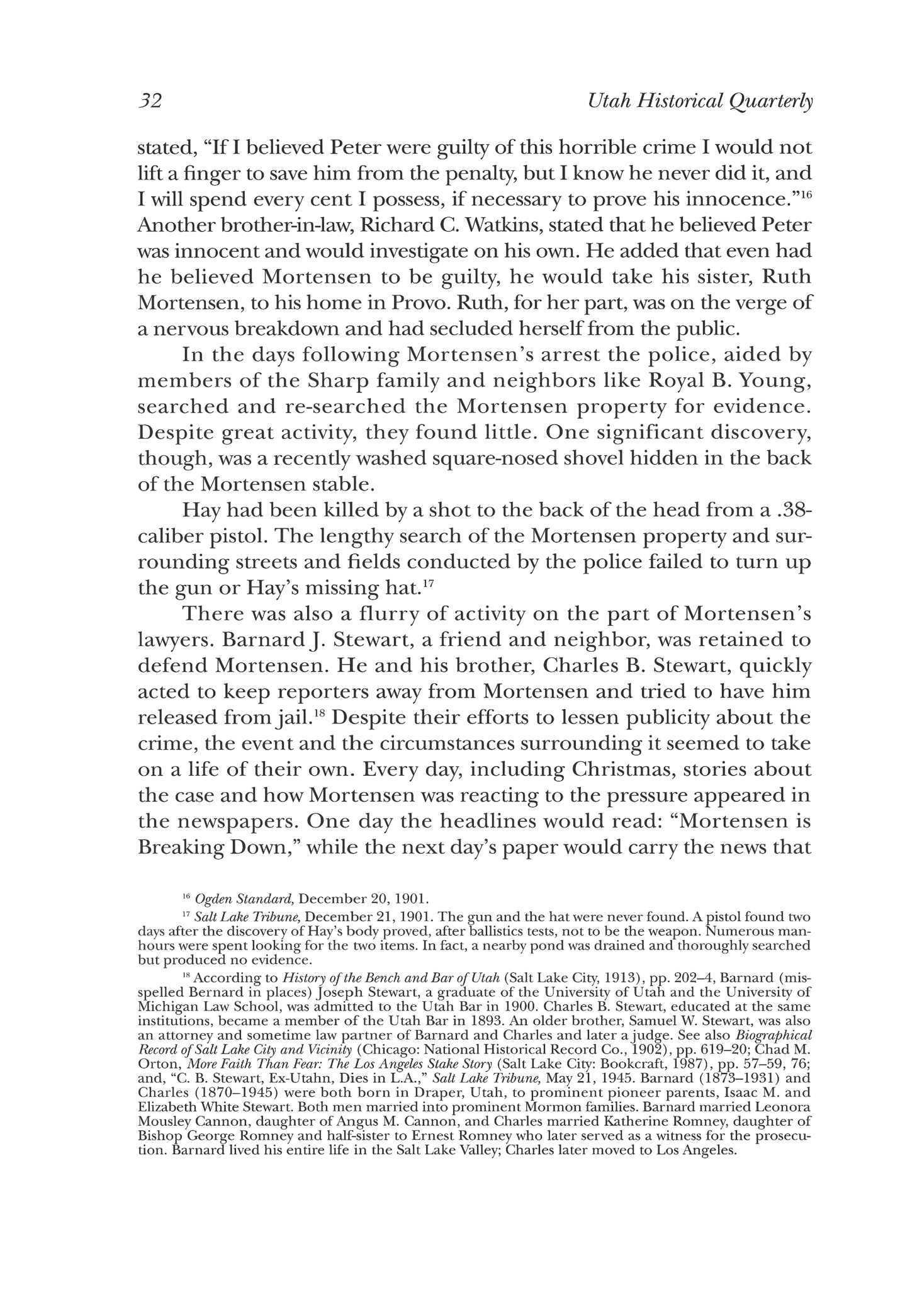
16 Ogden Standard, December 20, 1901
17 Salt Lake Tribune, December 21, 1901 The gun and the hat were never found A pistol found two days after the discovery of Hay's body proved, after ballistics tests, not to be the weapon Numerous manhours were spent looking for the two items. In fact, a nearby pond was drained and thoroughly searched but produced no evidence
1S According to History of the Bench and Bar of Utah (Salt Lake City, 1913), pp 202-4, Barnard (misspelled Bernard in places) Joseph Stewart, a graduate of the University of Utah and the University of Michigan Law School, was admitted to the Utah Bar in 1900 Charles B Stewart, educated at the same institutions, became a member of the Utah Bar in 1893 An older brother, Samuel W Stewart, was also an attorney and sometime law partner of Barnard and Charles and later a judge. See also Biographical Record of Salt Lake City and Vicinity (Chicago: National Historical Record Co., 1902), pp 619-20; Chad M Orton, More Faith Than Fear: The Los Angeles Stake Story (Salt Lake City: Bookcraft, 1987), pp 57-59, 76; and, "C B Stewart, Ex-Utahn, Dies in L.A.," Salt Lake Tribune, May 21, 1945 Barnard (1873-1931) and Charles (1870-1945) were both bor n in Draper, Utah, to prominent pioneer parents, Isaac M. and Elizabeth WTiite Stewart Both men married into prominent Mormon families Barnard married Leonora Mousley Cannon, daughter of Angus M Cannon, and Charles married Katherine Romney, daughter of Bishop George Romney and half-sister to Ernest Romney who later served as a witness for the prosecution Barnard lived his entire life in the Salt Lake Valley; Charles later moved to Los Angeles
32 Utah Historical Quarterly
he was "feeling better." That, added to announcements of new witnesses and new doubts created a circus-like atmosphere.19
At about the time that James Hay was being laid to rest, Ruth Mortensen left with her children and brother Richard for Provo. She did not visit her husband injail before she left. In fact, after his arrest she never again saw him. The newspapers had reported that she was on the verge of a nervous breakdown, at times bordering on uncontrollable hysteria Although she had originally defended her husband and offered him a reasonable alibi, by December 23 she had changed her story and, at the insistence of her brother, told the police what she knew.

According to Ruth, Hay had visited Mortensen on that fateful Monday night a little after 9:00 P.M. and, after about a half-hour, they had left the house together. In about twenty minutes Mortensen returned, breathless and red in the face. He told his sister-in-law, Henry's wife, who happened to be visiting, that if she wanted an escort back to her house, she had better hurry for he had "some work to do." He again left the house and was gone for about an hour.20 When Mortensen returned, his wife realized something was wrong, for he looked "simply ghastly" and appeared "so pale and . . .had a wild look in his eyes." She asked him what was wrong, but he refused to answer and went to bed where he pretended to sleep. After awhile, Ruth again asked what had happened and he again refused to answer. Later, when Aggie Hay came to the house and called out for Peter, he did not respond until, at Ruth's urging, he went and talked with her. After he had returned to bed, Ruth asked what he had done with Jimmy Hay. Peter became angry and said, "Don't you ever mention Hay's name to me again." When Ruth threatened to tell Aggie everything she knew, Peter said, "No you won't, even if you hear Hay is dead you must not say how long I was out last night."21 Although Ruth's testimony to the police was damaging, it was never used in court as it was
19 Deseret Evening News, December 21, 1901, and Salt Lake Tribune, December 23, 1901 As an example of the sensationalism produced by the press, a short article, "The Hoodoo House," in the Salt Lake Tribune, December 29, 1901, noted thatJames R. Hay had once lived in a house where two previous owners died tragically Hay, the newspaper opined, may have succumbed to the curse of that house The public displayed a morbid fascination with the crime also According to the Tribune, December 24, 1901, crowds of curious people were destroying the Mortensen property Hundreds had filed in and out of the Mortensen home and visited the burial site. The lawns and gardens had been trampled down by the numerous visitors, and some were bold enough to carry away tools and other personal household items as souvenirs Elizabeth Jane Hay Zobell in a telephone interview on November 14, 1994, said her mother told her that the tops of the picket fence around the yard were torn off by curiosity seekers as souvenirs of the victim's house
20 Salt Lake Tribune, December 24, 26, 1901; Ogden Standard, December 24, 26, 1901
21 Ogden Standard, December 26, 1901 After Ruth Mortensen told the police all she knew, she evidently felt as if a great weight had been taken from her Family members later reported that her nervousness had left her and that she was more cheerful
The Sensational Murder 33
contrary to the law for a spouse to testify against a mate without that person's prior consent.
While the evidence continued to mount against him, Peter strongly maintained his innocence. At one point he stated to the press, "There is no punishment too severe for the murderer of Hay" and went on to again emphatically state his innocence.
The preliminary hearing began on January 21, 1902, in the Salt Lake City and County Building. Over an hour before the hearing commenced, the corridors were blocked with people waiting to enter the courtroom. During the next few days the prosecution presented a number of witnesses, the defense none. Byfar the most intriguing and controversial event at the hearing was the testimony ofJames Sharp After describing his confrontation with Mortensen and the subsequent discovery of the body, Sharp was asked by the defense how he had known that Hay was dead the afternoon before his body was discovered. Sharp replied, "God revealed it to me."22 According to one reporter, the effect on Mortensen was devastating: "His head drooped, his eyes were half closed, and looked unseeingly into his lap; his chin quivered, the blood mounted to his neck, cheeks and forehead, coloring them a dull red He glanced up appealingly as a stricken animal looks at the hunter about to take its life. Then his eyes fell again, but the look of helpless anguish lingered on his face."23 Public reaction to Sharp's declaration was varied. The prosecuting attorney viewed it as "positive and splendid," while the defense emphasized that such testimony could "never be admitted in a court of law."24
The local clergy also reacted to Sharp's declaration. The Reverend J. L. Albitron of the First Methodist Church, in a sermon on the Sunday following the testimony, accused Sharp of fanaticism and "declared that such a statement could not stand either before the law nor as the gospel."25 Mormon leaders responded almost immediately to Sharp's declaration of personal revelation in at least two publications Probably the most critical reaction, penned by President Joseph F. Smith, and published in the Juvenile Instructor, an LDS magazine, read in part: Recently a man charged with murder of another man was examined before a committing magistrate in Salt Lake City The father-in-law of the murdered man, during the examination laid the crime at the door of the accused. In the cross-examination the attorney for the defendant
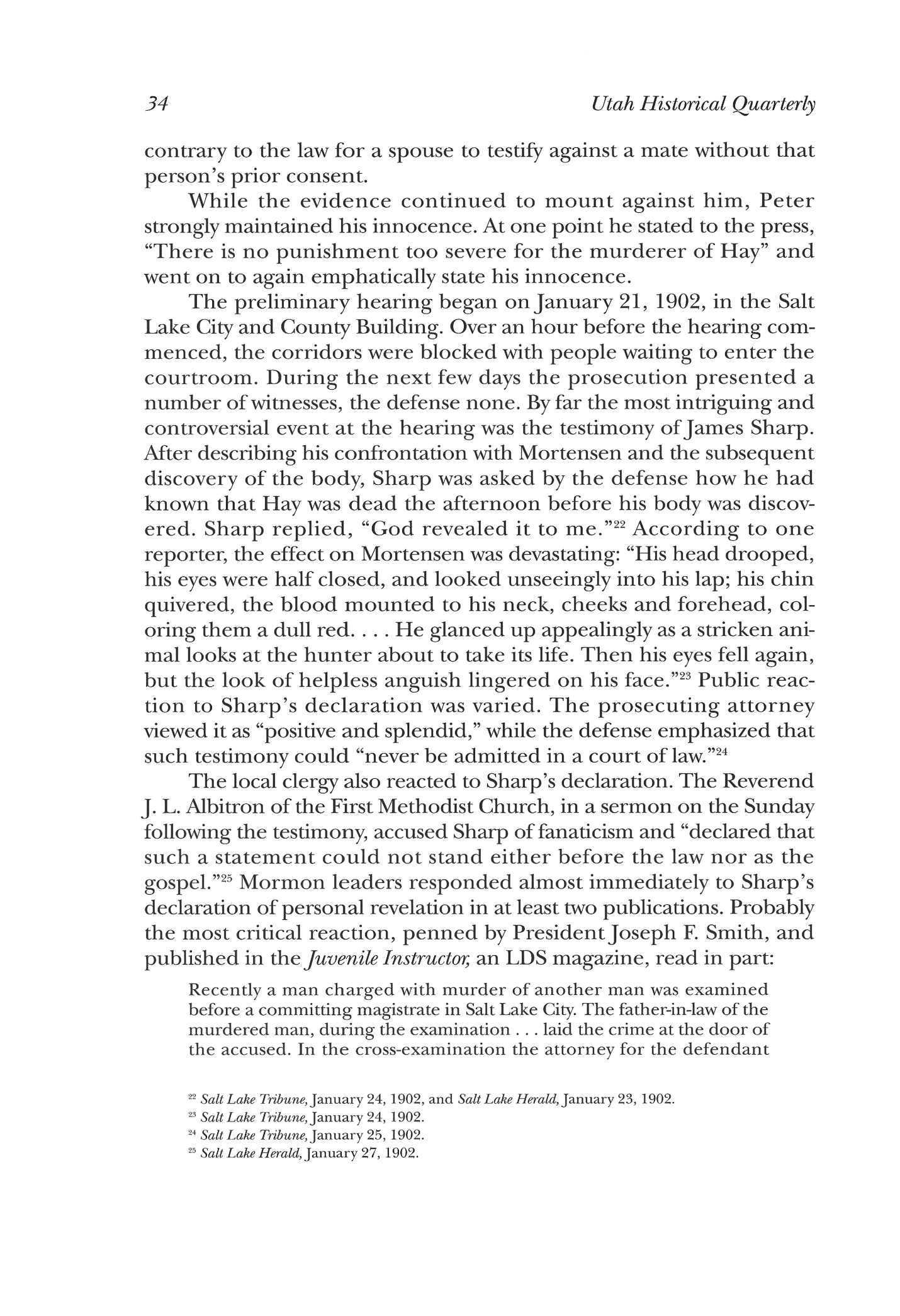
22 Salt Lake Tribune, January 24, 1902, and Salt Lake Herald, January 23, 1902
23 Salt Lake Tribune, January 24, 1902
24 Salt Lake Tribune, January 25, 1902
25 Salt Lake Herald, January 27, 1902
34 Utah Historical Quarterly
pressed the witness as to how he knew that the witness was guilty of the crime The reply, as given in the press, was, because God had revealed it to him. . . . No member of the Church ofJesus Christ of Latter-day Saints should, for one moment, regard such testimony as admissible in a court of law, and to make the case perfectly clear it may be further stated that such evidence would not be permissible even in a Church court, where rules of evidence, though not so technical, are founded largely upon the same principles that govern the rules of evidence in a court of law Any attempt, therefore, to make it appear that such evidence is in keeping with the tenets of the "Mormon" faith is wholly unjustified.26
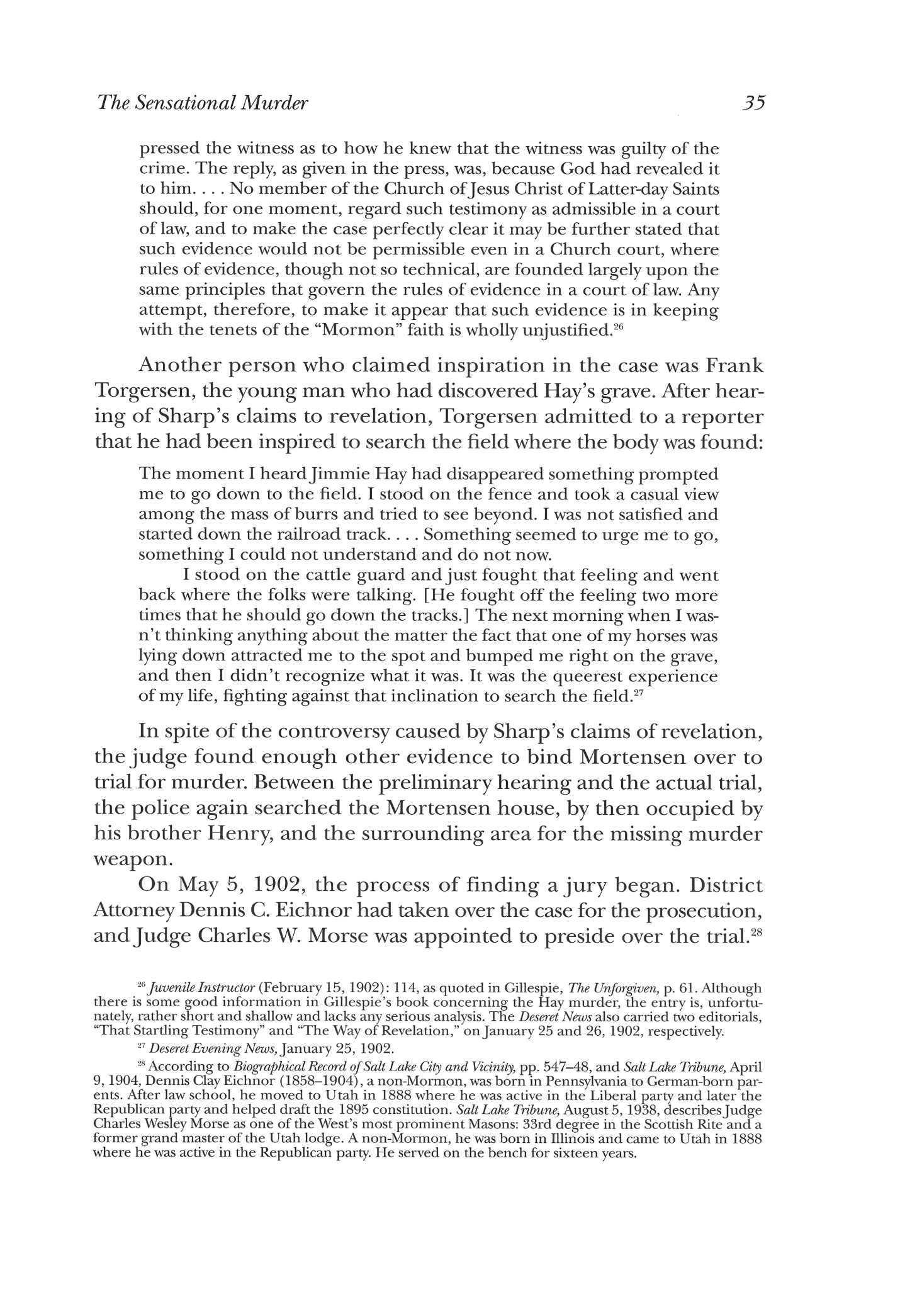
Another person who claimed inspiration in the case was Frank Torgersen, the young man who had discovered Hay's grave. After hearing of Sharp's claims to revelation, Torgersen admitted to a reporter that he had been inspired to search the field where the body was found: The moment I heard Jimmie Hay had disappeared something prompted me to go down to the field. I stood on the fence and took a casual view among the mass of burrs and tried to see beyond I was not satisfied and started down the railroad track Something seemed to urge me to go, something I could not understand and do not now.
I stood on the cattle guard and just fought that feeling and went back where the folks were talking. [He fought off the feeling two more times that he should go down the tracks.] The next morning when I wasn't thinking anything about the matter the fact that one of my horses was lying down attracted me to the spot and bumped me right on the grave, and then I didn't recognize what it was. It was the queerest experience of my life, fighting against that inclination to search the field.27
In spite of the controversy caused by Sharp's claims of revelation, the judge found enough other evidence to bind Mortensen over to trial for murder. Between the preliminary hearing and the actual trial, the police again searched the Mortensen house, by then occupied by his brother Henry, and the surrounding area for the missing murder weapon.
On May 5, 1902, the process of finding a jury began. District Attorney Dennis C. Eichnor had taken over the case for the prosecution, and Judge Charles W Morse was appointed to preside over the trial.28
26 Juvenile Instructor (February 15, 1902): 114, as quoted in Gillespie, The Unforgiven, p 61 Although there is some good information in Gillespie's book concerning the Hay murder, the entry is, unfortunately, rather short and shallow and lacks any serious analysis The Deseret News also carried two editorials, "That Startling Testimony" and "The Way of Revelation," on January 25 and 26, 1902, respectively
27 Deseret Evening News, January 25, 1902
28 According to Biographical Record of Salt Lake City and Vicinity, pp 547-48, and Salt Lake Tribune, April 9, 1904, Dennis Clay Eichnor (1858-1904), a non-Mormon, was born in Pennsylvania to German-born parents After law school, he moved to Utah in 1888 where he was active in the Liberal party and later the Republican party and helped draft the 1895 constitution Salt Lake Tribune, August 5, 1938, describes Judge Charles Wesley Morse as one of the West's most prominent Masons: 33rd degree in the Scottish Rite and a former grand master of the Utah lodge A non-Mormon, he was born in Illinois and came to Utah in where he was active in the Republican party He served on the bench for sixteen years
The Sensational Murder 35
Jury selection lasted almost three weeks, which was an enormous length of time at the turn of the century. The selection process proved controversial because of the religious undertones brought to the case by Sharp's assertions of personal revelation
Each potential juror was specifically asked about his personal belief in modern revelation, more specifically, if he believed that a person could receive personal revelation regarding the innocence or guilt of someone on trial for a crime such as murder. Potentialjurors were also specifically asked about Sharp's statements.29 Men who showed signs of believing the purported revelation or who refused to reveal their feelings on the subject were dismissed Eventually over a thousand men were called for jury duty before twelve were selected to serve
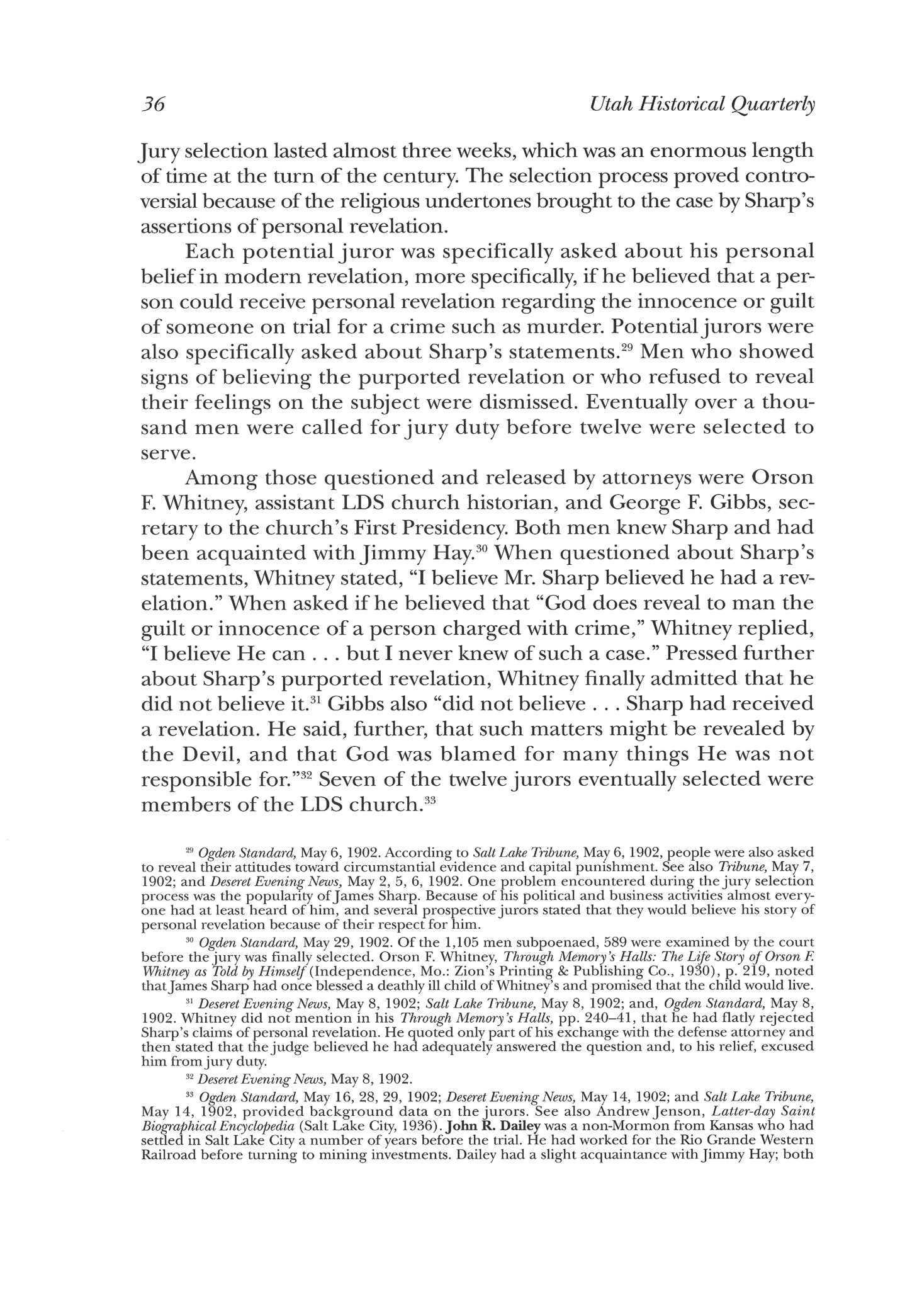
Among those questioned and released by attorneys were Orson F. Whitney, assistant LDS church historian, and George F. Gibbs, secretary to the church's First Presidency. Both men knew Sharp and had been acquainted with Jimmy Hay.30 When questioned about Sharp's statements, Whitney stated, "I believe Mr. Sharp believed he had a revelation." When asked if he believed that "God does reveal to man the guilt or innocence of a person charged with crime," Whitney replied, "I believe He can but I never knew of such a case." Pressed further about Sharp's purported revelation, Whitney finally admitted that he did not believe it.31 Gibbs also "did not believe . . . Sharp had received a revelation. He said, further, that such matters might be revealed by the Devil, and that God was blamed for many things He was not responsible for."32 Seven of the twelvejurors eventually selected were members of the LDS church.33
29 Ogden Standard, May 6, 1902 According to Salt Lake Tribune, May 6, 1902, people were also asked to reveal their attitudes toward circumstantial evidence and capital punishment See also Tribune, May 7, 1902; and Deseret Evening News, May 2, 5, 6, 1902 One problem encountered during the jury selection process was the popularity of James Sharp. Because of his political and business activities almost everyone had at least heard of him, and several prospective jurors stated that they would believe his story of personal revelation because of their respect for him
30 Ogden Standard, May 29, 1902 Of the 1,105 men subpoenaed, 589 were examined by the court before the jury was finally selected Orson F Whitney, Through Memory's Halls: The Life Story of Orson E Whitney as Told by Himself (Independence, Mo.: Zion's Printing & Publishing Co., 1930), p 219, noted that James Sharp had once blessed a deathly ill child of Whitney's and promised that the child would live
31 Deseret Evening News, May 8, 1902; Salt Lake Tribune, May 8, 1902; and, Ogden Standard, May 8, 1902 Whitney did not mention in his Through Memory's Halls, pp 240-41, that he had flatly rejected Sharp's claims of personal revelation He quoted only part of his exchange with the defense attorney and then stated that the judge believed he had adequately answered the question and, to his relief, excused him from jury duty
32 Deseret Evening News, May 8, 1902.
33 Ogden Standard, May 16, 28, 29, 1902; Deseret Evening News, May 14, 1902; and Salt Lake Tribune, May 14, 1902, provided backgroun d data on the jurors See also Andrew Jenson, Latter-day Saint Biographical Encyclopedia (Salt Lake City, 1936) John R. Dailey was a non-Mormon from Kansas who had settled in Salt Lake City a number of years before the trial He had worked for the Rio Grande Western Railroad before turning to mining investments Dailey had a slight acquaintance with Jimmy Hay; both
36 Utah Historical Quarterly
From the outset District Attorney Eichnor and the prosecution team faced the difficultjob of convincing thejury of Mortensen's guilt using only circumstantial evidence. Lacking both the murder weapon and an eyewitness to the crime, the prosecution aimed to weave a net of circumstantial evidence tight enough to convict the defendant.

Eichnor began the task with an opening statement wherein he described the events leading up to Hay's murder, including the financial woes of Peter Mortensen. He then described Hay's disappearance and Sharp's accusations against Mortensen. At that point Eichnor reminded thejury, "This is not a question of religion or revelation. We will prove it [that Mortensen killed Hay] by both Mormons and nonMormons."34 Eichnor stated emphatically that Mortensen did not have sufficient funds to pay his debt to Pacific Lumber Company and detailed his receipts and disbursements, including $200 he had received on the day of the murder from John C. Sharp, for whom he was building a house. At that time Mortensen had told him that he had enough money to pay his debt to the lumber company His accounts clearly showed otherwise.35
In building their case, the prosecution called a total of forty-one witnesses.36 Two of the most dramatic moments in the trial came when Hay's wife and father-in-law testified. Aggie Sharp Hay took the witness stand in "a courtroom packed to suffocation, yet as silent as a tomb." She described in quiet tones her husband's going to Mortensen's for
were investors in the Copper Boy Mining Company Joseph Smith, a merchant and a Mormon from Granger, was thirty-three at the time of the trial. Samuel Bringhurst, Jr. (1850-1936) came from a prominent Mormon family and was a farmer in the Taylorsville area H D Shurtliff, age sixty-one, was a farmer from Mill Creek and declared himself to not only be non-Mormon but agnostic He served as foreman of the jury James M. Barlow (1857-1917), a Mormon, was a salesman and clerk at Eldredge & Co in Salt Lake City. Sterling Le Roy, a forty-seven-year-old non-Mormon, worked for the railroad. Henry Tribe (1838-1909), another non-Mormon, had been born in England and later immigrated to America He was a manufacturer in Salt Lake City Michael Kopp, a forty-nine-year-old candy manufacturer, apparently associated with the Salt Lake Candy Company, identified himself as an agnostic and refused to take the traditional oath that mentioned God William A. Bills (1835-1915), at age sixty-seven the oldest member of the jury, was a farmer from South Jordan A Mormon pioneer of 1848 and a former bishop of the South Jordan Ward, he was a polygamist with five wives John T. Alexander, an English-born Mormon who came to Utah as a young child, was a forty-one-year-old sheepherder in Hunter Charles H. Ingham, Jr., thirty-six, was a sheep man and laborer from Salt Lake City and an active Mormon Alma Henry Rock, (1861-1943) born in Farmington, Davis County, to Mormon pioneer parents, had reportedly "drifted from his religious moorings." He was a farmer and merchant in West Jordan
34 Salt Lake Tribune, May 30, 1902
35 Deseret Evening News, May 29, 1902 Mortensen claimed to have received a total of $2,700 during December, including $2,100 from John C Sharp, and to have paid Hay with that money However, records showed that Mortensen had received only $1,546, including $1,000 from Sharp, and spent $1,485. John C Sharp (1850-1915?), who played an important peripheral role in the case, was a cousin ofJames Sharp According to Jenson, Latter-Day Saint Biographical Encyclopedia, 2:479-80, he was a bishop in Tooele for a number of years and a successful stock raiser in that area In 1890 he moved to Salt Lake City where he was involved in banking and other businesses as well as LDS church activities.
36 Third District Court Minutes, pp 286-333, Utah State Archives, Salt Lake City
Sensational Murder 37
The
the money and his subsequent disappearance The defense made no attempt to cross-examine her.37
Her performance on the witness stand was in stark contrast to that of her father James Sharp was described somewhat sensationally by one newspaper as "pouring forth the most bitter words, perhaps, that an accused man ever was compelled to listen to."38 He described the search for his missing son-in-law and his retrieval of the unsigned receipt from the Mortensen home, which he showed to his son, Heber, and to George E. Romney. He then told of his confrontation with Mortensen and the eventual discovery of the body. At the end of his testimony, defense attorney Barnard Stewart cross-examined After several questions and answers, Stewart asked Sharp how he had known that Mortensen had killed Hay:
After some hesitancy Mr Sharp said, "I told you once."
"Tell me again."
"God revealed it to me."
"How?"
"By the utterance of my mouth The words came from my mouth and I could not stop them I will not deny the word of God, neither here nor in the presence of God hereafter."
"Did God appear in person?"
"Go and ask him."
"Answer my question."
"Ask God."
[Judge Morse], "Answer the question Mr Sharp."
"He did not."
"How did he appear?"
"He appeared by the power of his spirit and told me "
"Is this, Mr Sharp, the only manifestation you have had with reference to this case?"
"No, sir."
"When did you have any other?"
"On Tuesday, at noon I saw in a vision the trail of blood leading across the track to the grave ,"39
Although Sharp's testimony was the most riveting of the trial, it was not the most damaging. Recognizing the controversial nature of Sharp's words, the prosecution sought to create a solid case that would not emphasize his accusations. With that in mind, they produced a
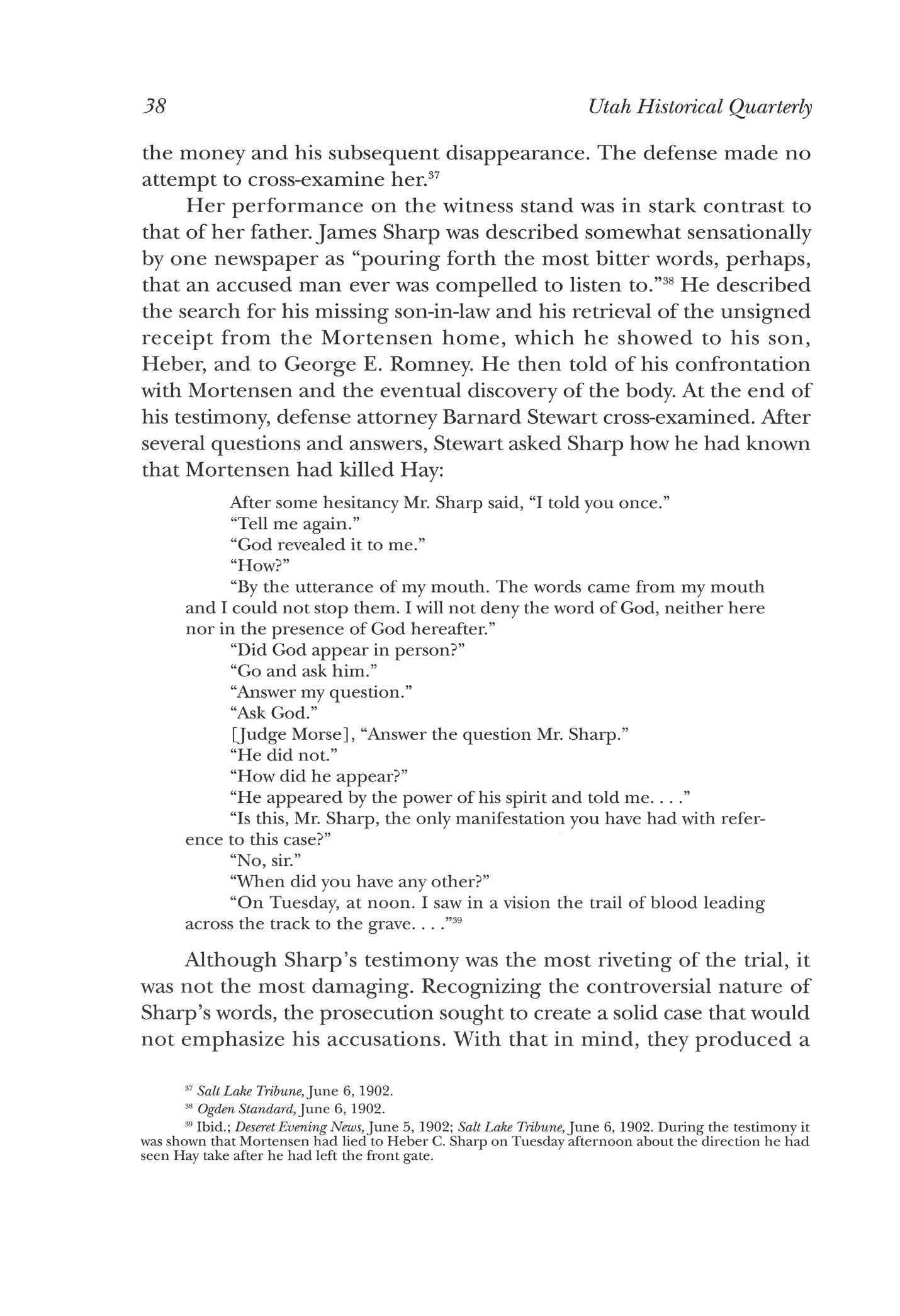
37 Salt Lake Tribune, June 6, 1902.
38 Ogden Standard, June 6, 1902
39 Ibid.; Deseret Evening News, June 5, 1902; Salt Lake Tribune, June 6, 1902 During the testimony it was shown that Mortensen had lied to Heber C. Sharp on Tuesday afternoon about the direction he had seen Hay take after he had left the front gate
38 Utah Historical Quarterly
parade of witnesses who provided bits of circumstantial evidence that, when combined, painted a dark picture, indeed, for the accused.
George A. Sheets, for example, testified that he had investigated the wall ledge in the basement where Mortensen had claimed to have kept the money injars. He had found dust all along the ledge and no signs ofjar prints He also verified that Sharp had promised the body would be found within twenty-four hours.John Allen, the motorman for the Calder's Park tram, testified that he had seen Mortensen walking along the Rio Grande Railroad tracks carrying a shovel at 10:20 on the evening of December 16. Another witness, Charles Watkins, stated that shortly after Mortensen's arrest he had asked him if he could show that he had paid Hay $3,800. Mortensen replied that he could but added, "My books are in such shape that it will be necessary for you to say you loaned me $1,000 or $1,500." Mortensen had suggested that Watkins alter his record books to make it look as though he had loaned Mortensen the money. Watkins refused to do so. 40
The prosecution did not depend on testimony alone. Eichnor also introduced material evidence such as the clothes Hay was wearing at the time of his murder and the gold watch found on his body. He also used courtroom demonstrations For example, he brought Mortensen's settee into court and showed that two grown men could not sit comfortably on the settee at the same time. The square-nosed shovel found hidden in the back of Mortensen's stable was also introduced as evidence. The shovel was clean, as if it had recently been washed.41
Near the end of his presentation Eichnor demonstrated to the court how much an ordinary quart fruit jar would hold in $20 gold pieces. Although Mortensen had claimed to have $3,800 in $20 gold pieces stored in three fruit jars, Eichnor easily placed $3,800 into one jar with about an inch and a half of space remaining. Mortensen was "visibly shocked," according to the newspaper Three jars filled with gold coins, as Mortensen had claimed, would have amounted to about $13,000.42
After the prosecution rested its case, the defense called four witnesses to refute motorman John Allen's testimony, but they were unable to impeach it. No other witnesses were called, and no evidence was introduced to explain some of the discrepancies in Mortensen's
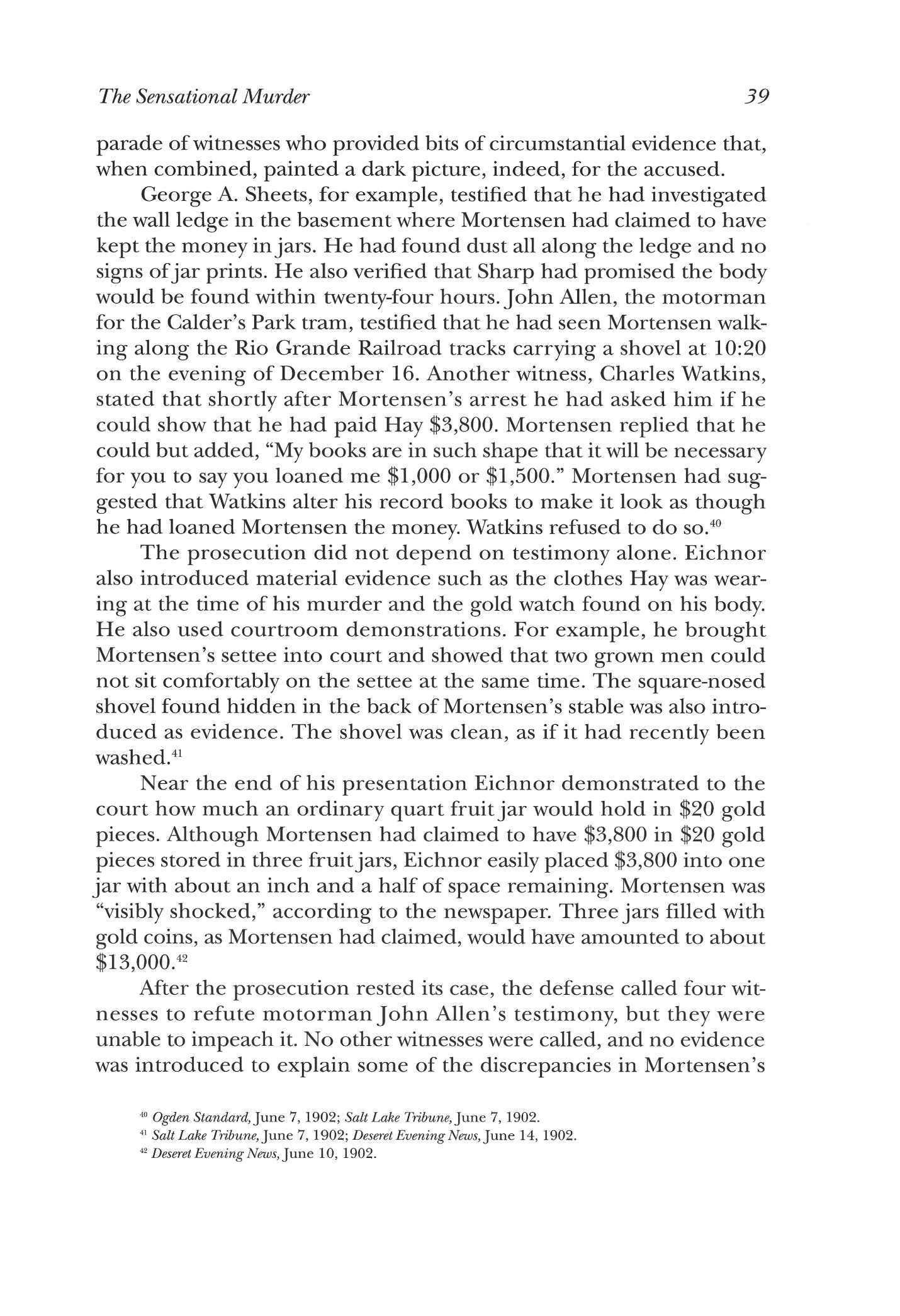
The Sensational Murder 39
40 Ogden Standard, June 7, 1902; Salt Lake Tribune, June 7, 1902 41 Salt Lake Tribune, June 7, 1902; Deseret Evening News, June 14, 1902 42 Deseret Evening News, June 10, 1902
A Salt Lake Tribune sketch of the crime scene: 1. Mortensen's house, 2. Hay's house, 3. "imprint in snow where body was probably thrown overfence," 4. blood stains on track, 5. grave, 6. "Chinaman Lee's house," 7. store. Note: 12th South is present 21st South.
story Most surprising to those in the courtroom was that Mortensen himself was not called to the witness stand It appears that the defense strategy was to punch holes in the prosecution's case and create enough doubt to produce a hung jury. After a total of fifty-five minutes the defense rested.43
The prosecution then moved to allow members of thejury to visit Forest Dale and the scene of the crime. The defense agreed, and Royal B. Young was appointed to be their guide. Accompanied by Young and four members of the police department, the jury visited the Mortensen home and cellar and then walked along the railroad tracks to the site of the grave. 44

The next morning Judge Morse told defense attorney Barnard Stewart that during the visit to Forest Dale, onejuror had measured the distance between several points discussed during the trial. Morse expressed concern that Mortensen had not been present when the jury visited the site and offered the defense the opportunity to make another trip with Mortensen and his attorneys present Surprisingly, Stewart said that he had no objection to what had occurred during the visit to Forest Dale. Eichnor then suggested that the court record the jury's visit to Mortensen's house and cellar. Stewart again raised no objection and waived the opportunity for a second visit to Forest Dale.45
In summing up the case, Eichnor argued before a packed courtroom that Mortensen had had both the motive and the opportunity
44 Ogden Standard, June 11, 1902; Salt Lake Tribune,
45 Deseret Evening News, Jun e 11, 1902
40 Utah Historical Quarterly Utt N > ii i miimm mm EBBZZg 4
»£<> f -\l^BtSWW«W» ,tamaan t umm
43 Third District Court Minutes, p 330 The defense called Royal B Young, Martin Fesler, James C Palmer, and Pearl Hill, but only three testified Salt Lake Tribune, June 11, 1902
June 11, 1902.
Barnard f. Stewart, left, and Charles B. Stewart, right. Bothfrom History of

and
to kill Hay. In response, both Barnard and Charles Stewart addressed the jury and passionately pleaded for the life of their client. During his two-hour discourse, Barnard Stewart attacked Mortensen's brothers-in-law, Theodore and Richard Watkins, who had testified for the prosecution: "Where in this world can you find a brother-in-law who would be so willing to brand the children of his sister with the brand of infamy which would rest upon the children of a murderer? There are those conscientious brothers-in-law! Would you believe such men?" His words concerning the children brought tears to Mortensen's eyes as, for the first time during the trial, he broke down and wept.46 Then, in a blistering attack that composed half of his speech, Barnard assailed the testimony ofJames Sharp as "an abuse of religion, a disgrace to the church, a mockery of God." He thundered:
Do you believe a man who will come into the most sacred temple of justice on the most solemn of solemn occasions when a man's life is hanging in the balance and tell you, that the great God of the universe, the God whom you worship and the God that I worship came down here and revealed either in person or in spirit the guilt of this defendant. . . .
I do not believe it In the words of one of the jurors, I believe that God that guides and controls this mighty universe has greater work than to communicate the guilt of this defendant toJames Sharp.47
Skillfully adding another dimension to his rebuttal of Sharp's testimony, Stewart explained that Sharp had "been beside himself" and
The Sensational Murder 41
the Bench
Bar of Utah
46 Deseret Evening News, June 13, 1902; Ogden Standard, June 13, 1902; Salt Lake Tribune, June 13, 1902
47 Ibid. The juror referred to was Joh n B. Dailey.
"lost in sorrow." Indeed, he had "laid awake at nights until his mind [was] mystified." Sharp was no doubt an honorable man, the attorney said, who "had made statements under wrong impressions," for, if his statements were not misguided but intended to influence the jury in order to convict Mortensen, then Sharp was "a man lost to honor." Stewart also reminded the jury that Sharp's statements "would be rejected in the councils of his own Church."48
For his part, Charles Stewart questioned the credibility of the circumstantial evidence and demanded, "Where is the gun? Where is the gun? Has anyone ever seen Peter Mortensen with a 38-caliber revolver? . . .There is not a word of testimony here to show that Peter Mortensen ever had such a gun."49
In his closing statement, Eichnor responded to questions concerning the gun and the circumstantial evidence To achieve his goal of creating a net strong enough to convict Mortensen, he listed what he termed fifty-five strong links of evidence. They began with Mortensen's failure to pay his debt to Pacific Lumber Company and ended with his attempts to have his two brothers-in-law state that they had loaned him the money. Eichnor sarcastically berated Barnard Stewart for bringing out Sharp's claims of revelation:

Now then, about the subject of revelation. Who brought it out? Mr. Barnard Stewart, that brave man who pictured himself to you as a hero, this great knight, this great Napoleon of the bar, told you how brave he was to bring it out. Now why did he bring it out? May it not have been for the purpose of prejudicing those members of the jury, who, perchance, do not believe in the principle of revelation. It matters not whether I believe in it.50
Eichnor explained that he had placed James Sharp on the witness stand in order to give his version of the search for Hay and the discovery of the victim's body.
Near the end of his closing statement Eichnor dramatically declared:
Now gentlemen, if you find this defendant not guilty, when you go out of here and you meet Mrs. Hay, take her by the hand and say to her "We had a reasonable doubt that Peter Mortensen murdered your husband." Lay your hands upon the heads of those three little fatherless children and say, "We had a reasonable doubt that Peter Mortensen murdered
48 Ibid In conclusion, Stewart explained that he had questioned James Sharp about his claims to revelation because he believed he would have been a coward if he had remained silent when the prosecution was trying to convict a man upon revelation and visions He then accused the prosecution of trying to play on the emotions of the jury by having Aggie Sharp Hay and her father testify.
49 Salt Lake Tribune, Jun e 14, 1902
50 Deseret Evening News, Jun e 14, 1902
42 Utah Historical Quarterly
your father." [G]o to the grave in the lonely field and place your hand upon that mound and say, "We had a reasonable doubt that Peter Mortensen murdered you." Do that if you can gentlemen.51
In a little less than an hour and a half thejury concluded its deliberations and delivered a verdict of guilty of murder in the first degree. Mortensen heard it without flinching or showing any sign of distress. His family was more demonstrative. Morten Mortensen, Peter's father, wept as he later thankedJudge Morse for his fairness in the trial.Jesse Mortensen, one of Peter's brothers, glared angrily at thejury, while an uncle openly wept.52
After the guilty verdict, one newspaper reported on evidence that had not been allowed in court: a .38-caliber shell found in a ditch beside Mortensen's house and his rubber galoshes, which police had taken to the grave site and found to fit what were suspected to be the footprints of the killer.53
Almost a year and a half passed before Mortensen was executed During that time his lawyers attempted to overturn the verdict Their first move was to seek a retrial, which was denied on October 5, 1902.54 In November they attempted to have the verdict overturned based on fifty-two points in which, they asserted, the court had erred to the detriment of their client. The list of alleged errors included allowing Aggie Sharp Hay's and James Sharp's testimonies, as well as those of several other witnesses. The defense viewed them as hearsay and, therefore, incompetent, irrelevant, and immaterial to the case. They also objected to the introduction of the settee and the fruitjar demonstration Perhaps the most significant and potentially damaging argument of the Stewart brothers was that there had been irregularities during thejury's visit to the Mortensen home and the site of the grave that could have tainted members of thejury. This claim was supported by a signed affidavit from jury member Alma H. Rock.55 The claim stated that Mortensen was not allowed to accompany thejury and law officers to his home and to the murder site. Moreover, members of the
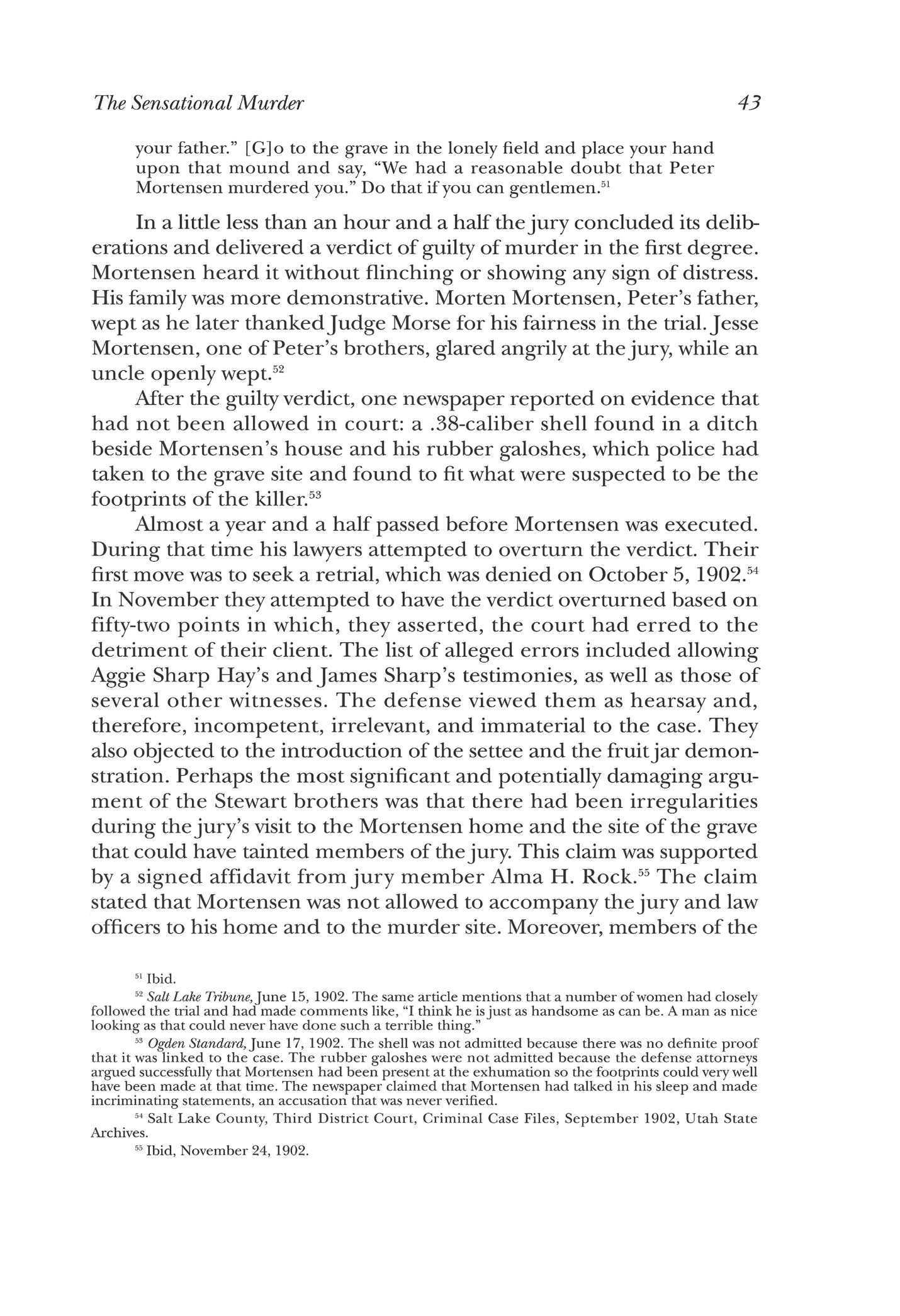
51 Ibid
52 Salt Lake Tribune, June 15, 1902 The same article mentions that a number of women had closely followed the trial and had made comments like, "I think he is just as handsome as can be A man as nice looking as that could never have done such a terrible thing."
53 Ogden Standard, June 17, 1902 The shell was not admitted because there was no definite proof that it was linked to the case The rubber galoshes were not admitted because the defense attorneys argued successfully that Mortensen had been present at the exhumation so the footprints could very well have been made at that time The newspaper claimed that Mortensen had talked in his sleep and made incriminating statements, an accusation that was never verified.
54 Salt Lake County, Third District Court, Criminal Case Files, September 1902, Utah State Archives
55 Ibid, November 24, 1902
The Sensational Murder 43
jury had counted off the distance between the Hay and Mortensen homes as well as the distance of the grave from the railroad tracks. These actions, the Stewarts declared, had prejudiced members of the jury against their client. After a hearing that included testimonies or affidavits from Alma Rock, Royal Young, and others, it wasjudged that no improprieties had occurred.56
In a final attempt to save his life, Mortensen appeared before the State Board of Pardons, which consisted of Governor Heber M. Wells and members of the Utah Supreme Court. Mortensen asked the board to review the case and commute his sentence to life in prison
As part of the review process, District Attorney Eichnor and Judge Morse were asked for their opinions concerning Mortensen. Eichnor wrote that he had no new knowledge that would warrant his recommending commuting the sentence to life. Morse, on the other hand, stated that although there had been enough circumstantial evidence for the jury to find the defendant guilty beyond a reasonable doubt, he did not believe "that the death penalty ought ever to be inflicted upon a person whose conviction rests solely upon circumstantial evidence." Therefore, he recommended commutation be granted.57
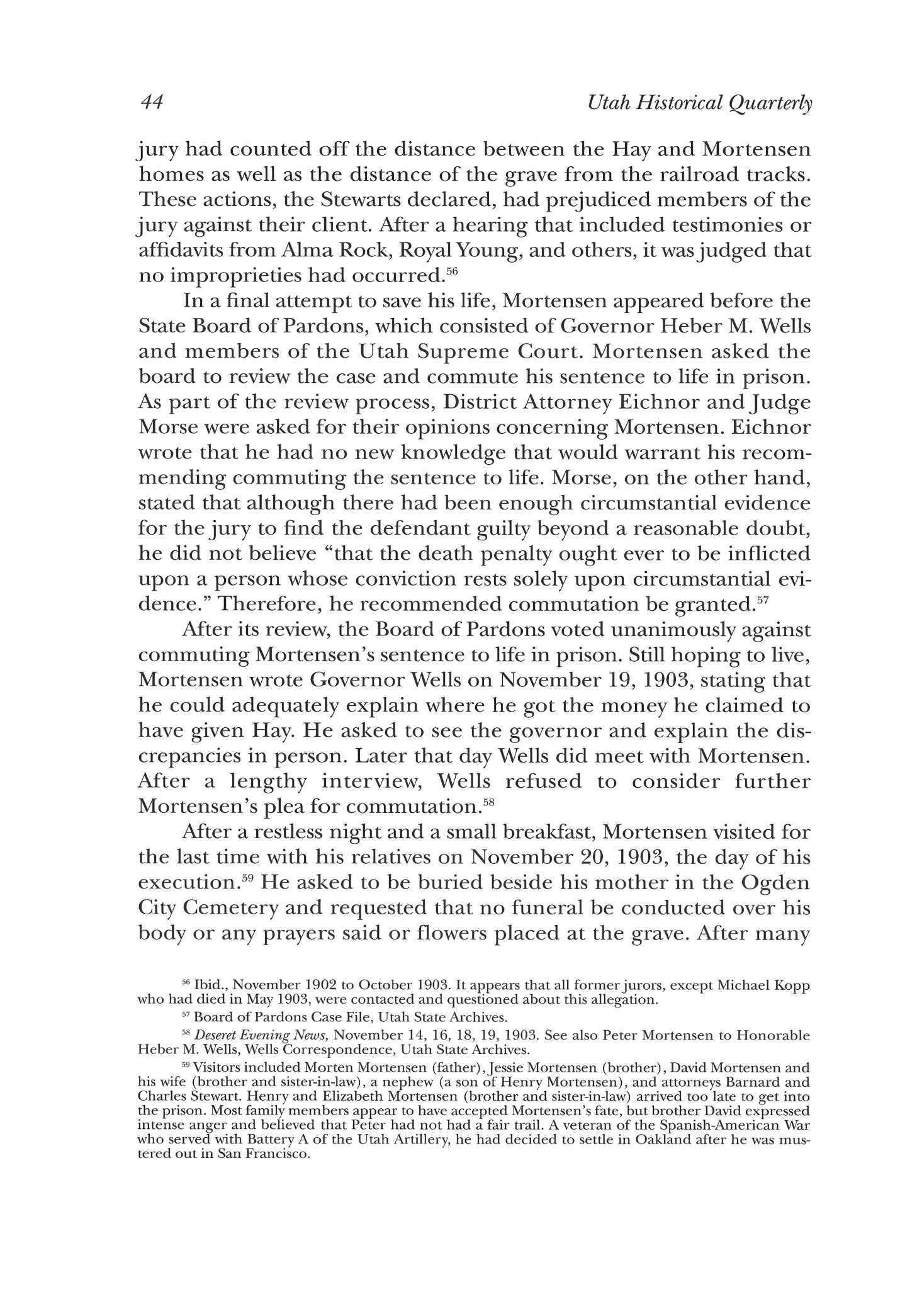
After its review, the Board of Pardons voted unanimously against commuting Mortensen's sentence to life in prison. Still hoping to live, Mortensen wrote Governor Wells on November 19, 1903, stating that he could adequately explain where he got the money he claimed to have given Hay. He asked to see the governor and explain the discrepancies in person Later that day Wells did meet with Mortensen
After a lengthy interview, Wells refused to consider further Mortensen's plea for commutation.58
After a restless night and a small breakfast, Mortensen visited for the last time with his relatives on November 20, 1903, the day of his execution.59 He asked to be buried beside his mother in the Ogden City Cemetery and requested that no funeral be conducted over his body or any prayers said or flowers placed at the grave. After many
56 Ibid., November 1902 to October 1903 It appears that all former jurors, except Michael Kopp who had died in May 1903, were contacted and questioned about this allegation
57 Board of Pardons Case File, Utah State Archives
58 Deseret Evening News, November 14, 16, 18, 19, 1903 See also Peter Mortensen to Honorable Heber M Wells, Wells Correspondence, Utah State Archives
59 Visitors included Morten Mortensen (father),Jessie Mortensen (brother), David Mortensen and his wife (brother and sister-in-law), a nephew (a son of Henry Mortensen), and attorneys Barnard and Charles Stewart Henry and Elizabeth Mortensen (brother and sister-in-law) arrived too late to get into the prison Most family members appear to have accepted Mortensen's fate, but brother David expressed intense anger and believed that Peter had not had a fair trail A veteran of the Spanish-American War who served with Battery A of the Utah Artillery, he had decided to settle in Oakland after he was mustered out in San Francisco
44 Utah Historical Quarterly
tears the family departed. Noticeable by their absence were Mortensen's wife, Ruth, and their children He had not seen them since his arrest. In fact, he had never seen his youngest child, Ruth, who was born after his arrest. After his family left, Mortensen met with the press, speaking passionately and emphatically at times and occasionally wiping away tears.60 He maintained his innocence to the end:
To the world I want to say, and I swear by the heavens above, by the earth beneath, and by all that I hold near and dear on earth, that I am not guilty of that cowardly murder of my dearest friend I ask, therefore, no man's pardon for aught that I may have done in life. I am confident that my life is an example to most people.61
At 10:27 A.M.Mortensen was led out to a chair against the east wall of the prison. He was shot by a firing squad at 10:31 A.M., and a wagon took his body away to be buried in Ogden One final twist in the Mortensen saga was the refusal by officials at the Ogden City Cemetery to accept his body for burial. Henry and David Mortensen were forced to have their brother's remains buried in the prison cemetery.62
After Mortensen's execution and burial, family members were left to continue their lives. Morten Mortensen returned to California where he died in 1925. His body was returned to Utah and buried next to his wife's in the Ogden City Cemetery Henry, who had lived near and worked with his brother Peter, also moved to California. After the trial Peter Mortensen's home was given to Barnard Stewart as payment for his legal services.63
Ruth Elizabeth Mortensen, Peter's estranged wife, suffered gready from emotional problems for years after the murder. Shortly after the arrest, she and her children had moved to Ogden to be close to her father and siblings. Ruth depended upon her family to help make ends meet until her children could help her financially. By 1914 Ruth and her children were using her maiden name of Watkins as their surname. 64
60 Salt Lake Tribune, November 21, 1903; Ogden Standard, November 20, 1903; Deseret Evening News, November 20, 1903
61 Salt Lake Tribune, November 21, 1903
62 Ibid.; Deseret Evening News, November 20, 21, 1903; Ogden Standard, November 20, 1903 Among the ninety-three people invited to witness the execution were Joh n C Sharp and Andrew Jenson Ironically, the same day that Mortensen was executed in Utah the infamous bounty hunter and killer Tom Horn was executed in Wyoming
63 Ogden City Cemetery Records, part 3 (Salt Lake City: Genealogical Society of Utah, 1940-42), p. 665 According to LDS Church Census records for the years 1914, 1920, 1925, 1930, and 1935, as well as records of the Berkeley, Oakland, and Hollywood wards, all in LDS Church Archives, some members of the Mortensen family remained active Mormons while others did not
64 LDS Church Census, 1914; R. L. Polk & Co's Ogden City Directory (1918), p 444; ibid.,(1919), p 469-70; ibid.,(1920), pp 489-90; and, U.S Census, Ogden, Weber, Utah, sheets 11 and 17 Charles, Ernest, and Ruth were still living with their mother and working as railroad switchman, railroad hostler, and department store saleswoman, respectively Jesse was a construction carpenter

The Sensational Murder 45
By 1925 Ruth had moved to California She married Alix Justesen, and they settled in the Bay Area. Ruth died on September 5, 1943, in relative anonymity. It appears that she went to great lengths to forget her earlier identity and protect herself from the scrutiny of people who might be aware of the Hay murder and her husband's sensational trial.65
James Sharp, on the other hand, remained prominent in the community until his death on May 7, 1904 Front page headlines announced that the former mayor of Salt Lake City had died from a sudden illness. After recounting his numerous business and political achievements, the news story then stated:
It is a matter of knowledge to the associates and friends of the deceased that he has not been in the best of health for some years, and that his condition was greatly aggravated in the tragic fate of James R Hay, his son-in-law, who was so cruelly murdered. It will be remembered how he described in open court before judge, jury and accused that God had revealed to him the identity of the assassin The statement was made in all soberness and created a tremendous sensation at the time and for months thereafter The declaration made a pronounced impression upon all concerned and was very widely discussed. Through the long, legal battle that followed, Mr Sharp maintained the correctness of that statement, though he maintained it unwillingly, it being drawn from him by the attorneys of the defense

The whole dreadful affair preyed heavily upon his mind and no one will know how much it had to do with hastening the closing chapter of his days upon earth Certainly it broke down his health and brought sorrow and gloom to a life that had previously enjoyed much sunshine.66
Aggie Sharp Hay and her three young children eventually moved to Rexburg, Idaho, where her brother Heber and his wife had settled.67 Apparently Aggie had felt forced to leave Salt Lake City because of the "stigma" of her husband's murder. She felt betrayed by the
65 Charles (Mortensen) Watkins was listed as living in Sacramento, California, in the 1930 LDS Church Census No trace of Ruth or her other children could be found, even after searches using several names It appears that by that time Ruth and her children had basically left the LDS church, although her death was noted in the Berkeley Ward records for 1943, p 653, where it states that she was not known to ward members as she was not a member of record
66 Deseret Evening News, May 7, 1904. Because James Sharp had been a regent for the University of Utah for almost thirty years, all classes were cancelled the day of his funeral. His funeral was held in the Assembly Hall on Temple Square. Seated on the stand were members of the LDS First Presidency, Twelve Apostles, and other church leaders. Among the numerous speakers were George F. Gibbs and President Joseph F. Smith. Among the pallbearers were Governor Heber M. Wells and University of Utah President Joseph T. Kingsbury. Deseret Evening News, May 11, 1904.
67 Telephone interview with Marianne Sharp Long, December 17, 1994 By 1904 Heber Sharp had established a mercantile store in Rexburg, Idaho In September 1902 he had married Vera Young Cannon, daughter of George Q and Caroline Young Cannon, in the Salt Lake Temple, James Sharp officiating It appears that Aggie and her children moved to Idaho sometime in late 1906 or early 1907 and lived for a time with the Heber Sharp family
46 Utah Historical Quarterly
community's reaction to her father's claim of personal revelation.68 However, according to a granddaughter, Aggie suffered from "a serious thyroid disorder" that caused "terrible mood swings" and bouts of depression.69 Some of her statements probably were the result of her illness In April 1917 Aggie's thyroid problem had reached a point where it was deemed necessary to operate, and she traveled to Salt Lake City for the surgery. Complications followed the operation, and Aggie died on April 25. Her funeral was held in the Twentieth Ward Chapel where she had been blessed by her grandfather, Bishop John Sharp, forty years before

Eventually all three Hay children returned to the Salt Lake area. Ruth, who never married, worked for years in the Home Fire Insurance Company. Robert was so bitter and self-conscious about his father's murder that he changed his surname to Hays to avoid the impertinent inquiries that had faced him on his return from Idaho James also returned to Salt Lake and became an accountant. While his two older siblings recognized their membership in the LDS church, albeit inactive,James never considered himself a member; however, both Robert and James married Mormon women and their children were raised as Latter-day Saints.70
The children of Robert andJames know very little about the murder of their grandfather in 1901 Jane Zobell recalled that she was about fifteen years old before she heard of it. Her mother told her to never mention it to her father as the memories were too painful and the feelings too strong.71
As the Salt Lake Tribune adequately, although somewhat melodramatically, explained, "99 out of every 100 people in Salt Lake" believed that Peter Mortensen was guilty of murder
An immense and all-sufficing egotism was the keynote to his career In the light of his subsequent career it is not difficult to believe that the motive for the murder of James R Hay was not so much the financial gain as to avoid exposure for proposing a dishonorable scheme—an exposure which would have held him up to the scorn of those whom he sought to impress with the height of his virtue and the extent of his rectitude
Even when he could no longer doubt the feeling entertained toward him by the community, when his wife had deserted him, his 1994
Ibid., November 14, 1994
Ibid
Ibid Zobell said she had never even discussed with her sister the murder of their grandfather
The Sensational Murder 4 7
Telephone interview with Elizabeth Jane Hay Zobell, a daughter of James Heber Hay, May 26,
brothers-in-law forsaken him, he kept up the sham He never tired of parading his religion and holding himself up as a pattern of morality. The court, the jury, the witnesses, the Supreme Court, the Board of Pardons, the Governor, might be wrong, but he, Peter Mortensen, was always right.72
Thus, in the eyes of most of the people of Salt Lake, a murderer had been caught, potential religious and political conflict had been avoided, andjustice had been done For most people the story ended with the sound of gunshots from a firing squad on that November morning; for others it went painfully on. For family members on both sides of this tragedy, the impact of this event was tinged with pathos. To this day some silently carry the pain of an unspeakable event that happened almost a century ago, an event that ripped loved ones from their wives and small children and shattered lives forever. Although murder unfortunately occurs repeatedly, this particular murder, for various reasons, shocked an entire city and held its citizens in spellbinding horror throughout a sensational trial—the trial of the century in its time
'
2 Salt Lake Tribune, November 21, 1903 Regarding the exposure of a "dishonorable scheme," it should be noted that the Ogden Standard, June 17, 1902, had mentioned that Mortensen had been overheard talking in his sleep He is purported to have said, "Oh, Jimmie! If you had done as I wanted you to you would not be where you are and I would not be here!" He is also supposed to have repeated something about "divide up." This led a number of people to believe that Mortensen had led Hay down to the tracks on some pretense and then tried to convince him to claim that he had been paid and then robbed For this, Mortensen would have given him half of what little money he had Hay refused and was shot by Mortensen to keep him quiet
Statement of Ownership, Management, and Circulation
The Utah Historical Quarterly (ISSN 0042-143X) is published quarterly by the Utah State Historical Society, 300 Rio Grande, Salt Lake City, Utah 84101-1182. The editor is MaxJ Evans and the managing editor is Stanford J Layton with offices at the same address as the publisher The magazine is owned by the Utah State Historical Society, and no individual or company owns or holds any bonds, mortgages, or other securities of the Society or its magazine.
The following figures are the average number of copies of each issue during the preceding twelve months: 3,295 copies printed; 100 dealer and counter sales; 2,767 mail subscriptions; 2,867 total paid circulation; 39 free distribution (including samples) by mail, carrier, or other means; 2,906 total distribution; 389 inventory for office use, leftover, unaccounted, spoiled after printing; total, 3,295.
The following figures are the actual number of copies of the single issue published nearest to filing date: 3,209 copies printed; 15 dealer and counter sales; 2,688 mail subscriptions; 2,703 total paid circulation; 43 free distribution (including samples) by mail, carrier, or other means; 2,746 total distribution; 463 inventory for office use, leftover, unaccounted, spoiled after printing; total 3,209.

48 Utah Historical Quarterly
A Common Soldier at Camp Douglas, 1866-68
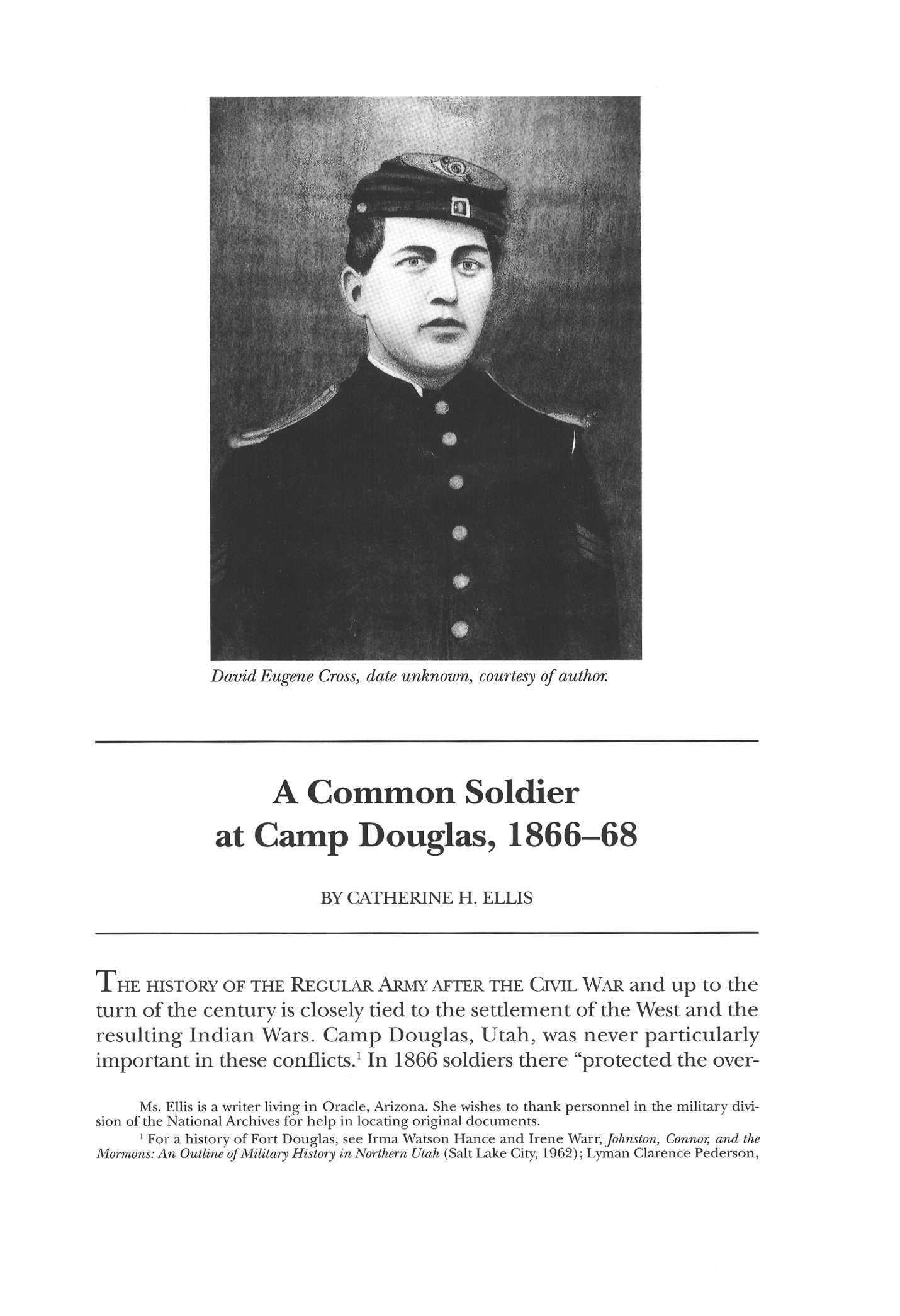 BYCATHERINE H. ELLIS
BYCATHERINE H. ELLIS
TH E HISTORY OF THE REGULAR ARMY AFTER THE ClVIL WAR and up to the turn of the century is closely tied to the settlement of the West and the resulting Indian Wars Camp Douglas, Utah, was never particularly important in these conflicts.1 In 1866 soldiers there "protected the overMs. Ellis is a writer living in Oracle, Arizona. She wishes to thank personnel in the military division of the National Archives for help in locating original documents
1 For a history of Fort Douglas, see Irma Watson Hance and Irene Warr, Johnston, Connor, and the Mormons: An Outline of Military History in Northern Utah (Salt Lake City, 1962); Lyman Clarence Pederson,
David Eugene Cross, date unknown, courtesy of author.
land mail and transcontinental telegraph lines from the Indians; kept the Mormons under surveillance; guarded the transportation routes crossing Utah in all directions; and aided road surveying parties."2
The campaigns of the Indian Wars have been covered extensively, but the history of the army has usually been told from the viewpoint of the officers. Many enlistees were illiterate or their letters have faded into the oblivion of private family memorabilia. Exceptions include books by Rickey and Coffman,3 but each book only rarely mentions Camp Douglas. Some details of life at the Utah post are found in a group of five letters written between January and May 1863 by Alexander C. Badger, Jr., a civilian employee of the U.S. Army.4 This
Jr., "History of Fort Douglas, Utah" (Ph.D. diss., Brigham Young University, 1967), and Charles Gustin Hibbard, "Fort Douglas 1862-1916: Pivotal Link on the Western Frontier" (Ph.D diss., University of Utah, 1980).
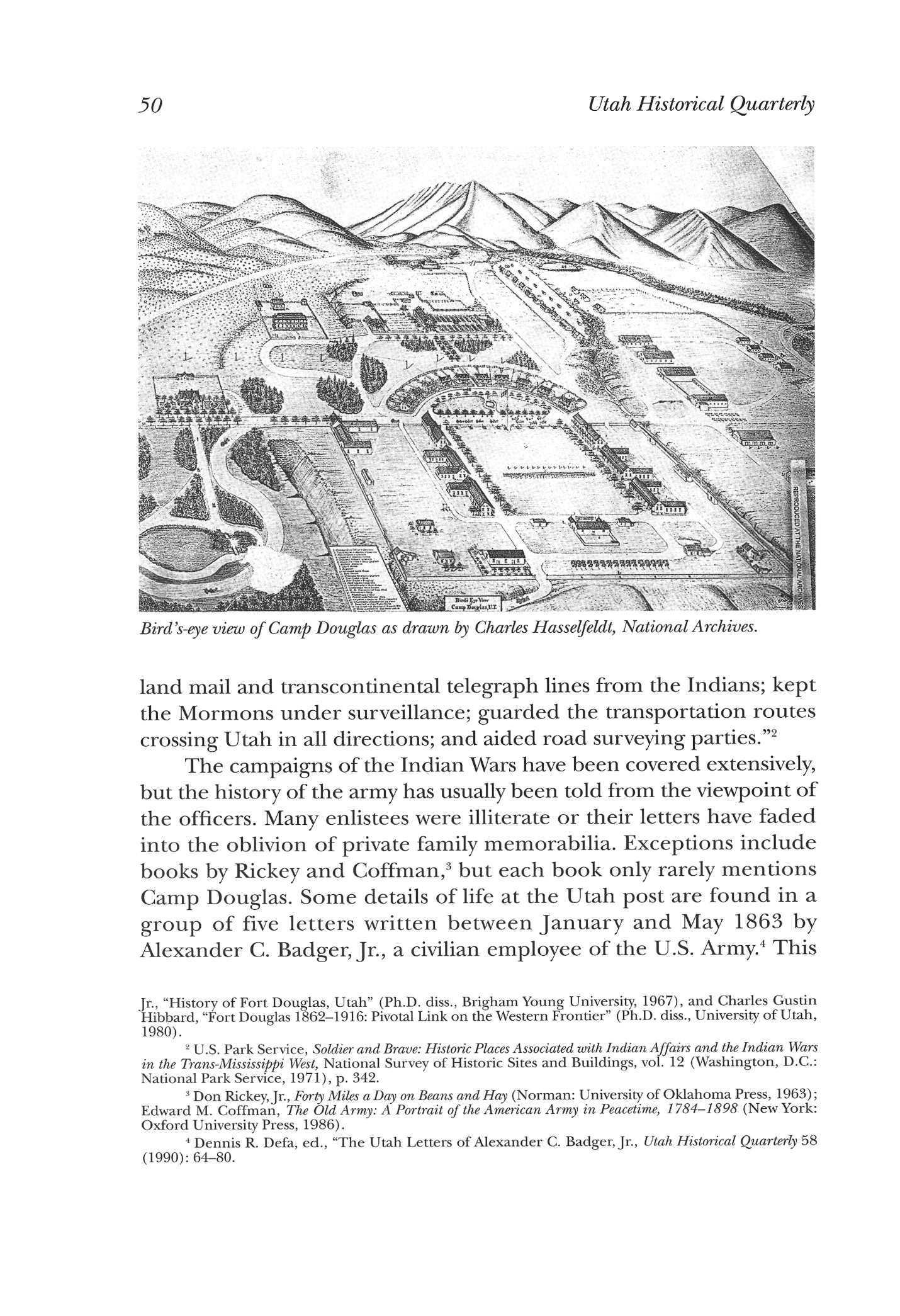
- U.S Park Service, Soldier and Brave: Historic Places Associated with Indian Affairs and the Indian Wars in the Trans-Mississippi West, National Survey of Historic Sites and Buildings, vol. 12 (Washington, D.C.: National Park Service, 1971), p 342
3 Don Rickey, Jr., Forty Miles a Day on Beans and Hay (Norman: University of Oklahoma Press, 1963); Edward M Coffman, The Old Army: A Portrait of the American Army in Peacetime, 1784-1898 (New York: Oxford University Press, 1986)
4 Dennis R Defa, ed., "The Utah Letters of Alexander C Badger, Jr., Utah Historical Quarterly 58 (1990): 64-80
50 Utah Historical Quarterly A ;
Bird's-eye view of Camp Douglas as drawn by Charles Hasselfeldt, National Archives.
paper adds to the story by telling of one soldier stationed at Camp Douglas during 1866—68.
David Eugene Cross, born January 23, 1849, in North Bloomfield, Trumbull County, Ohio, participated in the closing scenes of the Civil War; he joined the 5th Ohio Infantry on August 17, 1864. To enlist, he lied about his age (he was only 15 years, 7 months) and entered as a substitute forJoseph A. Giddings. Cross immediatelyjoined General William Tecumseh Sherman's army at Atlanta, Georgia, and thus participated in Sherman's infamous "march to the sea."5
After the Civil War, Cross sought work in Chicago and then enlisted in the Regular Army March 1, 1866.6 Military records describe him as: "Dave E. Cross. Born in Trumbull Co., Ohio, age 19 [really 17 years, 2 months], occupation bookkeeper, eyes blue, hair brown, complexion fair, height 5 feet 514 inches."7 Many men joined as a free ticket to see the West (which may have contributed to his decision), but a November 1865 letter8 to his mother hints that he may have found it hard locating adequate employment after the Civil War, another common reason for enlistment.9
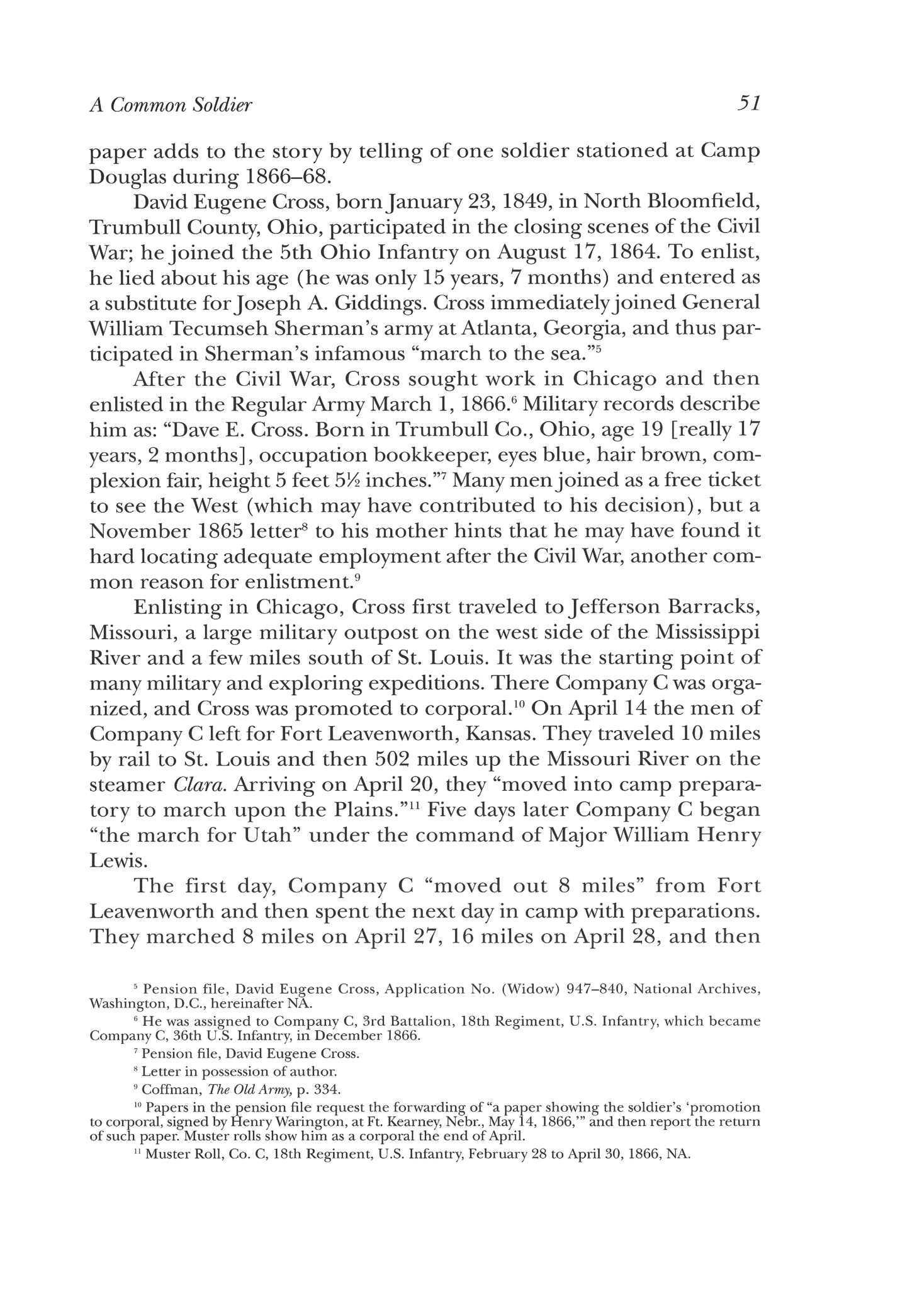
Enlisting in Chicago, Cross first traveled to Jefferson Barracks, Missouri, a large military outpost on the west side of the Mississippi River and a few miles south of St Louis It was the starting point of many military and exploring expeditions. There Company C was organized, and Cross was promoted to corporal.10 On April 14 the men of Company C left for Fort Leavenworth, Kansas. They traveled 10 miles by rail to St. Louis and then 502 miles up the Missouri River on the steamer Clara. Arriving on April 20, they "moved into camp preparatory to march upon the Plains."11 Five days later Company C began "the march for Utah" under the command of Major William Henry Lewis.
The first day, Company C "moved out 8 miles" from Fort Leavenworth and then spent the next day in camp with preparations They marched 8 miles on April 27, 16 miles on April 28, and then
5 Pension file, David Eugen e Cross, Application No (Widow) 947-840, National Archives, Washington, D.C., hereinafter NA
6 He was assigned to Company C, 3rd Battalion, 18th Regiment, U.S. Infantry, which became Company C, 36th U.S. Infantry, in December 1866.
7 Pension file, David Eugene Cross
8 Letter in possession of author
9 Coffman, The Old Army, p 334
10 Papers in the pension file request the forwarding of "a paper showing the soldier's 'promotion to corporal, signed by Henry Warington, at Ft. Kearney, Nebr., May 14, 1866,'" and then report the return of such paper Muster rolls show him as a corporal the end of April
" Muster Roll, Co C, 18th Regiment, U.S Infantry, February 28 to April 30, 1866, NA
A Common Soldier 51
camped near Lancaster, Kansas, for one day to prepare the muster rolls. On April 30 the company "mustered at 8 am, [and] at 11 am marched to [camp] on Grasshopper Creek, Ks, a distance of 16 miles." This established the routine: march 13-20 miles each day carrying a pack, with no breaks for Sundays After six to eight days of travel, the company spent one day in camp along the trail, but most stops of any length were at established forts.
At first the army followed the Oregon-California Trail The men camped along the creeks and rivers: Big Grasshopper, Vermillion, Big Blue, Indian, Rock, Big Sandy, and Little Blue. Sixteen days of actual travel were required to traverse the 286 miles from Fort Leavenworth to Fort Kearney. On May 13, the day of their arrival at Fort Kearney, the men covered 28 miles, the most for any day on the trip. They were then allowed five days "rest."
Leaving Fort Kearney, the troops continued traveling along the south side of the Platte River to Fort Sedgwick in northeastern Colorado (twelve days travel with one day of rest). On June 2, Company C forded the South Platte River and camped for another day on the north side. Leaving the Oregon Trail, they followed the Lodgepole River through southeastern Wyoming, reaching Fort Halleck on June 19 This post, located at the northern base of pineclad Elk Mountain in the Dakota Territory (now Wyoming), existed
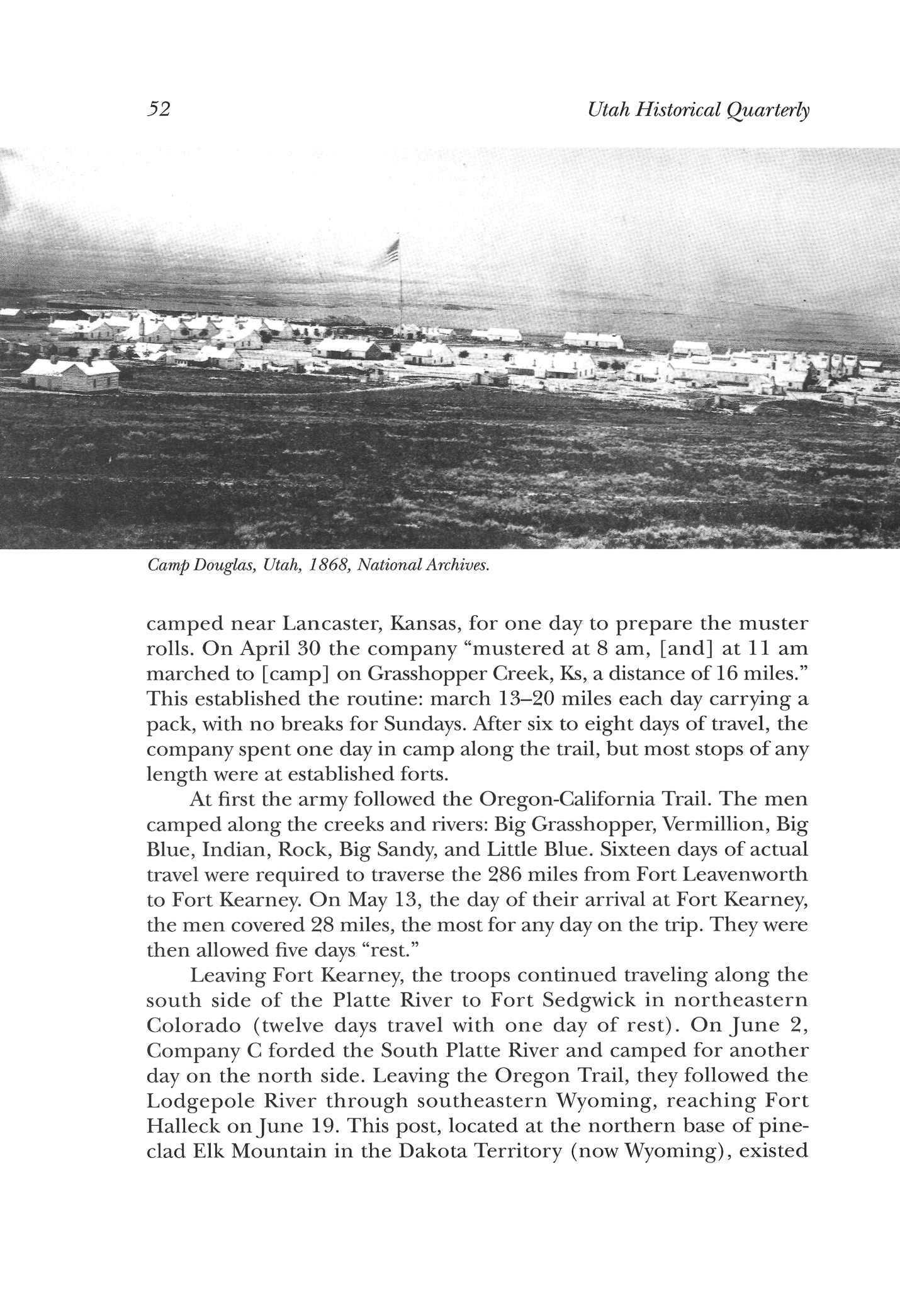
52 Utah Historical Quarterly
Camp Douglas, Utah, 1868, National Archives.
for only a short time (established in 1862 and abandoned July 4, 1866).12 Company C was the last or one of the last companies passing through.
After only one day at Fort Halleck, they continued the march. On June 22 they camped on the North Platte River where they remained until June 27, and on June 30 the troops camped on Muddy Creek, mustering at 6 P.M AS the trip progressed, less and less information was recorded in the muster rolls. The men spent July 1-19 "on the road en route from Camp No. 5 west from Fort Halleck, D.T. to Camp Douglas, U.T."13 Presumably the rest of the trip followed the Overland Trail. Finally, onJuly 19, after a march of nearly three months, the soldiers of Company C reached their destination—Camp Douglas, Utah
The arrival of Company C brought a new commander to the post, Major William Henry Lewis, and raised the number of soldiers to 15 officers and 262 enlisted men. In addition, many civilians were employed as clerks, mechanics, teamsters, ambulance drivers, watchmen, herders, blacksmiths, wheelwrights, and laborers, with as many as 147 in September 1866 and as few as 4 in April 1868.11
When David Cross came to Utah, he stepped into the Mormongentile conflict, centered not so much on polygamy (that conflict intensified later) but on commercial (or sometimes disaffected Mormon) problems. In one of two surviving letters15 written to his mother while a soldier, Cross mentions one of the more violent episodes, the killing of Dr J King Robinson ten days earlier.16 However, he mentions it only in passing. Instead, his letter reveals a typical young man not quite eighteen years old. If his figures are correct, he had grown four inches during the eight months since his enlistment.

12 Francis Paul Prucha, A Guide to the Military Posts of United States, 1789-1895 (Madison: State Historical Society of Wisconsin, 1964), p. 77.
13 Muster Roll, Co C, 18th Regiment, U.S Infantry, June 30 to August 31, 1866, NA
14 Post Returns of Camp Douglas, 1862-74, Series M617, roll 324, NA
15 Both letters are part of a packet of family letters in possession of the author It is believed that they were kept by David's mother and/o r brother for many years and then forwarded to his widow to help document her claim for a pension About 1962 they were given to the author by David's daughter-inlaw, Amelia Cross. The letters were left as written with the exception that occasionally one long paragraph was broken into two or three Also some "long periods" or dashes were interpreted as either periods or colons Original spelling was retained
16 Dr J King Robinson came to Utah in 1864 as a surgeon at Camp Douglas He later became embroiled in a controversy over a popular hot springs Recognizing the "medicinal value" of hot springs north of Salt Lake City, he claimed title to 80 acres of land (which the city also claimed) and erected a shanty (which the city ordered destroyed) Robinson was also head of the Congregationalist Sunday School. One night in late October 1866 he was supposedly called from his home to attend a patient and murdered The crime, which exacerbated Mormon-non-Mormon tensions in the city, was never solved See, for example, J Cecil Alter, Utah: The Storied Domain, 3 vols (Chicago and New York: American Historical Society, 1932), 1:367, 404-5, for a brief account of events
A Common Soldier 53
Camp Douglass U.S Nov 7, 1866
Dear Mother,17
I commenced this letter yesterday but as I expected one from you, did not finish it. I did not get yours yesterday but it came today. I was overjoyed to find dear sister Marys18 photo in it How old she looks I could hardly believe that the sober looking woman in the picture was the same gay careless girl that she was when last I saw her But I suppose her husband has tamed her down a little. I wish I could have Gerties19 picture too. I wrote to her a week or more ago I hope she will see fit to answer it You have got quite a family to attend to it seems. I should think you would find some girl to help you do your work We have not had the company of the Paymaster yet but he is expected every day now. When he comes I shall surely send you some of the papers he carries around with him (Greenbacks)

I am well, am 5 ft. 914 inches high. You would not know me if you should see me I'll bet I am changed a great deal I shall have some photos taken when we get paid.201 think I'll follow your advice in reference to cutting off my beard I guess you would rather have your little smoth faced boys photo than one with moustaches and imperial on his face but if you would rather have the whiskers in the photo, so it shall be
You asked if I am still company clerk. No I am not. There is a young man in the company who has been sick for a long time but has got about well but still he is not quite well enough to do duty. So at the request of the Captain I gave up my place to him and am now doing duty in the company We do not drill any now, so all I have to do is to go on guard once in 7 days,
17 David's parents, Abisha Cross, Jr., and Mary Howe Penniman, had moved from upper New York to Trumbull County, Ohio, about 1840 Abisha was a cooper/farmer and choir leader in the Methodist church Mary was later active in the women's suffrage movement in Warren, Ohio See 1850 census Bloomfield, Ohio, p. 831; 1860 census Bloomfield, Ohio, p. 348; 1880 census Warren, Ohio, E.D. 208, p. 1; 1910 census, Warren, Ohio, E.D 232, p 4; Ohio death certificate vol Bd Hlth 1888-1914, p 26; Iowa death certificate June 17, 1913 (Mary Penniman Cross); obituary in Western Reserve Chronicle, June 3, 1896, p 3; Land records, Trumbull Co., Ohio, vol 76, p 480, vol 82, p 174, vol 86, p 518, vol 98, p 105; Michael Barren Clegg, Trumbull County Ohio Newspaper Obituary Abstracts, 1812-1870 (Ohio Newspaper Abstracts Series, 1981), vol 1, p 104; and Harriet Taylor Upton, History of Trumbull County Ohio (Chicago: Lewis Publishing Co., 1909), vol 1, p 421
18 Mary E Cross Paine was born March 24, 1845, in North Bloomfield, Ohio In 1863 she married John H Paine, thirteen years her senior, and moved to Springfield, Missouri She had eight children, was widowed at age fifty, marrie d Charles Perky, and moved to Wahoo, Nebraska See 1850 census, Bloomfield, Ohio, p 265; 1860 census, Bloomfield, Ohio, p 348; 1880 census, Springfield, Missouri, E.D 44, p 17; 1900 census, Wahoo, Nebraska, E.D 139, p 7; 1910 census, Wahoo, Nebraska, E.D 155, p 4; marriage record, Trumbull Co., Ohio 1858-66, vol 6, p 163; Wahoo Democrat, September 11, 1919, p 1; and William Kearney Hall, Springfield, Greene County, Missouri Inhabitants in 1880 (Champaign, 111.: Francis Seyfarth, 1966?), p 160
19 Gertrude C Cross Pond, David's other sister, was born February 24, 1836, at Lockport (now Black River), Jefferson County, New York She married Benjamin W Pond, a merchant, and remained in Trumbull County the rest of her life. At the time of her brother's letter, she had one daughter, Caroline, often called Carrie. See 1850 census, Bloomfield, Ohio, p. 265; 1860 census Bloomfield, Ohio, p. 345; 1870 census Warren, Ohio, 1st Ward, p. 24; 1880 census Warren, Ohio, E.D. 208, p. 1; 1910 census, Warren, Ohio, E.D. 232, p. 4; marriage record, Trumbull County, Ohio, 1858-66, vol. 5, p. 360; probate record, Trumbull County, Ohio (Ad. Doc), vol. 19, p. 3917 (Docket), vol. 686, p. 2130; obituary in Western Reserve Democrat, February 24, 1910, p. 5; Trumbull County, Ohio Cemetery Inscriptions, 1800-1930 (Trumbull County Chapter O.G.S., 1983), p. 173.
20 The only extant photo of David E Cross may be this one, taken at Camp Douglas, but, since he looks older than 17, it may have been taken later (ca 1883) when he was a member of the GAR in Freeport, Illinois
54 Utah Historical Quarterly
as "Corporal of the Guard." The rest of the time I have to read or write or do any thing I want to. I have been placed in charge of a dozen men three times to chase deserters. Have caught three. I shall get $30 apiece for them, but will have to divide it with the men who were with me.
I got a letter from Emerson21 some time ago. He said he had been sick with the ague for a long time but was well again. He is at work now at his trade. I answered it the same day that I got it, as I always do. It is about time I got an other from him but then I suppose he will not answer mine as soon as I did his. I hope Mary will write to me. I wrote to her since she did to me but I guess she has forgotten me altogether.
I received a letter from Delia Showens a few days ago. She says that her sister is married and she is living with her. I was surprised to learn that Mrs. Dr. Howe22 was dead. I never liked her any way, so shall not shed many tears about it.
I suppose you have heard about the assasination of one Dr. Robinson in this city by some of Brighams destroying angles have you not. If you have not I'll tell you all about it when I write again. He was shot by some of the mormons one night and was burried at Camp Douglas cemetery with Odd Fellows honors.23
Well I must stop now. Give my love to Father, Mary, Gertie, Carrie and all. Tell them to write to me.
David E. Cross
Send some more papers.
In his letter, Cross mentions the boredom of army life; it must have been a stark contrast to his Civil War experience of marching with General Sherman The daily routine for Camp Douglas, as entered into the post record on April 18, 1867, consisted of guard duty and drills with "Dress Parade—Wednesdays and Sundays—lA hour before sunset" and "Sunday morning inspection—9 O'Clock A.M."24 Driven by boredom, perhaps, Cross seems to have had minor skirmishes with military authorities On August 31 he owed $1.08, no reason given; on October 31 he owed $14.70 for clothing. By December 31 he owed $8.43 for clothing, $11.00 no reason given,
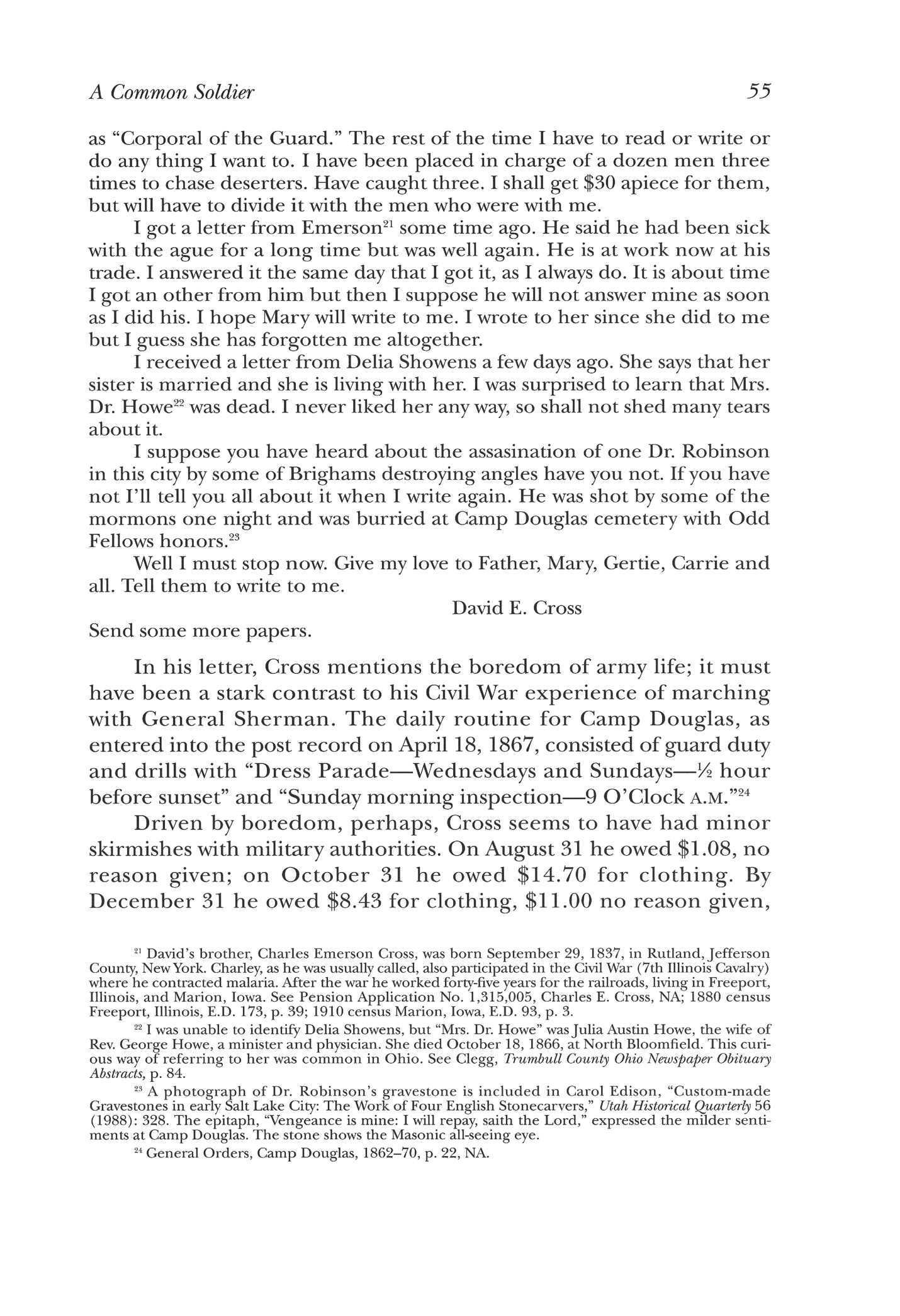
21 David's brother, Charles Emerson Cross, was born September 29, 1837, in Rutland, Jefferson County, New York Charley, as he was usually called, also participated in the Civil War (7th Illinois Cavalry) where he contracted malaria After the war he worked forty-five years for the railroads, living in Freeport, Illinois, and Marion, Iowa See Pension Application No 1,315,005, Charles E Cross, NA; 1880 census Freeport, Illinois, E.D 173, p 39; 1910 census Marion, Iowa, E.D 93, p 3
22 I was unable to identify Delia Showens, but "Mrs Dr Howe" was Julia Austin Howe, the wife of Rev George Howe, a minister an d physician She died October 18, 1866, at North Bloomfield This curious way of referring to her was commo n in Ohio See Clegg, Trumbull County Ohio Newspaper Obituary Abstracts, p 84
23 A photograp h of Dr Robinson's gravestone is included in Carol Edison, "Custom-made Gravestones in early Salt Lake City: The Work of Four English Stonecarvers," Utah Historical Quarterly 56 (1988): 328 The epitaph, "Vengeance is mine: I will repay, saith the Lord," expressed the milder sentiments at Camp Douglas The stone shows the Masonic all-seeing eye
24 General Orders, Camp Douglas, 1862-70, p 22, NA
A Common Soldier 55
and was reduced in rank from corporal to private. Then on March 28, 1867, he pleaded guilty at a garrison court-martial "In that [he] did sell, lose through neglect or otherwise dispose of one Infantry Great Coat." His sentence included hard labor for 30 days and forfeiture of $10 pay. 25 Loss of clothing usually meant that it had been sold to civilians.
Routine was broken at Camp Douglas as men prepared to mount two detachments. Orders for the first detachment called for "three non-commissioned officers and forty five privates, . . . armed and mounted as cavalry." Target practice was to begin immediately: "The number of rounds fired each day will be three per man. Company commanders will keep a record of the firing, reporting the number of shots fired and the best shot in the company."26
On May 14, 1867, Cross left Camp Douglas with this detachment, which included thirty-five enlisted men and one officer, Lieutenant William W. Bell, to escort Captain Bates, engineer for the Union Pacific Railroad The smaller number of men in the detachment than called for earlier may have been due to another detachment sent out on May 21 as "escort for gov't train and stock from Camp Douglas, U.T. to Ft. Laramie, D.T."27 Exploring and surveying the best railroad route from the East was a high priority.
When the company had been away from Camp Douglas about a month, Cross, still only eighteen, and another young man, William

56 Utah Historical Quarterly
Outbuildings at Camp Douglas, National Archives.
25 Post Records, Fort Douglas, vol 1, p 20 (recorded under Daniel C Cross), NA
26 General Orders, Camp Douglas, 1862-70, p 21-22
27 Muster Roll, Co C, April 30 to June 30, 1867, NA
H. Harrison, decided to desert. This may have been a spur-of-themoment idea, but talk of desertion (and desertion itself) was common. Rickey wrote that "Secretary of War Stephen B. Elkins reported that one-third of the men recruited between 1867 and 1891 had deserted."28 It seems amazing that Cross, who had hunted and captured deserters himself and knew the risks, would now make such plans. However, desertion when away from the fort was very tempting; most deserters who had a half-day start were never caught.29
Plans came to fruition on the night ofJune 14 when the detachment was camped at Thomas Fork of the Bear River near the present Idaho-Wyoming border The ground around the area was "muddy and [had] considerable backwater from the river. There were ponds of water all around," and it was "about 10 miles to the mountains."30 Cross saddled two horses and picketed them near the edge of the camp; William Harrison had guard duty. About 10 P.M. both men left camp, Cross first. Their absence was immediately reported. Lieutenant Bell stated, "The 1st Sergeant of the detachment which I commanded on the night in question came to my Tent and informed me that the prisoner and two others had just deserted taking with them each his horse, Arms and Accoutrements complete This was after 11 P.M. I mounted a small party as rapidly as possible and started in pursuit."31 An hour or two later both men were back in camp as prisoners
Bell's description of that night mentions a third man, William T. Thompson. At the court-martial, Thompson made this statement:
I beg to offer a statement of my intentions on the day that I was charged with Desertion by the Captain of my Company. On the night of the 14th ofJune 1867 I was cooking for the Detachment [when] Lance Sergeant Smith asked me to go after whiskey for him. He had some Bacon & Coffee to get it with I agreed to go Thinking it was all right, Saddled my horse and started after it. After I had got outside of Camp a few yards I met Private Cross of Co. C and he passed me on the trail. Afterwards Lieut. Bell rode up and arrested me I was not absent from a Roll Call, did not
28 Rickey, Forty Miles a Day on Beans and Hay, p 39 Coffman, The Old Army, pp 371-72, lists desertion as a major problem during this period, but his numbers are more varied and somewhat lower than Rickey's
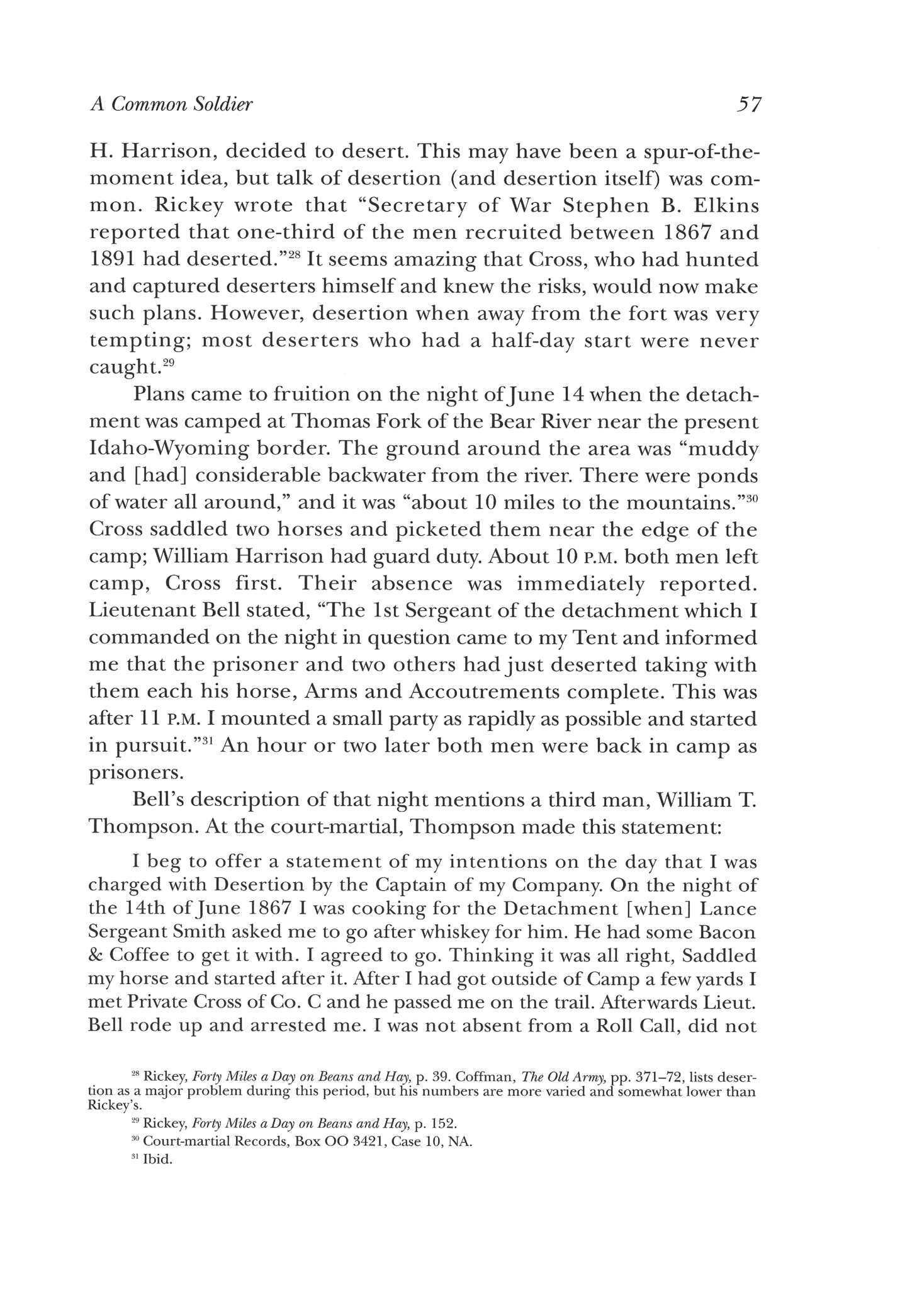
29 Rickey, Forty Miles a Day on Beans and Hay, p 152
30 Court-martial Records, Box O O 3421, Case 10, NA
51 Ibid.
A Common Soldier 5 7
mean to Desert, and did only what Soldiers Commonly do, that is, go for whiskey.
I had permission to be absent from Sergt Smith who was Sergt of the Guard at the time and who passed me through the lines
I am very Respectfully your obdt servant, William T Thompson
[Written in side margin] I wish to add that I would have called Lance Sergt Smith as a witness in my defense but he has since deserted and cannot be called. William T. Thompson.32
All three young men were then placed "in arrest" pending courtmartial. However, six weeks after the desertion attempt, Cross wrote another letter to his mother, and from this it is apparent that, at least initially, the three simply continued on with the field detail. The tone of this letter is not one of despondency, and it seems possible that Cross did not mention the desertion to his family When the three were allowed to continue with the detachment, he may not have realized the seriousness of his situation. Instead, this letter mentions encounters with the Sioux Indians and the spectacular scenery of western Wyoming.
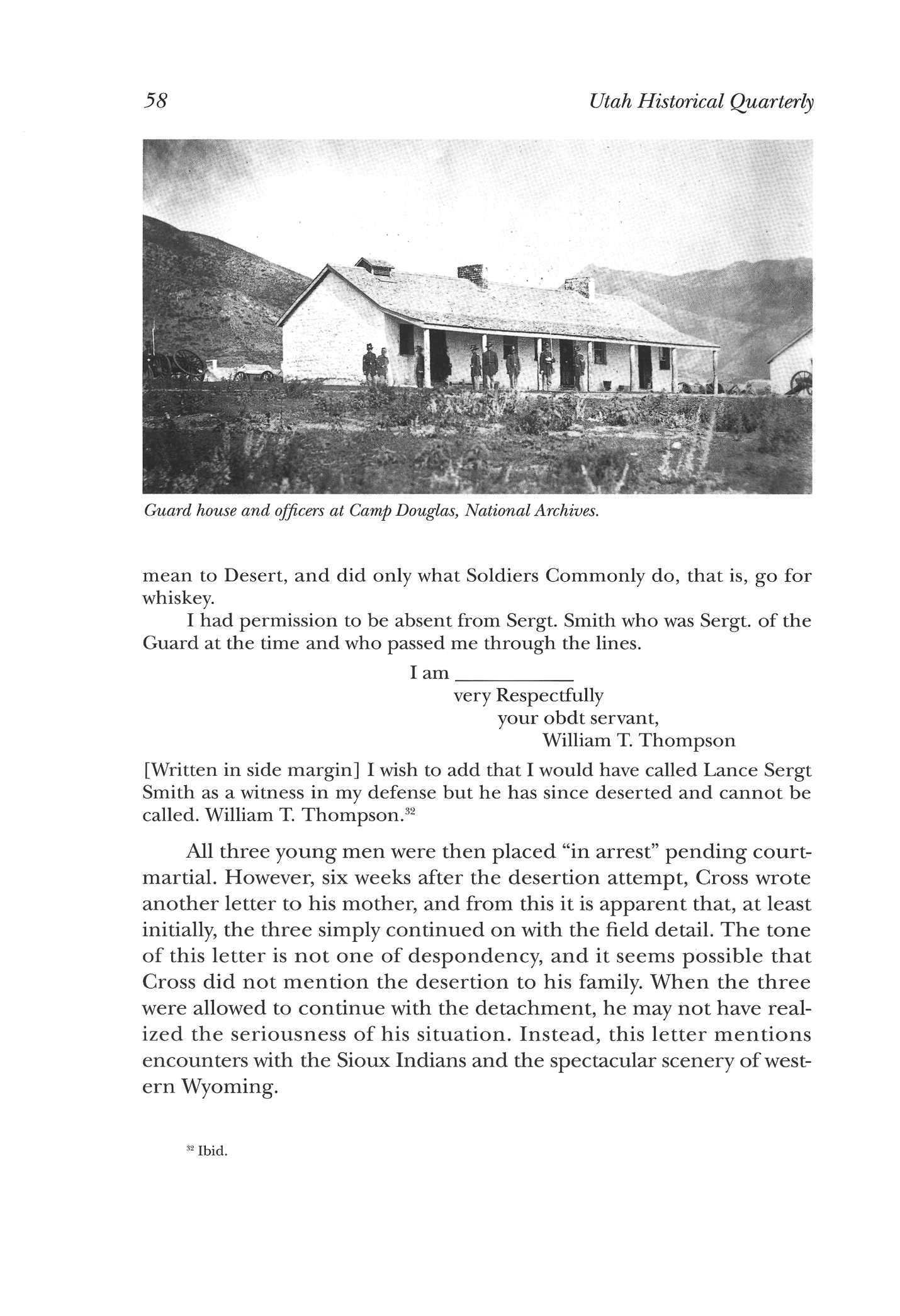
58 Utah Historical Quarterly
Guard house and officers at Camp Douglas, National Archives.
Ibid
In the Green River Mountains August 2nd 1867
Dear Mother,
It has been a long time since I have had an opportunity of writing to you, and have not had but two letters from you since the 10th of May. We are still roaming around through the mountains with the Surveyors looking for the most practible route for the Pacific R.R. We are now about 100 miles east of fort Bridger, among the Sioux Tribe of Indians The most they try to do is to crawl into our Corrull and drive off our horses. We have always caught them at it and beat them off so far
We are having pretty good times now. As good as could be expected while on such an expedition I wish you could see some of the Mountains that we see every day. Sometimes we have to follow an Indian trail way up — up over the mountains where one misstep would hurl us into eternity in a moment. We have seen the falls of the Green River, and are in sight of Freemonts Peak nearly all the time
I have not much to write this time because it is so hard to do it I am writing now with the Clerks pen and ink and have the paper on my Saddle skirt so you can imagine what kind of a chance I have for writing We are without an Officer now. Lieut Bell who was in charge of the party has been ordered to Douglas unde r arrest He used to be Ordnanc e officer in Douglas, and it has bee n discovered that he is $3,000 short of ordnance which was under his charge and he has been sent for by the Col to make an account of it. He will go up the spout I guess. He will be cashiered if he does not look sharp.33
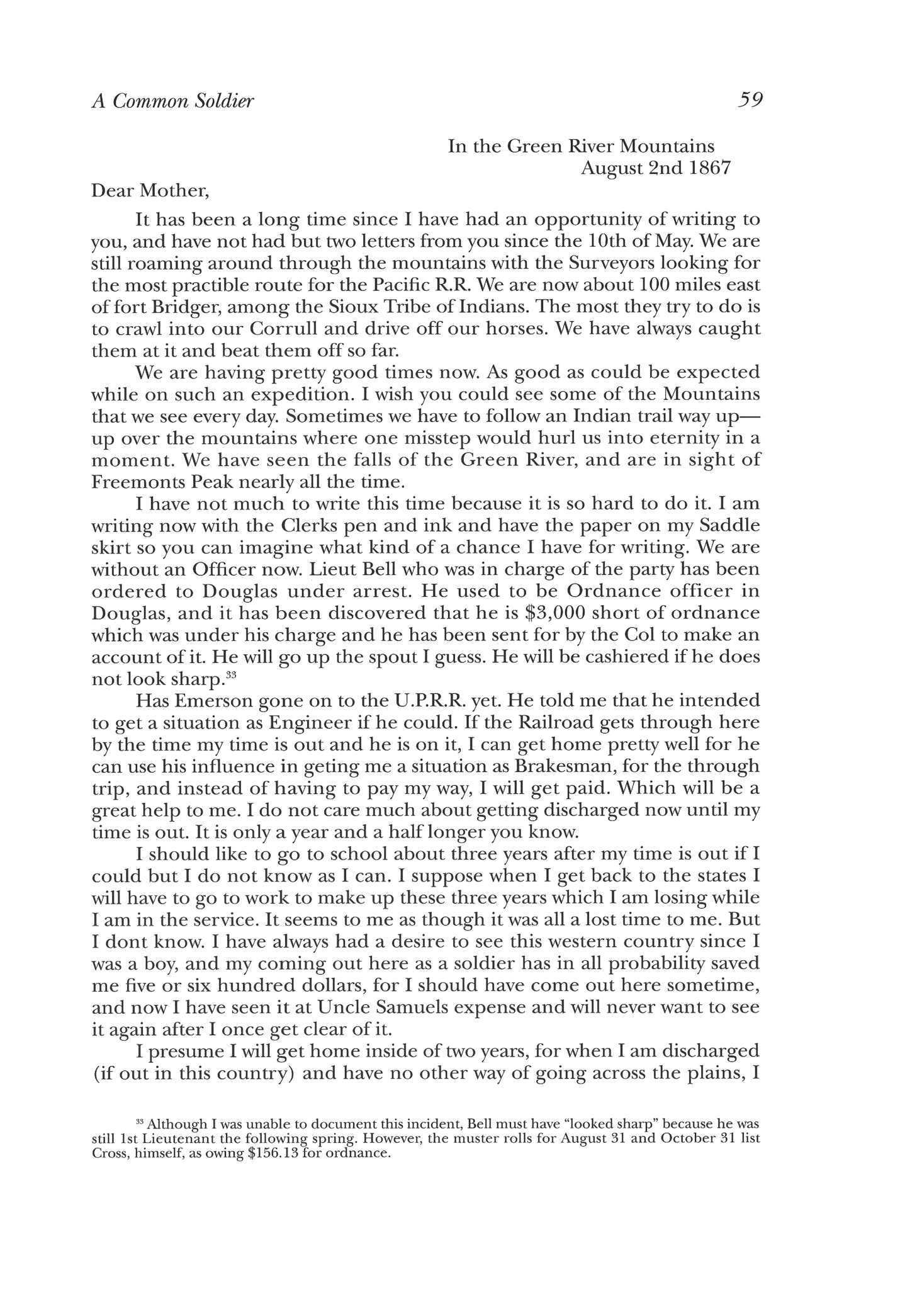
Has Emerson gone on to the U.P.R.R. yet. He told me that he intended to get a situation as Engineer if he could If the Railroad gets through here by the time my time is out and he is on it, I can get home pretty well for he can use his influence in geting me a situation as Brakesman, for the through trip, and instead of having to pay my way, I will get paid. Which will be a great help to me I do not care much about getting discharged now until my time is out. It is only a year and a half longer you know.
I should like to go to school about three years after my time is out if I could but I do not know as I can. I suppose when I get back to the states I will have to go to work to make up these three years which I am losing while I am in the service. It seems to me as though it was all a lost time to me. But I dont know I have always had a desire to see this western country since I was a boy, and my coming out here as a soldier has in all probability saved me five or six hundred dollars, for I should have come out here sometime, and now I have seen it at Uncle Samuels expense and will never want to see it again after I once get clear of it.
I presume I will get home inside of two years, for when I am discharged (if out in this country) and have no other way of going across the plains, I
33 Although I was unable to document this incident, Bell must have "looked sharp" because he was still 1st Lieutenant the following spring However, the muster rolls for August 31 and October 31 list Cross, himself, as owing $156.13 for ordnance.
A Common Soldier 59
shall buy a horse (I can get a good horse here for $50) and ride across the Plains and after I get across sell the horse for a hundred dollars. Horses are very cheep here, and the same horses bring a good price in the states.
Love to Father and all Write to Douglas I will get your letters all at a time when I get back
Good Bye
D. E. Cross
"P.S." This letter will be sent to Bridger to be mailed. It will take some days for it to get there I suppose.
David E. Cross
I had still another half sheet from Emerson. Plan of his house.
The surveying detachment arrived back at Camp Douglas on December 4, 1867. Cross was considered "in arrest" awaiting courtmartial, and a deserter was usually kept heavily guarded Sometimes the men were shackled so they could work outside the guard house during the day without much danger of their escaping. Various men were "in arrest" each month, with as many as ten from Company C in November 1867.34
Orders for courts-martial to be held at Camp Douglas were received February 27, 1868, from the Headquarters Department of the Platte, Omaha, Nebraska Twenty trials were held during the next two months for crimes including desertion, drunkenness, sleeping on duty, and theft and/or selling of government property. Cross's trial was held March 25, William Harrison's March 26, and William Thompson's March 27.35 The three men were each charged with desertion and theft of government property (i.e., "one [1] horse and equipments, one [1]Joslyn Carbine and Accoutrements complete and one [1] Remington Army Revolver and Accoutrements"). 3 6 They defended themselves and were permitted to question the witnesses or call their own. All three men entered slightly different pleas.
On Monday, Cross pleaded guilty to desertion and to theft of the horse but claimed he took no arms with him The tribunal spent considerable time questioning several witnesses about the carbine and pistol. Although the carbine may have been on the saddle, no one ever said they saw the pistol. The trial moved along rapidly, and after the prosecution closed its case Cross called Lieutenant Bell as a character 34 Post Returns of Camp Douglas, 1862-74,
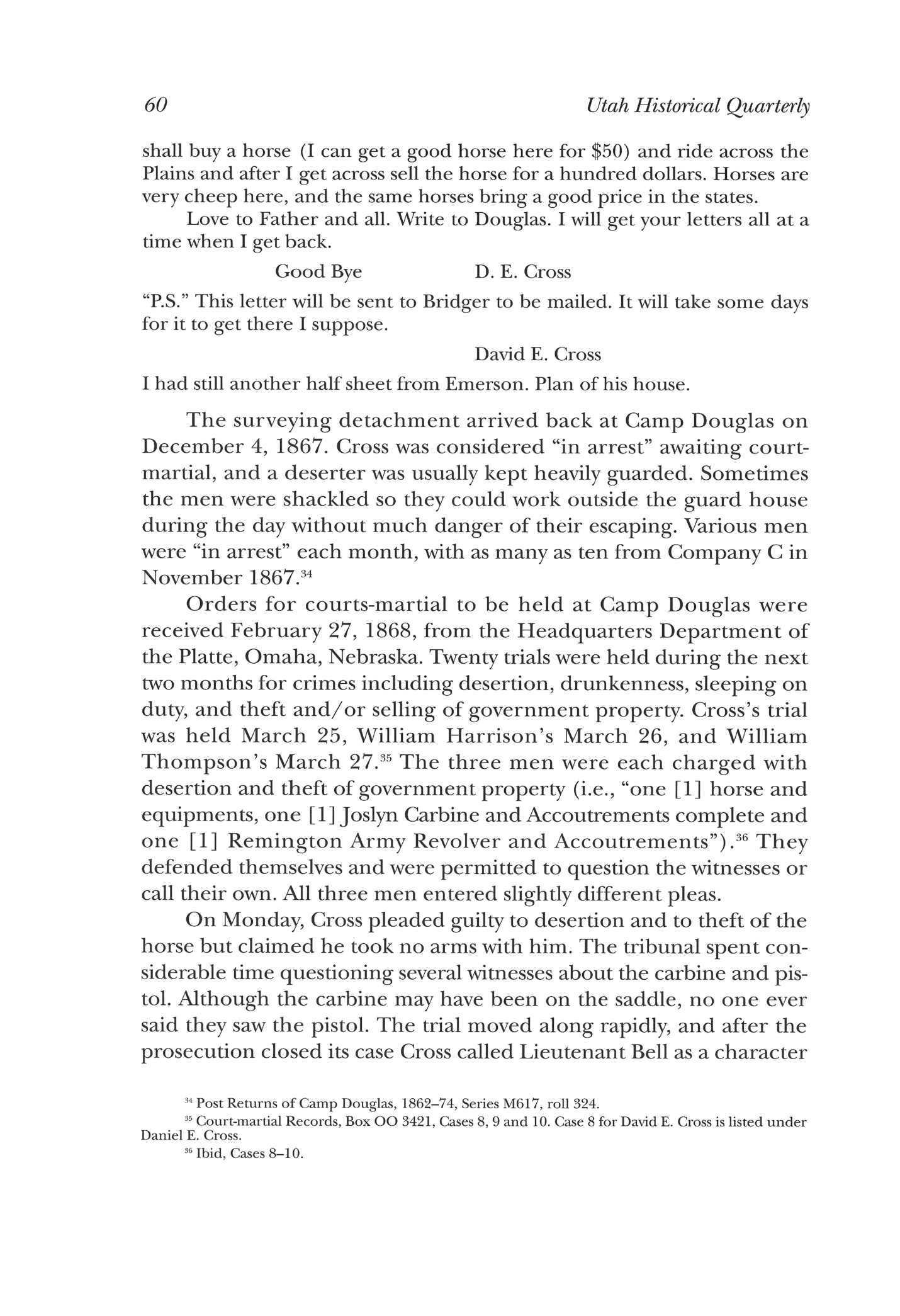
60 Utah Historical Quarterly
Series M617, roll 324 35 Court-martial Records, Box OO 3421, Cases 8, 9 and 10 Case 8 for David E Cross is listed under Daniel E Cross 36 Ibid, Cases 8-10
witness. Cross was found guilty of both desertion and theft and not guilty of taking the pistol and carbine.
The next day, Harrison pleaded guilty to desertion but not guilty to theft. Cross, called as a witness against Harrison, was particularly asked if he had seen Harrison with the horse after leaving camp. When asked who saddled the horse, Cross answered, "I dont wish to answer as it might criminate myself."37 Finally, Harrison made this closing statement: "It was first my intention to take the horse with me. I had the horse saddled and after wards got afraid to take it fearing what the consequences might be. I left the horse where it was picketed and never had him in my possession I walked about one hundred and fifty yards Eastwards of where the horse was left when I saw Lt Bell and party approaching I then ran into the Swamp and remained in the Swamp until I thought Lt. Bell and party had gone back, a part of them had gone back. [Then] I came out from the Swamp and was captured by Lt. Bell. I don't make this Statement to try to exonerate myself from any blame whatever, I simply wish to state the facts as they are and leave my case with the Court. I deserve no mercy and ask for none."38 He did not get any mercy from the court, which found him guilty of desertion and theft of arms but not guilty of stealing the horse.
On Wednesday, Thompson pleaded not guilty to both desertion and theft. The main witness for the prosecution was Lieutenant Bell, who stated: "I mounted a small party as rapidly as possible and started in pursuit After a short ride, I came upon this man discovering him attempting to cross [the overflowed?] portion of the low ground adjoining the River. His horse although urged to its utmost, could scarcely keep his feet owing to the softness of the ground he was on. As soon as I discovered him, I commanded him to halt. He paid no attention to the order but tried hard to get out of my reach. Fearing that he would reach the other side of the slough long enough before me to escape in the darkness up the mountain, I fired upon him. After two shots had been fired, he cried out don't shoot, don't shoot, I'm coming back, I'm coming back."39
Thompson consistently denied planning to desert and called both Harrison and Cross as witnesses in his behalf. Both men denied that he was part of their plans, although Cross said, "I heard him say something in regard to deserting. In fact I heard nearly every man in the outfit speak of deserting."40 Thompson then presented the state-
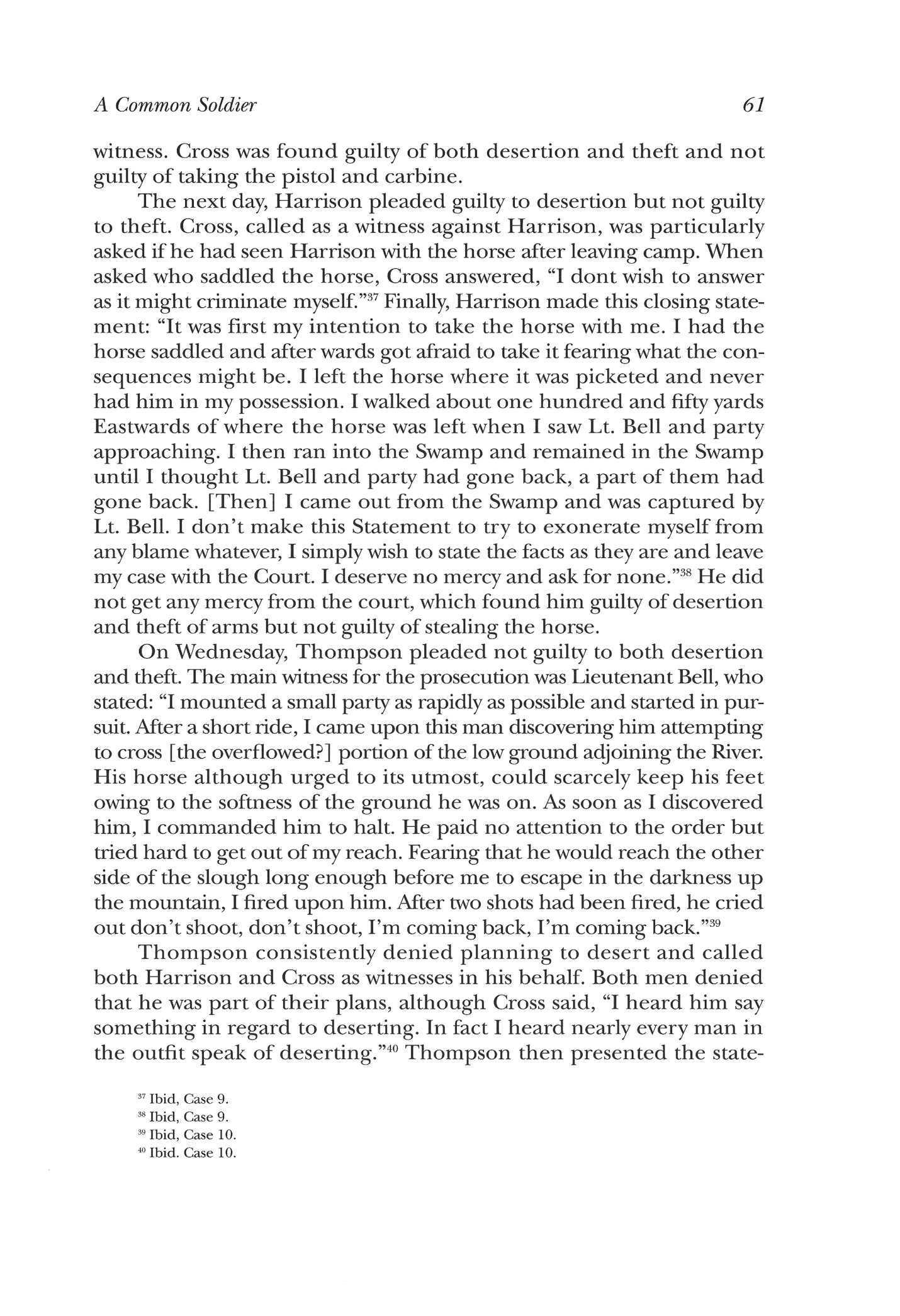
37 Ibid, Case 9
38 Ibid, Case 9
39 Ibid, Case 10
40 Ibid. Case 10.
A Common Soldier 61
merit previously quoted about going outside camp to buy whiskey and that Lance Sergeant Smith had since deserted and therefore was unable to corroborate his story. Regardless of this statement and the testimonies of Harrison and Cross, the court found Thompson guilty of both desertion and theft.

Although the three pleas and the three verdicts were slightly different, each man received the same sentence: dishonorable discharge, forfeiture of all pay (except the money due to the laundress), a brand (the letter 'D' VA inches long) on the right hip, and confinement at hard labor for four years. 41
After the twenty courts-martial were concluded in April, all the sentences were reviewed. Most sentences were simply approved with a few parts mitigated. No sentence was reversed. The sentences for Cross, Harrison, and Thompson were confirmed, but the period of confinement was mitigated to two years, the customary time for desertion, and the place designated was the penitentiary at Fort Madison, Iowa.42 The penitentiary portion of the sentences for these three men was strikingly different from the other sentences at Camp Douglas. Others charged with desertion simply received two to six months at hard labor with ball and chain and a dishonorable discharge and were drummed out of the military with their heads shaved.
Regardless, it is uncertain how much of any sentence was ever carried out Cross was dishonorably discharged on May 19, 1868, and undoubtedly lost all pay. Before being discharged he was probably branded (which at that time usually meant indelible ink rather than a hot iron). Years later his son, Bill Cross, said that his father had extensive tattoos on both arms and one leg43 and another time "prominent tatoo [sic] marks put on in the army."44 It is probable that one of these tattoos was the "D" for deserter and that Bill, as a young boy, simply did not recognize its significance or later in life chose to ignore its implication. It is a matter of record, however, that David Cross did not serve any time in the prison at Fort Madison, Iowa. Not one of the three did.43
Postscript: After the courts-martial, William Harrison and William Thompson were lost to history. It appears that Lieutenant William W.
41 Ibid, Cases 8-10 For some reason the imprisonment portion of Harrison's sentence was for five years instead of the four received by Cross and Thompson This may possibly mean that Harrison had a longer enlistment left to serve
42 Rickey, Forty Miles a Day on Beans and Hay, p. 155.
43 Pension file, David (Louisa) Cross
11 Bill Cross, "Life History of Bill Cross," p 3, holograph in possession of Rob Cross, Phoenix, Ariz
4S
62 Utah Historical Quarterly
A note in the muster rolls indicates they were "to be confined at Penitentiary near Salt Lake City, U.T.," but no records of their imprisonment in the territorial penitentiary have been found
Bell was assigned to lead a detachment from Fort Fetterman to Fort Sanders, Dakota Territory His death was reported "on the morning of the 14th of June, 1868, from the effects of a gun shot wound, received ... at the hands of one James Brown, a Private . . .while the said Lieut. William W. Bell was in the discharge of his duty trying to quell a mutiny."46 The muster roll states that James Brown was then "shot dead ... by the enlisted men of the company."47
Cross must somehow have escaped before being taken to Fort Madison.48 Earlier, he thought that after getting out of the army, he might buy a horse for $50 and ride east, but with the forfeiture of pay he probably did not have $50. Faced with the dilemma of no money to go east and the likelihood of rearrest at Camp Douglas, he made an intriguing decision—he changed his name to Bradley W. Willson and became a Mormon. He was baptized September 21, 1868.49
For his new identity Cross added a few years to his age (something he was used to doing), created a new mother (Elizabeth Dark Carson), and simply changed his father's surname (Abisha Willson).50 By early 1869 he was working in Sanpete County,51 and on February 28, 1870, he married a Mormon girl, Louisa Guldbrandsen. 5 2 They began a family, living in Fountain Green and later Spring Lake.53
Becoming a Mormon and living in Sanpete County was probably a fairly good disguise. The army had much less contact with the Mormons of Sanpete County than with the Mormons of Salt Lake City. Also, the animosity between the Mormons and the army was great enough that there was very little chance that a Mormon would turn one of their own over to the army even for the bounty money.
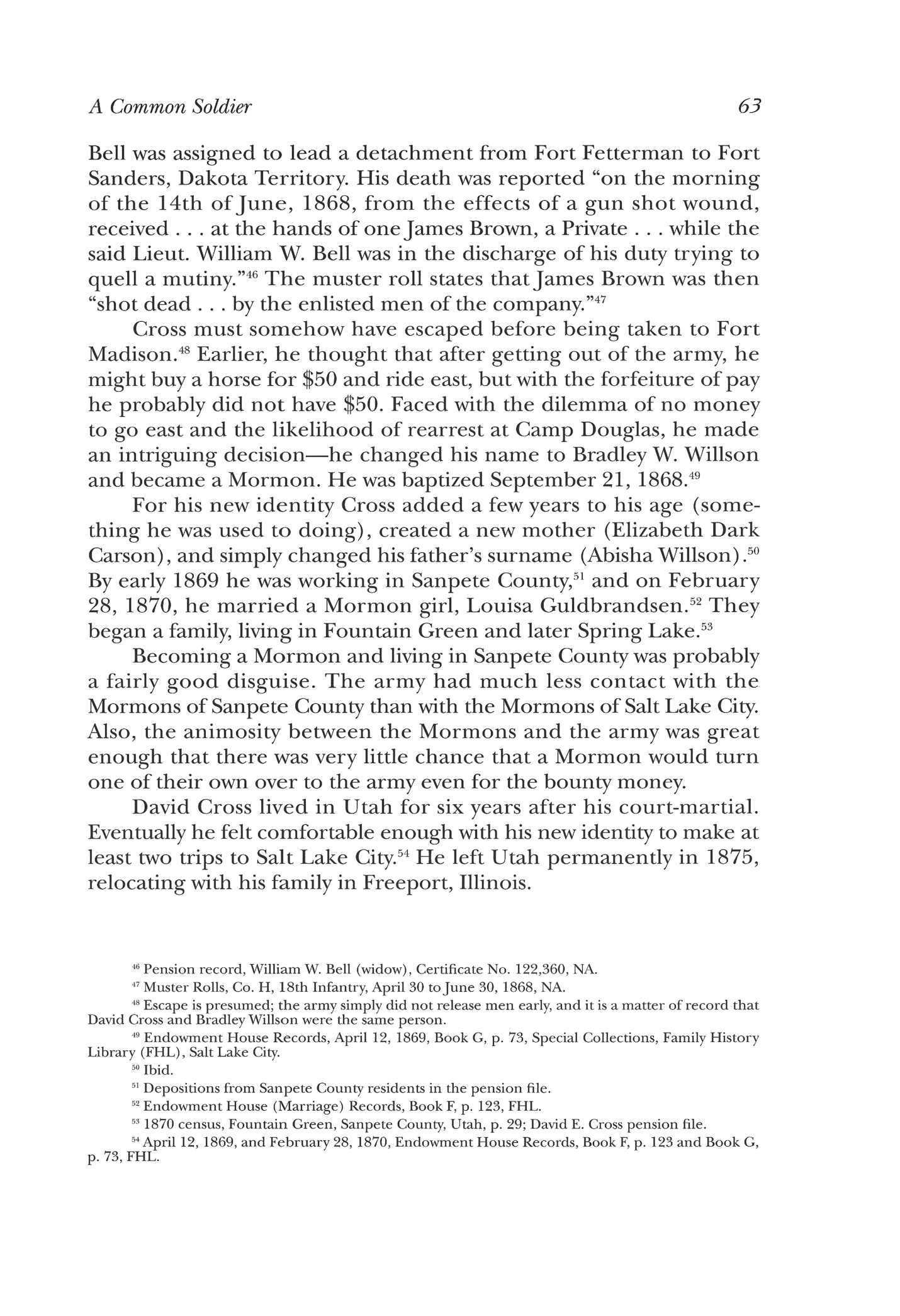
David Cross lived in Utah for six years after his court-martial. Eventually he felt comfortable enough with his new identity to make at least two trips to Salt Lake City.54 He left Utah permanently in 1875, relocating with his family in Freeport, Illinois.
46 Pension record, William W Bell (widow), Certificate No 122,360, NA
47 Muster Rolls, Co. H, 18th Infantry, April 30 to June 30, 1868, NA.
48 Escape is presumed; the army simply did not release men early, and it is a matter of record that David Cross and Bradley Willson were the same person.
49 Endowment House Records, April 12, 1869, Book G, p 73, Special Collections, Family History Library (FHL), Salt Lake City
30 Ibid
51 Depositions from Sanpete County residents in the pension file.
52 Endowment House (Marriage) Records, Book F, p 123, FHL
53 1870 census, Fountain Green, Sanpete County, Utah, p 29; David E Cross pension file.
34 April 12, 1869, and February 28, 1870, Endowment House Records, Book F, p. 123 and Book G, p 73, FHL
A Common Soldier 63
The S.S. Sho-Boat: Queen of Utah Lake
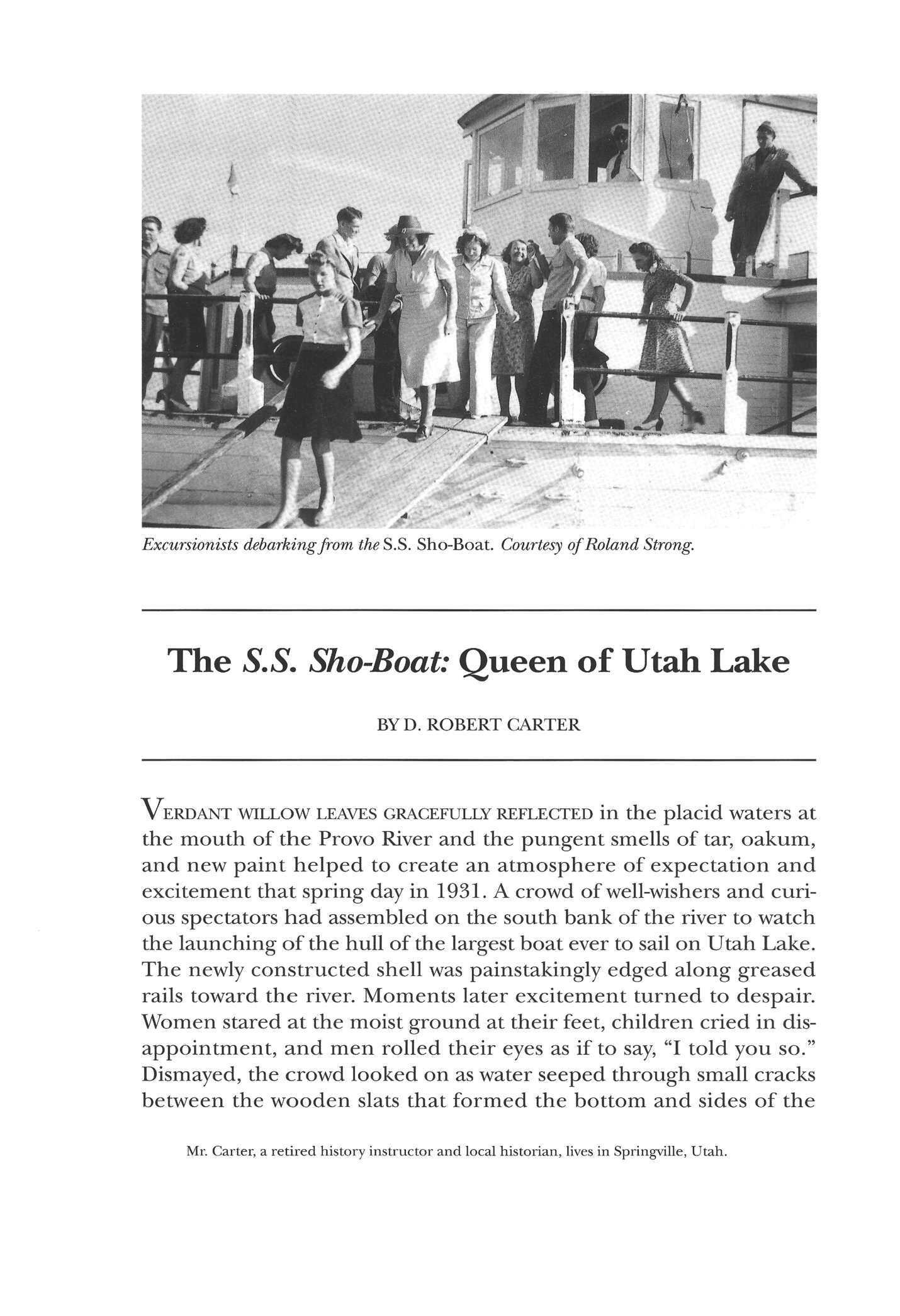 BYD. ROBERT CARTER
BYD. ROBERT CARTER
V ERDANT WILLOW LEAVES GRACEFULLY REFLECTED in the placid waters at the mouth of the Provo River and the pungent smells of tar, oakum, and new paint helped to create an atmosphere of expectation and excitement that spring day in 1931 A crowd of well-wishers and curious spectators had assembled on the south bank of the river to watch the launching of the hull of the largest boat ever to sail on Utah Lake. The newly constructed shell was painstakingly edged along greased rails toward the river. Moments later excitement turned to despair. Women stared at the moist ground at their feet, children cried in disappointment, and men rolled their eyes as if to say, "I told you so." Dismayed, the crowd looked on as water seeped through small cracks between the wooden slats that formed the bottom and sides of the
Excursionists debarking from the S.S Sho-Boat Courtesy of Roland Strong.
Mr Carter, a retired history instructor and local historian, lives in Springville, Utah
The S.S. Sho-Boat 65
boat, and the huge craft sluggishly settled on the shallow bottom of the river. With this inauspicious launching, the career of the S.S. ShoBoat, the most successful excursion boat ever to ply the waters of Utah Lake, began.1
The S.S. Sho-Boat was not the first excursion boat on Utah's largest freshwater lake. In June 1855, when the first Utah Valley settlements were just beginning to develop a look of permanence, the Utah County Court granted John Sanderson, Henry Nelson, Olof Hedenborg, and William Cummings permission to build and launch a boat on Utah Lake for fishing, exploring, and carrying passengers on pleasure trips.2 By the late 1850s there were other small sailboats, primarily used for fishing, on the lake. Emil F. Wurzbach, a young man who for a short time worked at Camp Floyd in the freighting business, mentioned taking pleasure trips on the lake: "While I stayed at Camp Floyd I made several trips to Utah Lake, there was a little town at the lake, [probably Lehi] and the Mormons had some small sail boats. ... I got one of the men to take me out. . . and we sailed around the lake. The water was so clear that I could see fish swimming under us."3 Peter Madsen, Jr., born in 1858, remembered his father's large sailboat that was sometimes used for picnic parties. On occasion a few passengers would take aboard their musical instruments and provide entertainment for the others. LarsJacobson, a sailor from Denmark, piloted the boat which was also used to transport lime and firewood from the west side of the lake to the eastern shore.4
During the next two decades the fleet of small excursion boats slowly grew. For example,John W. Lowell of Salt Lake City had a small steamboat constructed in that city in 1880, taken by rail as far as Pleasant Grove, and launched on Utah Lake in October. The first steamer on Utah Lake, it was only twenty-four feet long and light enough that two or three men could "pick her up and carry her without much trouble." It was used for fishing and duck hunting and could conveniently accommodate from six to ten sportsmen.5
1 Interview with Roland Strong by author and Francis Bowen, Orem, Utah, October 12, 1993, and interview with Norma Smith Wright and Boyd Wright by author, Edgemont, Utah, March 9, 1995; tapes and transcripts of both interviews in author's possession
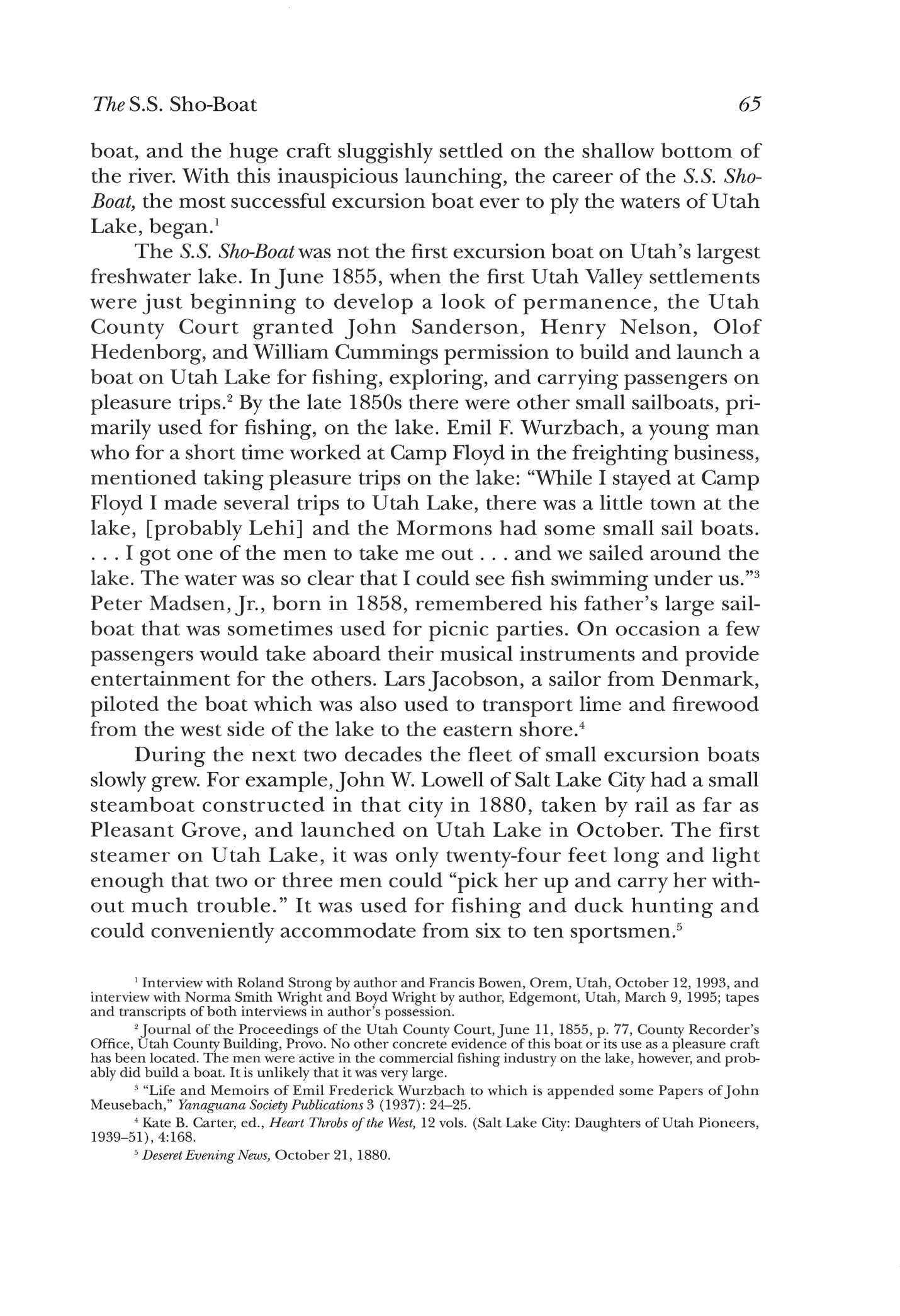
2 Journal of the Proceedings of the Utah County Court, June 11, 1855, p 77, County Recorder's Office, Utah County Building, Provo No other concrete evidence of this boat or its use as a pleasure craft has been located The men were active in the commercial fishing industry on the lake, however, and probably did build a boat It is unlikely that it was very large
3 "Life and Memoirs of Emil Frederick Wurzbach to which is appended some Papers of Joh n Meusebach," Yanaguana Society Publications 3 (1937): 24—25
4 Kate B Carter, ed., Heart Throbs of the West, 12 vols (Salt Lake City: Daughters of Utah Pioneers, 1939-51), 4:168
5 Deseret Evening News, October 21, 1880
Not until the mid-1880s did the idea of using larger pleasure boats on Utah Lake become popular—no doubt influenced by the success of tourist boats on the Great Salt Lake andJordan River. In an effort to attract more tourists to the new beach resorts on Utah Lake, Eastmond 8c Sons of American Fork constructed the steamer Eastmond and launched her on the lake in 1886 before a crowd of about six hundred. The craft was forty feet long by twelve feet wide and was powered by a small upright steam engine and two paddle wheels. It could carry up to one hundred twenty-five passengers and cruised at a typical speed of seven miles per hour. From its home port at the mouth of the American Fork River it made runs to such popular places on the lake as Pelican Point, Geneva Resort, and the bathing establishments near the mouth of the Provo River. Sometimes a band performed for passengers. 6 The Eastmond continued until at least 1891 with some degree of financial success. 7
Several other large excursion boats sailed on Utah Lake before the S.S. Sho-Boat. One of the most notable was the Florence. Colonel C D. Moore and H. H. Bean, superintendent of the Provo City Lumber Company, originated the idea, and Bean secured money from Denver investors to construct a boat. Moore, an experienced boat builder, drew up the plans and engineered its construction. The boat, which cost about $6,500, was constructed at the Sun Foundry in Provo where local citizens enjoyed dropping by to watch. The keel was made of white ash and the rest of the craft from Tennessee white oak. Fiftyfive feet from stem to stern with a twelve-foot beam, the Florence could carry one hundred fifty passengers. In addition to excursions, the boat's owners planned to ferry passengers from Battle Creek Station near Pleasant Grove across the lake to connect with the stage line to Eureka and to haul ore from the mines near Eureka to the railroad lines in Utah Valley The Florence was launched in April 1891 It completed many pleasure voyages that summer, but the plan for freight and passenger service to the Tintic area was not very successful, and the railroad connection between Eureka and Springville, completed in December 1891, ended the Tintic business. Unable to make enough money on pleasure cruises alone, the owners of the Florence sold the boat in June 1892 to C. S. Wilkes and A. M. Wood of Salt

66 Utah Historical Quarterly
6 Salt Lake Daily Herald, August 11, 28, 1886
7 Lehi Banner, Jun e 19, 1891 A smaller steamer, the Eastman, was constructed in and operated out of American Fork Built by L A Robert for $1,500 and launched in the summer of 1889, it accommodated some seventy-five passengers Little is known of its career on the lake See Provo Enquirer, Jun e 21, 1889
William M. Wilson's Reanon W, 1914, with a party of druggists. Courtesy of the boat owner's son, Bill Wilson.
Lake City who transported her to Great Salt Lake by rail and launched her that summer Renamed Talula, she provided pleasure trips at Garfield in 1892 and by 1894 was being successfully operated out of Saltair.8
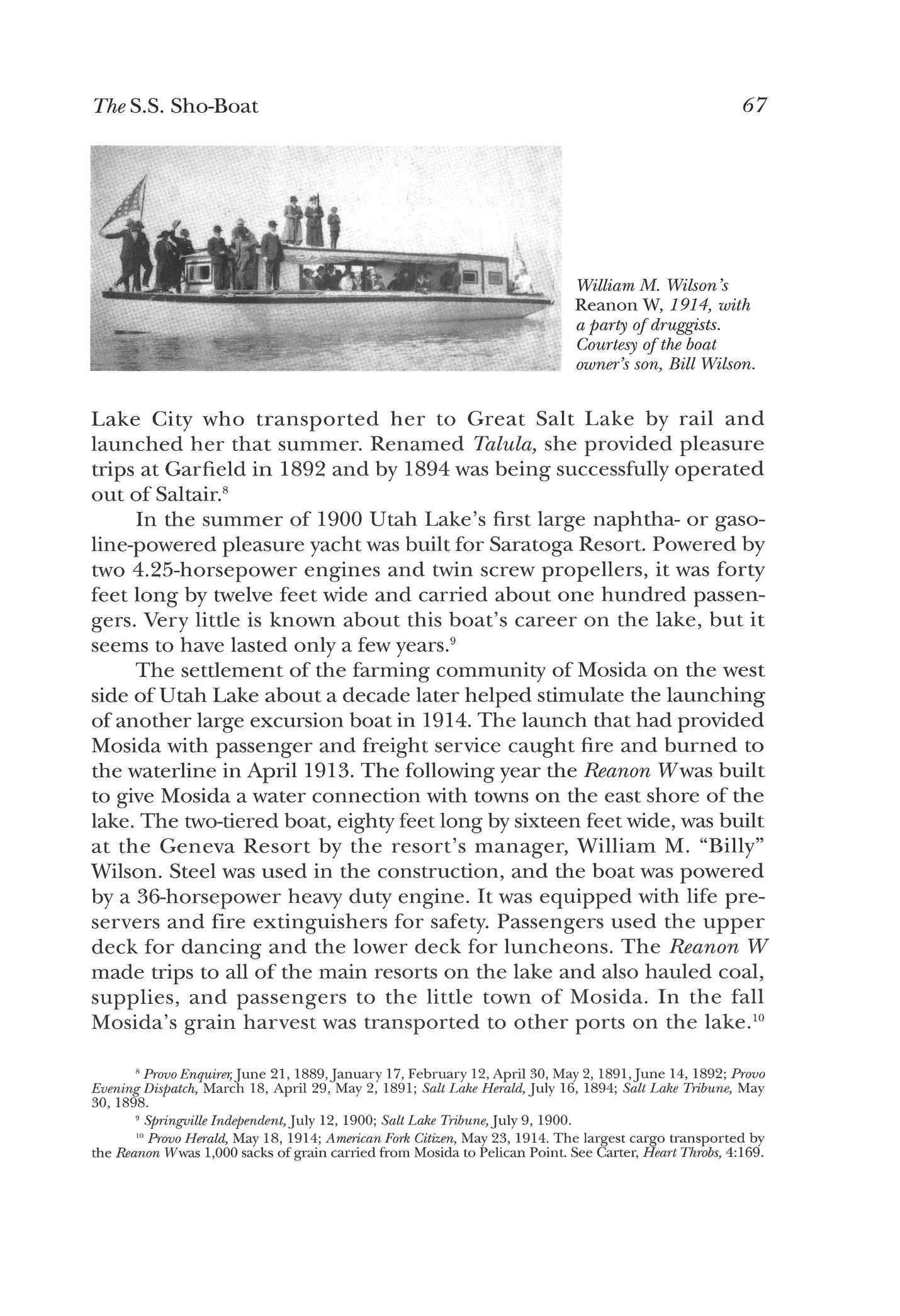
In the summer of 1900 Utah Lake's first large naphtha- or gasoline-powered pleasure yacht was built for Saratoga Resort. Powered by two 4.25-horsepower engines and twin screw propellers, it was forty feet long by twelve feet wide and carried about one hundred passengers Very little is known about this boat's career on the lake, but it seems to have lasted only a few years. 9
The settlement of the farming community of Mosida on the west side of Utah Lake about a decade later helped stimulate the launching of another large excursion boat in 1914 The launch that had provided Mosida with passenger and freight service caught fire and burned to the waterline in April 1913. The following year the Reanon Wwas built to give Mosida a water connection with towns on the east shore of the lake. The two-tiered boat, eighty feet long by sixteen feet wide, was built at the Geneva Resort by the resort's manager, William M. "Billy" Wilson. Steel was used in the construction, and the boat was powered by a 36-horsepower heavy duty engine. It was equipped with life preservers and fire extinguishers for safety Passengers used the upper deck for dancing and the lower deck for luncheons The Reanon W made trips to all of the main resorts on the lake and also hauled coal, supplies, and passengers to the little town of Mosida. In the fall Mosida's grain harvest was transported to other ports on the lake.10
8 Provo Enquirer, June 21, 1889, January 17, February 12, April 30, May 2, 1891, June 14, 1892; Provo Evening Dispatch, March 18, April 29, Mav 2, 1891; Sail Lake Herald, July 16, 1894; Salt Lake Tribune, May 30, 1898
9 Springville Independent, July 12, 1900; Salt Lake Tribune, July 9, 1900
10 Provo Herald, May 18, 1914; American Fork Citizen, May 23, 1914 The largest cargo transported by the Reanon Wwas 1,000 sacks of grain carried from Mosida to Pelican Point See Carter, Heart Throbs, 4:169
The S.S. Sho-Boat 67
Although the excursion business was good, the passenger and freighting business faded as Mosida was slowly abandoned by its farmer tenants The craft was then remodeled to serve solely as an excursion boat. It was shortened to sixty-five feet in length, and the rail and seats were removed from the upper deck. The Reanon Wwas used on the lake until at least 1917.n
Then, during the next decade and a half, a small fleet of gasolinepowered launches capable of carrying thirty or more passengers gave pleasure seekers a chance to sail on the lake, but not until 1932, with the advent of the S.S. Sho-Boat, could people experience cruising on the lake in a large excursion boat again.
Two imaginative and mechanically gifted friends, born and raised in Utah Valley, planned and built the Sho-Boat. Hewitt Strong left his studies at Brigham Young University to enlist in the armed forces when the United States entered World War I in April 1917. He served twenty-one months as an airplane mechanic in the 138th Aero Squadron with overseas duty in England, Scotland, France, and Germany.12 He developed into an excellent mechanic who had the confidence to construct or fix almost anything. When he returned to civilian life he was hired as a mechanic at an automotive garage, Telluride Motor, in Provo When a badly wrecked seven-passenger Paige automobile was towed into the garage, Hewitt bought it and embarked on his first large solo mechanical project. He rebuilt the car into a one-of-a-kind roadster that he covered with imitation alligator hide. Christened The Bug, it had a front seat plus a rumble seat but no top, no doors, and no running boards. It did, however, have steps on the outside to help passengers climb over the side and into the deeply set seat.13
Elmer Smith also loved to work with mechanical objects. Even though his formal education did not extend past the third grade, he could do almost anything with his hands. He helped with his father's business, worked on the family farm, labored for Provo City, and learned to repair airplanes. His daughter described him as a daredevil playboy who taught himself how to fly and later even tried flying blindfolded. He sometimes attracted attention on parade days by being blindfolded and driving the mayor down Provo's major streets.14
11 Provo Herald, August 14, 1916
12 Etta Sears Simmons Strong, "I'm a Damn Cute Kid!" personal history in the possession of Roland Strong, Orem, Utah
13 Ibid
14 Wright interview, March 9, 1995

68 Utah Historical Quarterly
Elmer's father, Henry Smith, owned and operated a pool hall on the corner of Center Street and First West, almost directly across the street south from Telluride Motor. That made it convenient for the two friends to cooperate on their first big mechanical project.
Since Hewitt missed the thrill of being overseas and Elmer was always looking for excitement, they wanted to create something new—the first motorized ice boat on Utah Lake. Elmer arranged for the acquisition of a new 9-cylinder, 80-horsepower Le Rhone airplane engine. The friends worked after hours to mount the engine, complete with a propeller, on a pair of sturdy sleigh-like runners. Behind the engine they built a frame cockpit covered with canvas that could carry five or six passengers. The eighteen-foot-long vehicle was steered by a third runner and a large rudder that resembled the tail of an airplane. There was one major problem, however, the vehicle had no brakes This necessitated careful driving, to say the least In January 1924 the men took it to Utah Lake, spun the propeller, and
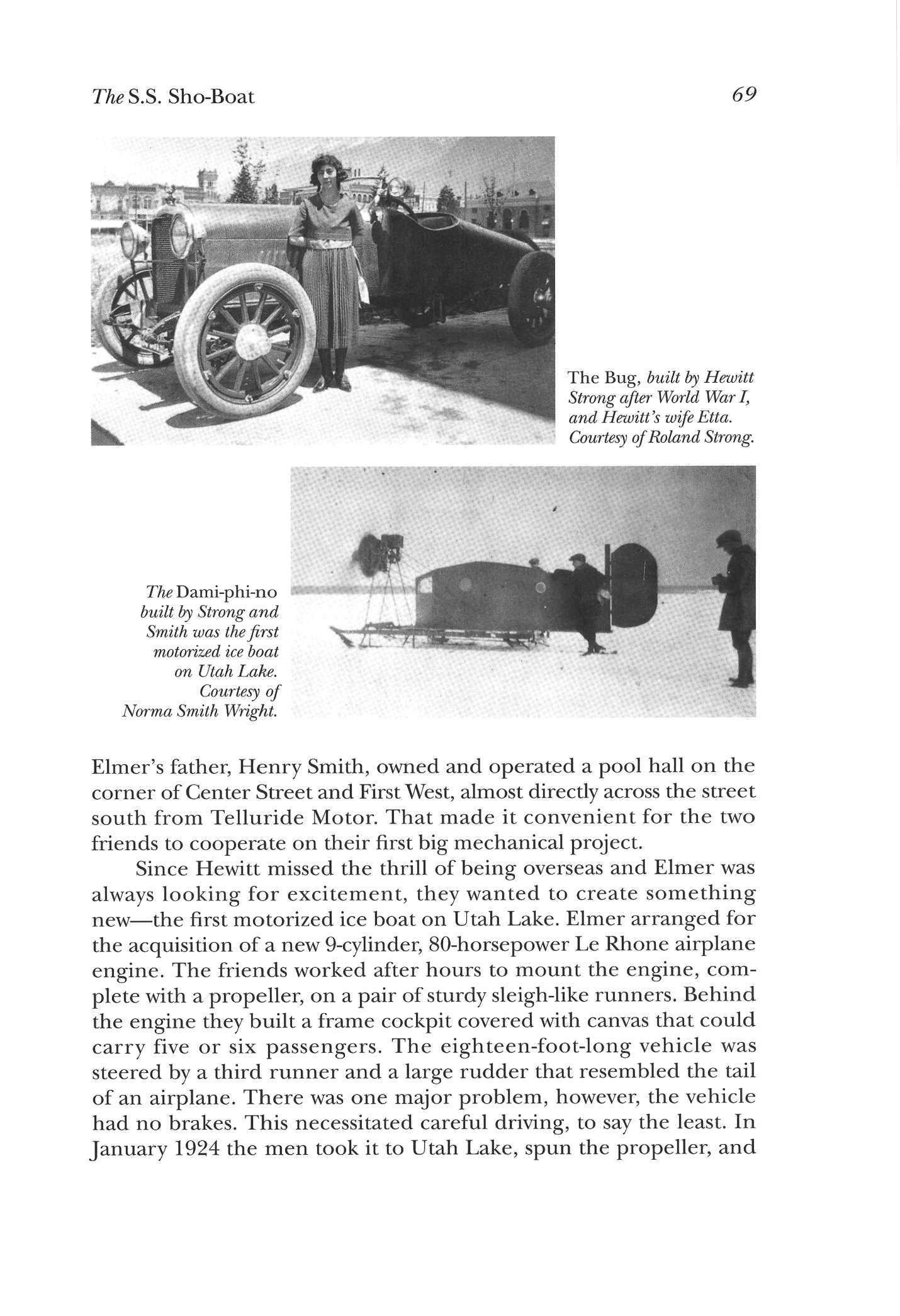
The S.S. Sho-Boat 69
The Bug, built by Hewitt Strong after World War I, and Hewitt's wife Etta. Courtesy ofRoland Strong.
The Dami-phi-no built by Strong and Smith was the first motorized ice boat on Utah Lake. Courtesy of Norma Smith Wright.
the awkward-looking creation skimmed across the ice and snow covered lake at speeds of nearly sixty miles per hour on its test run. Hewitt estimated that on smooth ice with no snow speeds of eighty miles per hour or even higher could be achieved. By the end of March the men had made four successful trips to the lake When snow covered the roads they drove the craft to the lake on its own power. A reporter who covered one trip asked Hewitt what the strange vehicle was called. The reply was, "Damned if I know." The journalist, who also taught at BYU, discreetly modified the name for use in his article in the Deseret News, and from that time on the unique creation was known as the Dami-phi-no. In the summer the friends attached the craft to a platform flanked on each side by pontoons and used it on the water.15
Both men spent countless recreational hours at Utah Lake They not only skimmed across its ice and boated on its waters, but they hunted, fished, and water skied there also. They loved the lake and wondered why it was not more heavily used by others. Something needed to be done to promote the lake as a recreational mecca. During the next few years plans for a larger project took form in their minds. Hewitt thought that ".. . a summer boat would pay for itself by carrying passengers to points of interest surrounding the lake."16 Elmer agreed; they would build an excursion boat. They envisioned no ordinary pleasure boat, but the largest, safest, most luxurious craft ever to operate on Utah's Sea of Galilee.17 And they could do it all themselves!

Most of the previous large excursion boats on Utah Lake were built during times of hope and prosperity. But the early 1930s were depression years, and to further complicate the situation Utah was in the middle of a drought. The level of Utah Lake was receding each year. Finding the money to built a pleasure boat during these times would, indeed, prove to be a problem But a solution was at hand Hewitt had received a larger than normal endowment insurance policy at the end of World War I since he had spent a long time overseas. To help finance the project, he applied for and received a loan
15 Strong interview, October 12, 1993; "Strange Craft Makes Its Appearance on Utah Lake," Deseret News, March 1, 1924 Shortly after the completion of Dami-phi-no Elmer built himself a small inboard wooden motorboat named It for cruising, not racing, on the lake Wright interview, March 9, 1995
16 Deseret News, March 1, 1924.
17
70 Utah Historical Quarterly
Pioneer Utahns were fond of comparing the Great Salt Lake, Jordan River, and Utah Lake with the Dead Sea, Jordan River, and Sea of Galilee in the Holy Land Some older residents of Utah Valley still think of Utah Lake as Utah's Sea of Galilee
against the policy Elmer borrowed money from his father to pay his share.18
18 Strong interview, October 12, 1993; Wright interview, March 9, 1995 Congress passed the Adjusted Compensation Act in 1924. It provided each veteran with an insurance policy that would mature in twenty years When the depression came Congress passed, over President Hoover's veto, a bill that allowed veterans to borrow up to half the amount of the face value of their policies at 4 percent interest
See Gene Smith, The Shattered Dream: Herbert Hoover and the Great Depression (New York: William Morrow & Co., 1970), p 127 See also Provo Evening Herald, February 28, March 3, 1931

The S.S. Sho-Boat 71
Left: Hewitt Strong and Elmer Smith at work on their boat. Courtesy of Norma Smith Wright.
Below: The S.S Sho-Boat under construction. Courtesy of Roland Strong.
Together the two men made plans and drew blueprints for their boat, with the better-educated Hewitt doing the complicated math. On the south side of Provo River near its mouth, they cleared a relatively flat area of brush and roughly leveled it for the construction site. They created a slightly elevated platform made of iron rails on which the bottom of the boat would be constructed. As the wood they had ordered began to arrive, it was piled nearby in stacks. Actual construction began in the spring of 1931. Most of the work was done with handsaws, hammers, screwdrivers, augers, and other hand tools after a full day on their regular jobs. Fortunately, some of their friends pitched in and helped, for the project was massive. Plans called for a boat ninety feet long and twenty-two feet wide Since the lake is very shallow in places, and the boat would occasionally have to sail in water only twelve to fourteen inches deep, a flat-bottomed design that would displace less water had been agreed upon. Five ninety- foot long floor joists were constructed by nailing and gluing together three two by sixes One joist ran along each side of the boat, and three others formed the interior frame. The wooden slats that formed the bottom of the boat were bolted to these joists, the cracks between the slats were caulked with oakum, and then the entire bottom was coated with tar. Then the partners faced the difficult task of turning the huge platform completely over so work could begin on the superstructure.19 With a solid timber beam about twelve by twentytwo inches and forty feet in length secured in place as an interior keel, the men built the sides of the boat and framed the large cabin area.
At this point the boat was launched into the river where it sank in the shallow water. Elmer later recalled that people thought he was crazy for building a boat that would not float, but he and Hewitt knew it would sink. After a few days in the water the wood would swell and make the joints water tight. Then the men went to work with pumps and pails to remove the water and raise the boat From that time until it was beached in the mid 1940s, there was rarely a problem with leakage. A bilge pump installed in the rear of the boat removed the small amount of water that seeped in.
As the boat sat in the river, work continued on the cabin area. It was closed in so the men could finish the interior during the winter. Before laying the floor, Elmer and Hewitt drilled ten to fifteen sets of

72 Utah Historical Quarterly
19 The feat was accomplished with the use of huge poles and a block and tackle system
consecutive holes through the side of the interior beam at intervals of ten feet. They then strung one-and-a-half inch cables through each of the holes, pulled them tight, and securely fastened them at each side of the boat to keep the craft tightly snugged together from side to side As a further precaution against separation, an additional cable was run from bow to stern on each side. In later years an engineer commented that the boat was overbuilt, stating that the cables were not necessary Perhaps not, but they certainly made the co-owners and passengers feel more secure.
The boat was initially powered by a large diesel engine, but it was excessively noisy and caused too much vibration. The men replaced it with two Buick straight-eight engines complete with transmissions that had three forward gears and reverse The partners equipped the boat with twin rudders and propellers that could be raised and lowered according to the depth of the water. The propellers were cast at Provo Foundry which also manufactured the other brass and bronze fittings for the boat. Later, when they discovered that winds caused the boat to drift sideways while entering the river, the ingenious duo solved the problem by adding two large rudders, one on each side of the bow, secured by a pivot point. Lowering the rudder on the leeward side compensated for the wind, and the boat could steer a steady course up the river. A winch raised and lowered the rudders.
The boat had some additional interesting features: A thirty-two volt gas generator provided power for the lights andjuke box An oldfashioned crank telephone connected the helm with the motor room. A siren and big lights on the bow were run by individual heavy-duty batteries. The boat was equipped with two anchors. One was a regular "T" type anchor; the other was a flat-blade anchor that worked better in the mud The anchors were only used during the most dangerous storms.20
Elmer and Hewitt constructed the helm with care Their command post was located in the forepart of the enclosed cabin area in full view of the passengers. A large window gave the commodores a grand view of the lake they loved Here the commodores would control the speed of the boat and steer it, using the elegant ship's wheel.

The S.S. Sho-Boat 73
20 Strong interview, October 12, 1993; Wright interview, March 9, 1995 Analysis of the step-by-step pictures of the construction of the boat taken by Hewitt Strong proved invaluable in helping the author form a concept of how the boat was put together
Envisioning the boat as a center of entertainment, they included features to encourage dancing and performing Immediately behind the helm area and facing the back of the boat was a raised platform
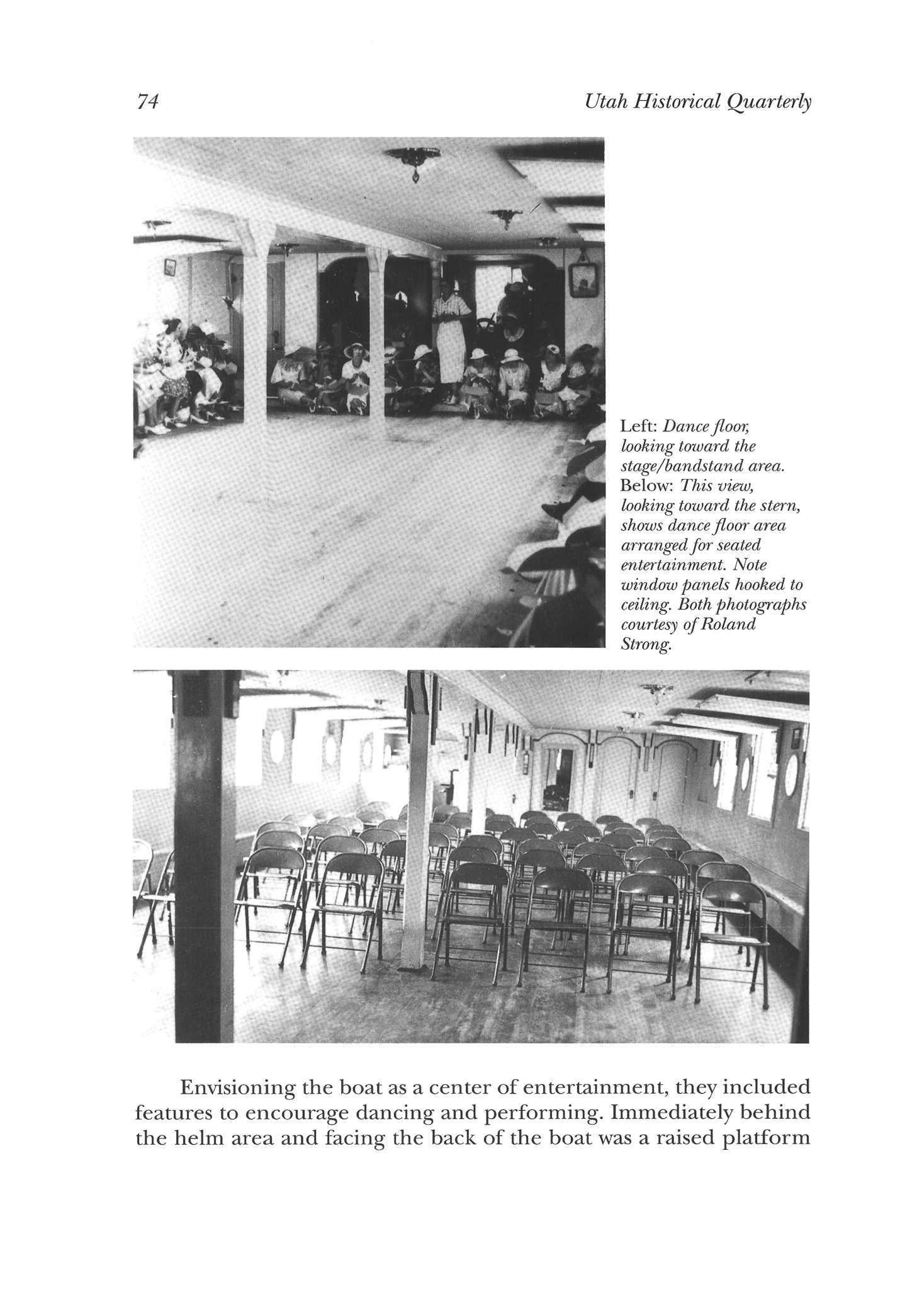
74 Utah Historical Quarterly
Left: Dance floor, looking toward the stage/bandstand area.
Below: This view, looking toward the stern, shows dancefloor area arranged for seated entertainment. Note window panels hooked to ceiling. Both photographs courtesy of Roland Strong.
The S.S. Sho-Boat 75
for use as a stage and bandstand It was equipped with a curtain that could be opened and closed during performances and a piano. A large (twenty-two by forty-four feet) dance floor of tongue-and-groove oak extended from the stage almost to the stern. Posts down the middle of the floor supported the upper deck. Benches lined the two sides. The walls behind the benches were composed of alternate solid panels and panels with windows. The solid panels were hinged at the top and could be opened and hooked to the ceiling to provide ventilation on stuffy evenings. Small rooms across the back of the boat contained a kitchen area from which food, drinks, and souvenirs were sold; bathrooms, which, incidentally, drained into the lake; and the motor room, the door to which was seldom opened because of the engine noise. On the starboard side near the front of the cabin's outside wall stairs led to the upper deck. This deck, surrounded by a heavy rail, could be used for observation or dancing Passengers preferred dancing on the main deck, however, since the floor of the upper deck was covered with tar paper. Benches were later added around the perimeter of this level.21
From the very beginning the people of Utah Valley showed great interest in the building of the large boat. As construction neared completion, their curiosity peaked. On Sunday, March 27, 1932, they were given a chance to inspect the inside of the boat. That day over five hundred people toured the boat. With so many people milling around, the workmen had to stop working and act as tour guides on the second largest boat ever launched in Utah.22
After about a year of diligent labor, the men took their boat on a few short trial runs and then prepared for the craft's first official cruise on April 11, 1932. Her first customer was the Utah State Dentists' Association which was holding its annual convention in Provo The group held its concluding meeting on the boat As the dentists came on board that Monday evening they were greeted by Elmer and Hewitt in their commodore's uniforms and their wives, Elma and Etta, wearing dresses designed to look like sailor suits. It became a custom for the owners and their wives to wear nautical uniforms during all of their cruises. At 6:30 P.M. the trip, a relatively short one to Skipper's Bay and back, began. As they pulled out of the mouth
 21 Wright interview, March 9, 1995, provided a detailed description of the interior of the boat Pictures taken by Hewitt Strong again proved very valuable See also Provo Evening Herald, August 4, 1932 A ladder near the door of the motor room also led to the upper deck 2s provo Evening Herald, April 1, 1932 Only the General Garfield on the Great Salt Lake in the late nineteenth century was larger.
21 Wright interview, March 9, 1995, provided a detailed description of the interior of the boat Pictures taken by Hewitt Strong again proved very valuable See also Provo Evening Herald, August 4, 1932 A ladder near the door of the motor room also led to the upper deck 2s provo Evening Herald, April 1, 1932 Only the General Garfield on the Great Salt Lake in the late nineteenth century was larger.
of the Provo River, The Third Molar, a sailboat owned by dentist Earl Reynolds, pulled across the front of the large pleasure boat providing the passengers with a "beautiful evening-glow picture"23 as its silhouette reflected from the darkening waters of the lake.
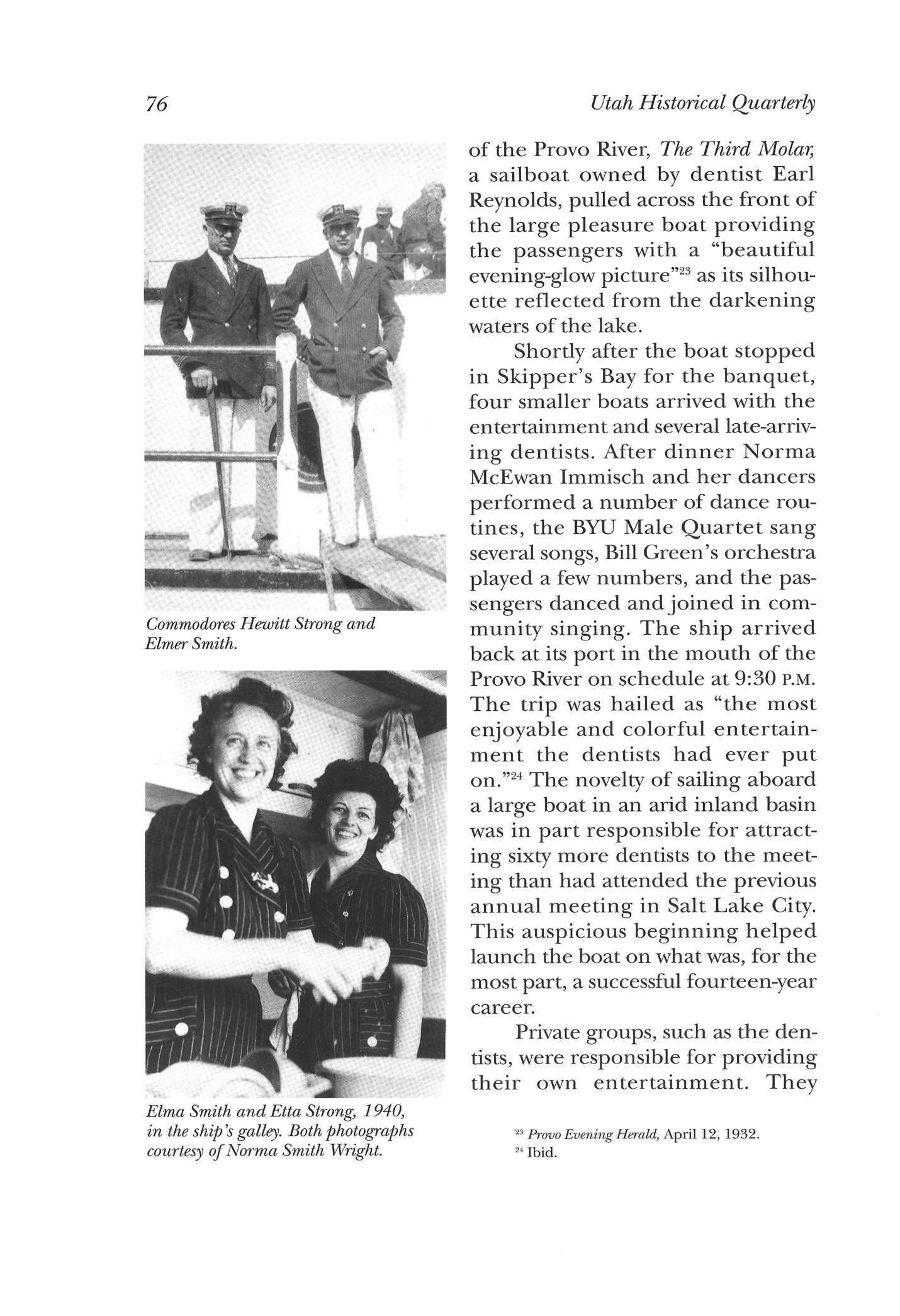
Shortly after the boat stopped in Skipper's Bay for the banquet, four smaller boats arrived with the entertainment and several late-arriving dentists After dinner Norma McEwan Immisch and her dancers performed a number of dance routines, the BYU Male Quartet sang several songs, Bill Green's orchestra played a few numbers, and the passengers danced and joined in community singing The ship arrived back at its port in the mouth of the Provo River on schedule at 9:30 P.M. The trip was hailed as "the most enjoyable and colorful entertainment the dentists had ever put on."24 The novelty of sailing aboard a large boat in an arid inland basin was in part responsible for attracting sixty more dentists to the meeting than had attended the previous annual meeting in Salt Lake City. This auspicious beginning helped launch the boat on what was, for the most part, a successful fourteen-year career.
Private groups, such as the dentists, were responsible for providing their own entertainment. They
76 Utah Historical Quarterly
Commodores Hewitt Strong and Elmer Smith.
Elma Smith and Etta Strong, 1940, in the ship's galley. Both photographs courtesy of Norma Smith Wright.
23 provo Evening Herald, April 12, 1932. 24 Ibid
hired bands, dancers, singing groups, vaudeville acts, etc. On these trips dancing was popular, and the roll of the ship sometimes made dancing exciting and often resulted in the creation of new dance steps After each evening of dance the floor was mopped, sparkles thrown on it, and a bale of hay dragged up and down it to make the floor slick for the next customers.
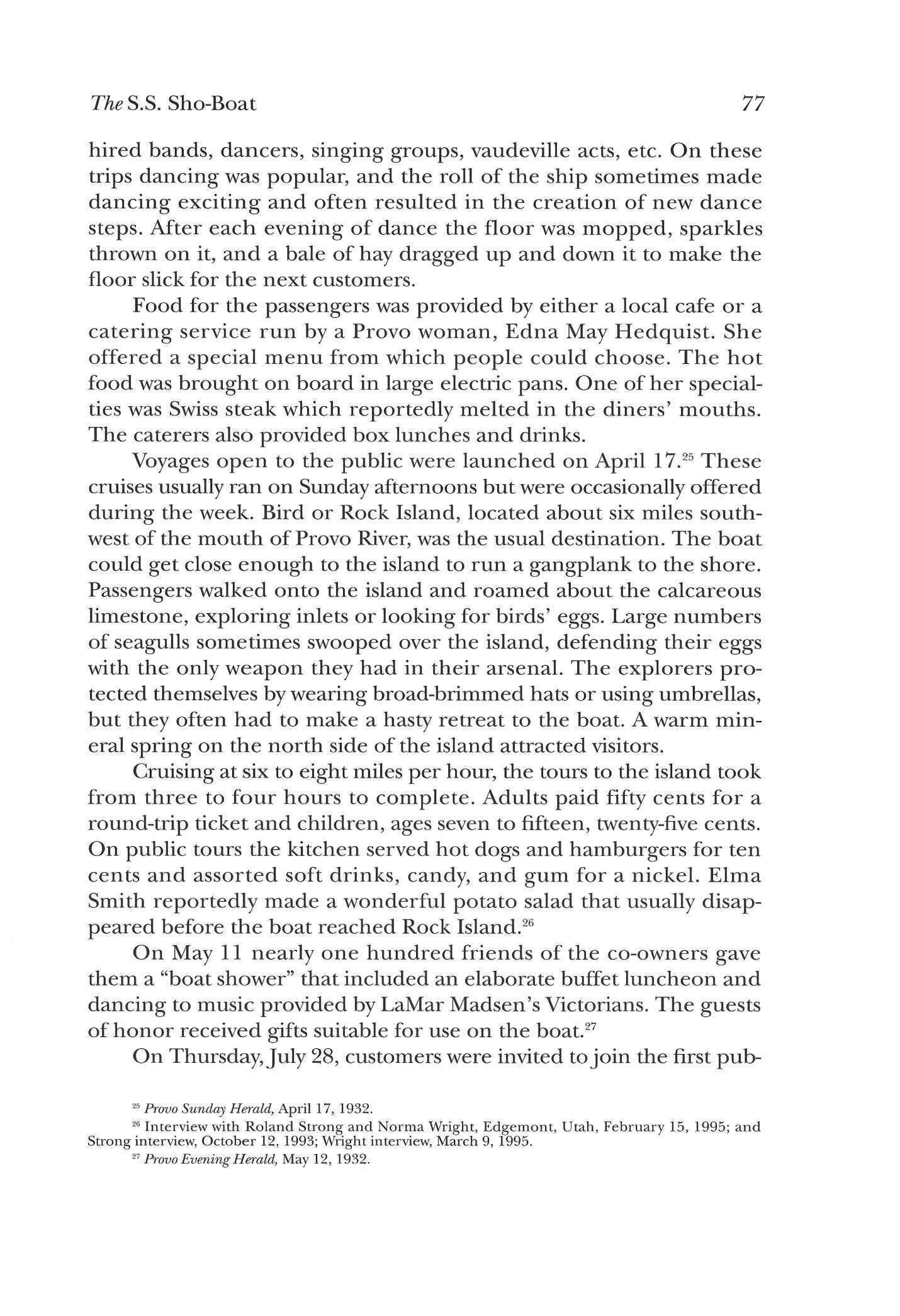
Food for the passengers was provided by either a local cafe or a catering service run by a Provo woman, Edna May Hedquist. She offered a special menu from which people could choose. The hot food was brought on board in large electric pans One of her specialties was Swiss steak which reportedly melted in the diners' mouths. The caterers also provided box lunches and drinks.
Voyages open to the public were launched on April 17.25 These cruises usually ran on Sunday afternoons but were occasionally offered during the week. Bird or Rock Island, located about six miles southwest of the mouth of Provo River, was the usual destination. The boat could get close enough to the island to run a gangplank to the shore. Passengers walked onto the island and roamed about the calcareous limestone, exploring inlets or looking for birds' eggs. Large numbers of seagulls sometimes swooped over the island, defending their eggs with the only weapon they had in their arsenal The explorers protected themselves by wearing broad-brimmed hats or using umbrellas, but they often had to make a hasty retreat to the boat. A warm mineral spring on the north side of the island attracted visitors.
Cruising at six to eight miles per hour, the tours to the island took from three to four hours to complete. Adults paid fifty cents for a round-trip ticket and children, ages seven to fifteen, twenty-five cents. On public tours the kitchen served hot dogs and hamburgers for ten cents and assorted soft drinks, candy, and gum for a nickel. Elma Smith reportedly made a wonderful potato salad that usually disappeared before the boat reached Rock Island.26
On May 11 nearly one hundred friends of the co-owners gave them a "boat shower" that included an elaborate buffet luncheon and dancing to music provided by LaMar Madsen's Victorians. The guests of honor received gifts suitable for use on the boat.27
On Thursday,July 28, customers were invited tojoin the first pub-
17, 1932.
77
The S.S. Sho-Boat
25
provo Sunday Herald, April
26 Interview with Roland Strong and Norma Wright, Edgemont, Utah, February 15, 1995; an d Strong interview, October 12, 1993; Wright interview, March 9, 1995. 27 Provo Evening Herald, May 12, 1932.
lie cruise and dance held on the boat. The dance started at 9 P.M., and the boat left the wharf at 10 o'clock. Vaudeville numbers provided entertainment. The couples enjoyed good music and danced in romantic surroundings under the stars for seventy-five cents.28 Unfortunately, thieves also enjoyed the summer nights, and dance cruise customers reported items stolen from automobiles they had parked near the boat dock. The cruise operators asked the police to patrol the beach on dance nights.29
During the rest of the 1932 season, the boat continued its public tours and was chartered by private groups like the Vikings and the Nuggets—BYU social units—the Provo Chamber of Commerce, the Lion's Club, and a salesmen's group. All sorts of people and groups as widely varied in personality and purpose as church parties and drinking parties felt at home on the ship's deck or in its cabin.30 Money was difficult to come by during the early 1930s, but people seemed willing to spend it for a ride on the boat. For many the voyage provided a rare chance to ride in what they considered, in those humble times, the lap of luxury. The average dancing group numbered about eighty couples, and occasionally the number of passengers on a regular tour neared the maximum of two hundred fifty. A 1938 trip taken to Rock Island by BYU summer school students may have included three hundred—probably the largest group ever to ride the boat.31
Until 1933 the boat was called "The Smith-Strong Yacht" or "The Ship" but had no formal name. By the beginning of her second season she was officially known as the Smith-Strong Showboat.32 The next year the spelling was shortened to S.S. Sho-Boat, the name she carried for the rest of its career. 33
The crew usually consisted of five to eight people who were often members of the Smith and Strong families. Hewitt and Elmer controlled the operation of the boat, and their wives and Elmer's daughter Norma served as hostesses and took charge of the food An additional person was needed in the motor room In later years this position was usually filled by Hewitt's sons, Hewitt Jr. and Roland or, occasionally, Norma. On some cruises the crew included a bouncer to
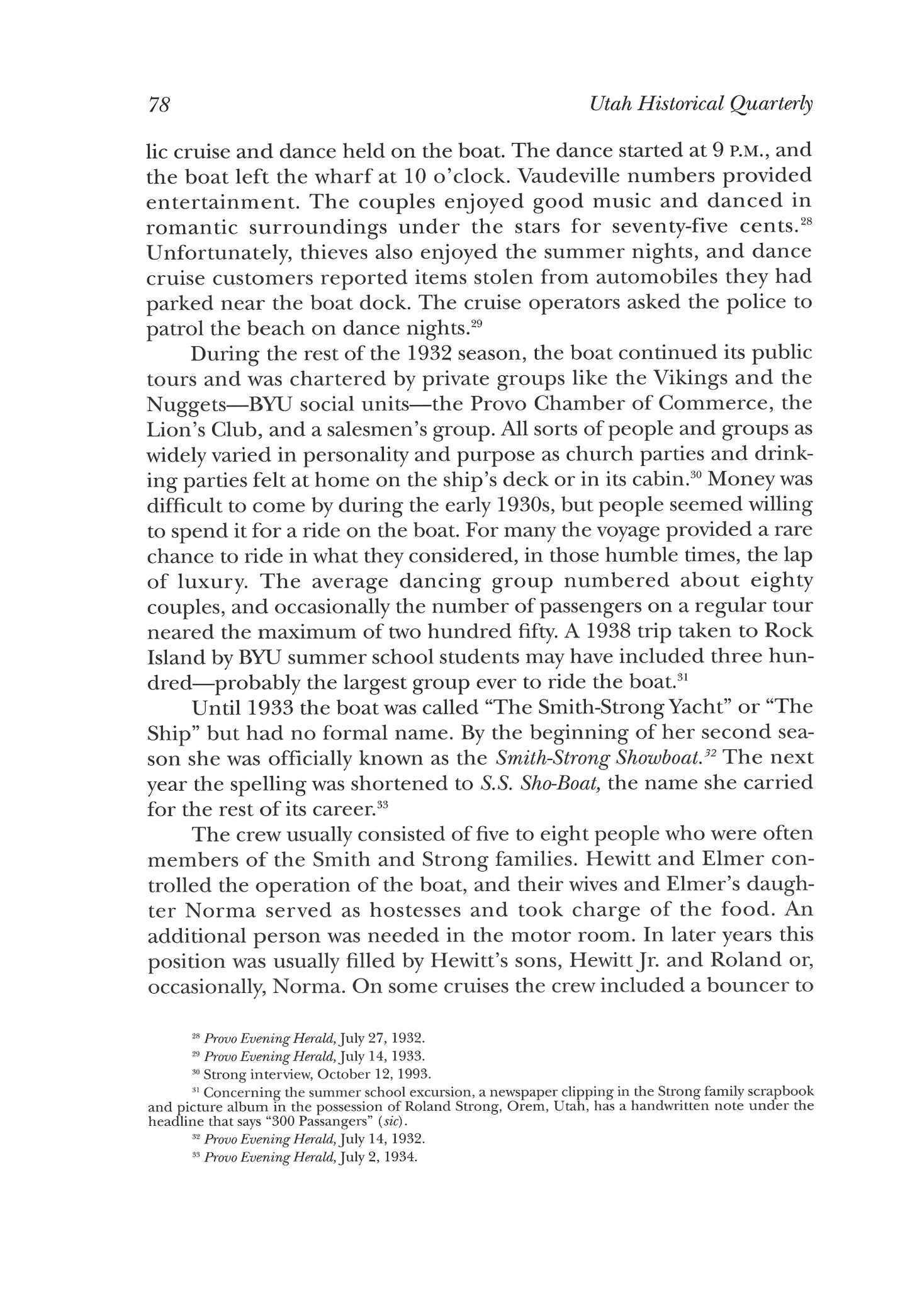
28 Provo Evening Herald, July 27, 1932
29 Provo Evening Herald, July 14, 1933
30 Strong interview, October 12, 1993
31 Concerning the summer school excursion, a newspaper clipping in the Strong family scrapbook and picture album in the possession of Roland Strong, Orem, Utah, has a handwritten note under the headline that says "300 Passangers" (sic).
32 provo Evening Herald, July 14, 1932
33 provo Evening Herald, July 2, 1934
78 Utah Historical Quarterly
handle any disorderly people. Generally the passengers were well behaved, but once in a while someone would have a bit too much to drink and would need some strong-arming to settle him back down. A man on one voyage argued with his wife and decided to drown himself He jumped overboard and was promptly rescued by Elmer The process was repeated. When the man jumped into the lake for the third time, Elmer was thoroughly disgusted and yelled at him to go ahead and drown The man reconsidered and swam back to the boat.34 Another man with the same problem was rescued twice and then knocked out and locked in the closet with the life preservers until shore was reached.35
Because a large boat requires continual upkeep and repair, the men needed a shop near the dock They acquired an old carnival wagon, twenty-five feet long by eight feet wide, and hauled it to the mouth of the river. The wagon was used as a machine and repair shop as well as a storage area. At first it sat too high off the ground. Roland Strong remembered digging four holes to accommodate the huge wheels and lower the wagon's height The old carnival wagon made a somewhat bizarre looking but convenient shop.36
One of the most serious problems faced by the owners of the S.S. Sho-Boat in its fledgling career was the long period of drought that adversely affected the level of Utah Lake through the mid-1930s. In 1933 the Provo River became very narrow and shallow, and a bar formed across its mouth, making it difficult to move the boat onto the lake. The owners needed a different area from which to launch it. The beaches of the lake sloped so gradually that the water remained shallow quite a distance from shore. Although the boat could operate in shallow water, it could not get close enough to shore to allow passengers to board A sandy, elevated spit ran out into the lake seven or eight hundred feet south of the mouth of the Provo River. The partners decided to build a pier about a hundred feet long from the sand spit out into water deep enough to dock the boat. They built the first stretch of the pier by securing planks to the tops of gradually ascending sawhorses; but the last twenty-five feet of its length had to be strong enough to provide a secure mooring for the boat. Elmer and Hewitt had to devise a way to sink telephone poles deep enough into the lake bottom to hold the weight of the boat Again, they produced
34 Wright interview, March 9, 1995
35 Strong interview, October 12, 1993.
30 Strong interview, October 12, 1993; Wright interview, March 9, 1995
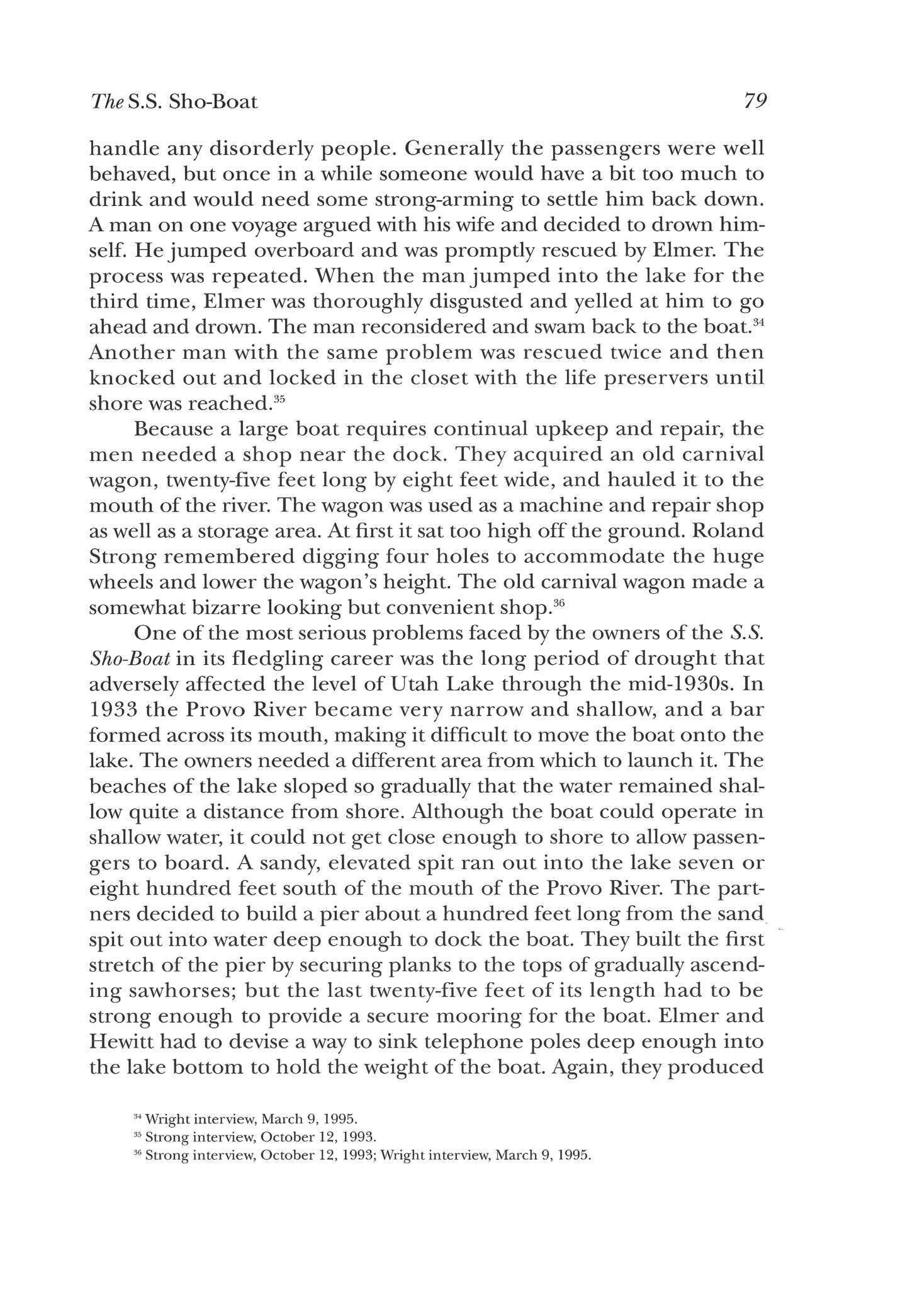
The S.S. Sho-Boat 79
an imaginative solution Using the boat as a working platform, they placed a large water pump, with a fire hose attached, on deck. They tied the nozzle end of the hose to a push-pole about twenty-five feet long and secured both to the bottom end of a telephone pole that was winched into an upright position. When the pump was turned on, the force of water shooting from the nozzle dug into the sand and mud of the lake bottom, creating a hole for the telephone pole. As the pushpole was forced downward, the hole became deeper until the telephone pole reached the desired depth.
Since Elmer and Hewitt were still working at their regular jobs, they again depended on friends to help construct the pier. The men would arrive at the work site, board the boat, change into their bathing suits, and go to work in the water. Although the work was physically demanding, the men managed to have fun, bantering back and forth and occasionally playing practicaljokes.Johnny Barker, one of the men who helped build the pier, worked in a doctor's office, was good looking, and dressed immaculately Hewitt, a car salesman who also liked to be well dressed, sometimes arrived at the pier project later than others, and Johnny would always tease him about it. One day the late-arriving Hewitt furtively boarded the boat. When he walked onto the pier in a good-looking suit,Johnny started kidding him. According to Hewitt's son Roland,

Johnny led out, "We've all been working for hours It's about time you came to work."
'You're always complaining," Hewitt retorted Barker countered, "Well, you're always late."
After some further banter Hewitt exclaimed, "Ah, geeze, fur a nickel I'll justjump in, clothes and all, and work with ya right now!"
"You wouldn't dare! You wouldn't dare! I challenge ya!" Barker quickly replied
To the amazement of Barker and the others, Hewittjumped in, fully dressed. Johnny couldn't stop laughing. It was one of the funniest things he had ever seen. The immaculate Hewitt Strong stood in the water dressed in an expensive suit After a few minutes Hewitt said it was time to change into his swimming trunks and really go to work.
When the evening's work was finished and the men entered the boat to change into their clothes, Johnny was amazed to see Hewitt putting on a dry, pressed, clean suit. When he apprehensively glanced up to the place where he had hung his own suit, he saw a wet, wrin-
80 Utah Historical Quarterly
kled mass draped limply over the hanger Hewitt had worn Johnny's suit when hejumped into the lake.37
The partners used the wharf for at least two seasons. The S.S. ShoBoat continued in operation during the drought, except during 1935 and 1936 when the water wasjust not deep enough for her to cruise.38 In November 1935 Utah Lake contained only 10,000 acre feet of water covering an area of 20,000 acres. The boat was apparently anchored in the mouth of the Provo River where there was a little water. In July 1936, even though the boat could not sail on the lake, it was the scene of a dinner-dance hosted by a group of prominent Provo residents.39 These were definitely difficult years financially for the boat's owners. By the spring of 1937 there was enough water in the lake for the boat to operate, although it was difficult to get over the bar at the mouth of the river. In May the Sho-Boat cruised again to Rock Island.40 This was the beginning of a successful and tightly scheduled summer. People welcomed the boat back, and once more it was making money for the co-owners
Vandalism was another problem the partners faced. In the early years Elmer, his wife Elma, and their daughter lived on the boat in the summer, which proved a good deterrent, but it was impossible to watch the boat all of the time, especially in winter. Break-ins caused damage and loss. Vandals broke pop bottles, damaged the piano, and drained gas from the tank. One winter, in an effort to curb the vandalism, the owners anchored the boat by the warm spring on Rock Island and left the doors open all winter so ice skaters could enter for shelter. The boat was unharmed that year. The owners could find no permanent solution, however, and the men learned grudgingly to expect a certain amount of damage.41
Boating on Utah Lake presented unique challenges and dangers. One was returning the craft to its dock in the river late at night To help the pilot find his way up Provo River in the dark, the owners installed two lights on the south bank: a red light close to the mouth of the river and a green light three or four hundred feet upriver from the docking spot. When the boat was about a half-mile out the skipper would line up
37 Ibid, and Hewitt Strong's photographs of pier construction
38 Strong, "I'm a Damn Cute Kid!"
39 Spanish Fork Press, November 7, 1935; Provo Evening Herald, July 30, 1936. Asearch of local papers turned up no evidence that the boat was operated during 1935-36 Stories about it began appearing again in 1937
40 Provo Evening Herald, May 3, 1937
41 Strong interview, October 12, 1993; Wright interview, March 9, 1995

The S.S. Sho-Boat 81
the red light with the green one, and this would ensure a straight course to the mouth of the river. As the boat moved into the river, he would turn on its spotlights, and, at a signal from the boat, floodlights near the dock were activated The captain was then able to turn the boat around and dock it facing toward the lake for the next tour.42
A major safety concern was fire. Consequently, the owners placed so many fire extinguishers on board that the fire department used to joke about it. The extinguishers in the motor room were glass orbs full of red fluid. If a fire ignited there the orbs were designed to burst and quench it with the fluid In addition to foam spray extinguishers located throughout the ship, the owners had attached a hose to a water pump for use in an emergency. 43 They also kept many life preservers on board. Some were the Mae West style and some the doughnut variety. In an emergency, doors and shutters could be taken off their hinges and used as floats.44
Sailors often encounter strong winds on Utah Lake Smith and Strong found that during the afternoon the wind usually came from the northwest and moved toward Spanish Fork Canyon. Then there would be a period of calm before the wind reversed, blowing out of the canyon and across the lake to the northwest. The men tried to schedule their afternoon tours so that most of their sailing could be done during the calm period. When the wind began to blow out of Spanish Fork
42 Strong interview, October 12, 1993
43 Ibid.; Wright interview, March 9, 1995
44 Ibid.
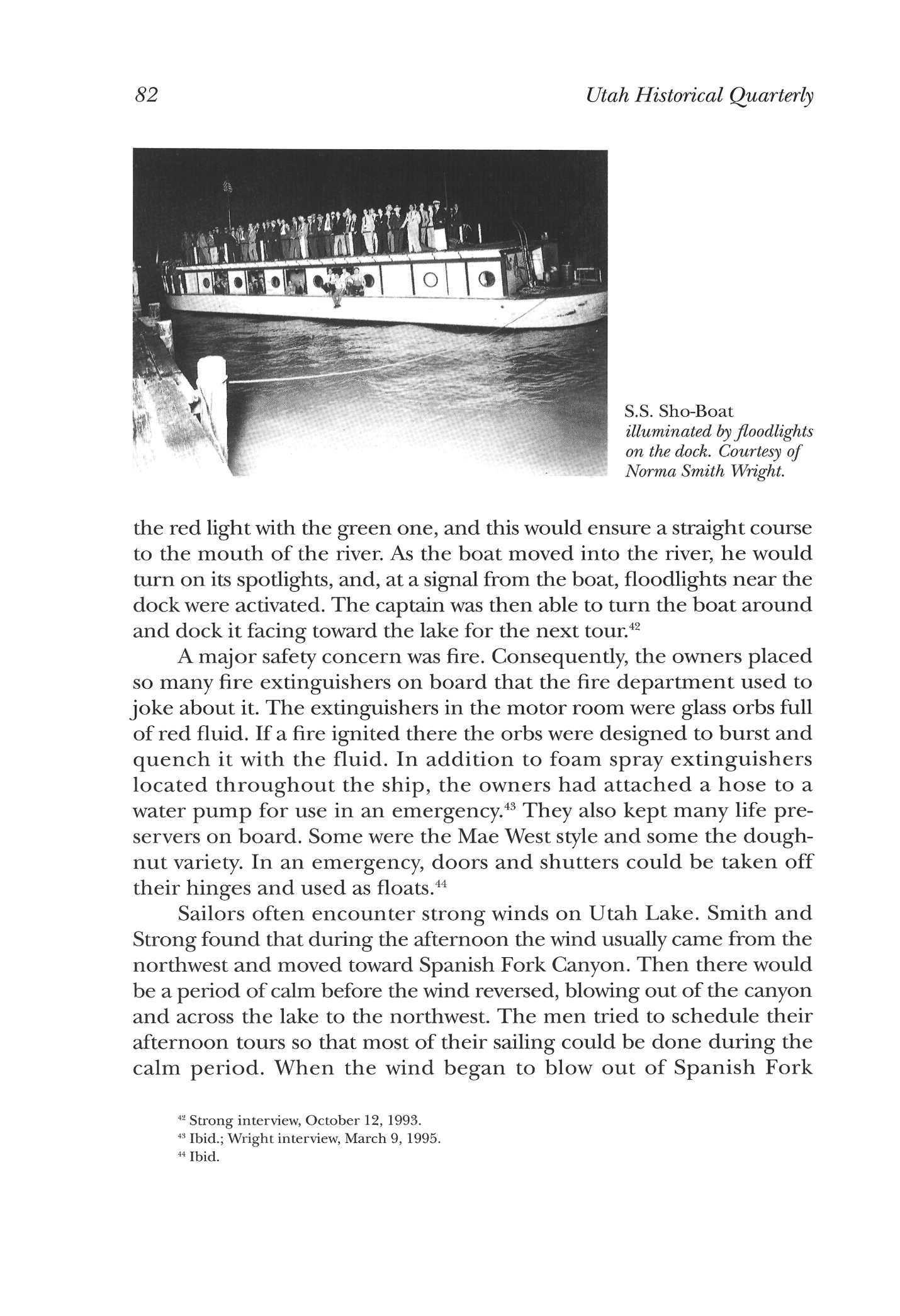
82 Utah Historical Quarterly
S.S. Sho-Boat illuminated by floodlights on the dock. Courtesy of Norma Smith Wright.
Canyon, they wanted to be near the mouth of Provo River and on their way into port. In spite of their precautions, the boat did encounter storms, and several violent thunderstorms really tested the mettle of the boat and its ability to stay afloat. One evening when the Footprinters Club had chartered the boat, an exceedingly violent storm accompanied by high winds struck the lake while the craft was quite a distance north of the mouth of Provo River. Co-captains Smith and Strong decided it would be safer to drop the anchors with the boat facing into the wind and stay put than to head for the river. They kept both engines running in second gear to take some of the stress off the boat and the anchor chains Huge waves swept across the lake about thirty feet apart Because the S.S. Sho-Boat was ninety feet long, one wave would crash against the bow while another would lift the boat at midships and a third would break away from the stern. The few passengers brave enough to stand on the observation deck could see the boat bend slighdywith the waves Some of the tables and coolers that had been set up on the top deck blew off. As evening darkened into night all of the passengers took refuge in the large cabin area. Vivid lightning flashes sporadically illuminated the room, and the roar of the thunder was ominous. Waves crashed against the side of the boat, and water came in around the windows and latched wall sections and flowed across the dance floor. The passengers were extremely tense. They knew there was no way to get to shore until the storm ended and all the captains could do was try to ride it out One of the men aboard that night was Johnny Halliday, a devotee of the lake who had some experience in vaudeville. In an effort to calm the fears of the passengers and divert their attention from the storm, he launched into one of his typical routines Grabbing a broom, he began to sing to it as he danced across the stage. His performance relieved some of the tension. As soon as the storm began to abate, the boat was run forward to make some slack in the anchor chains. The Footprinters were only too happy to help pull the heavy anchors up and head for the safety of the shore When the boat was finally docked, yet another problem awaited them. Nobody could get back to town because the storm had downed numerous trees, blocking the road. Still the passengers and crew felt much more comfortable now that the boat was firmly tied to the dock. The crew felt something more—the pride of knowing that they and their boat had weathered the worst storm they had ever been forced to endure.45

The S.S. Sho-Boat 83
43 Strong interview, October 12, 1993; Gary Harker, "Rotting Hulk of Provo Ship Shrouds Memory of Past Ghosts," Provo Daily Herald, May 23, 1958
In preparation for the opening of the 1940 season the owners decided to build a new helm house on the upper level of the boat. It would replace the ship's wheel in the front of the boat on the main level At that location, when people stood at the bow of the boat, which they liked to do, they blocked the pilot's vision. On the upper level no one could block the pilot's view. That same year the owners also installed two rebuilt Buick engines and gave their boat a new paintjob.46
During the late 1930s and early 40s the S.S. Sho-Boat offered additional entertainment on tours. Ajuke box installed inside the cabin provided dance music, and one of the most popular songs was "The Beer Barrel Polka." For several years special groups could play two nickel slot machines on the boat. The machines were mounted on revolving platforms inside metal cabinets with sliding doors that were kept closed and locked when not in use The slots provided entertainment for several years before the police somehow received word of their existence. The owners of the boat were informed beforehand of the impending raid. Larry Atkinson, owner of the slots, clandestinely replaced the good machines with two of his old, worn-out slots. When the police confiscated the machines, both they and Atkinson were satisfied. Thus, the gambling era on the S.S. Sho-Boat came to a reasonably happy ending.47
The Smith and Strong families often performed some aquatic feats on the afternoon tours. The men and their children were excellent at aquaplaning Since someone had to operate the vessel, Hewitt stayed with the boat and Elmer did the skiing. He was often joined by his young daughter, Norma. While another, faster boat towed the aquaplane48 through the water, Elmer would ski on one leg or on his head or would sometimes put a chair on the board and ski on his head on the chair. When Elmer and Norma rode the board together, he skied facing forward while Norma faced backward and stood on her head She would arch her legs over Elmer's shoulders, tuck them under his arms, pull herself up onto his shoulders, and then elevate herself into a standing position. As a finale Elmer would then stand on the chair. Hewitt's boys, HewittJr. and Roland, and others added to the entertainment in later years byjumping off the top of the boat,
46 Sunday Provo Herald, April 28, 1940; Provo Daily Herald, June 21,1940; Strong interview, October 12, 1993
47 Strong interview, February 15, 1995.
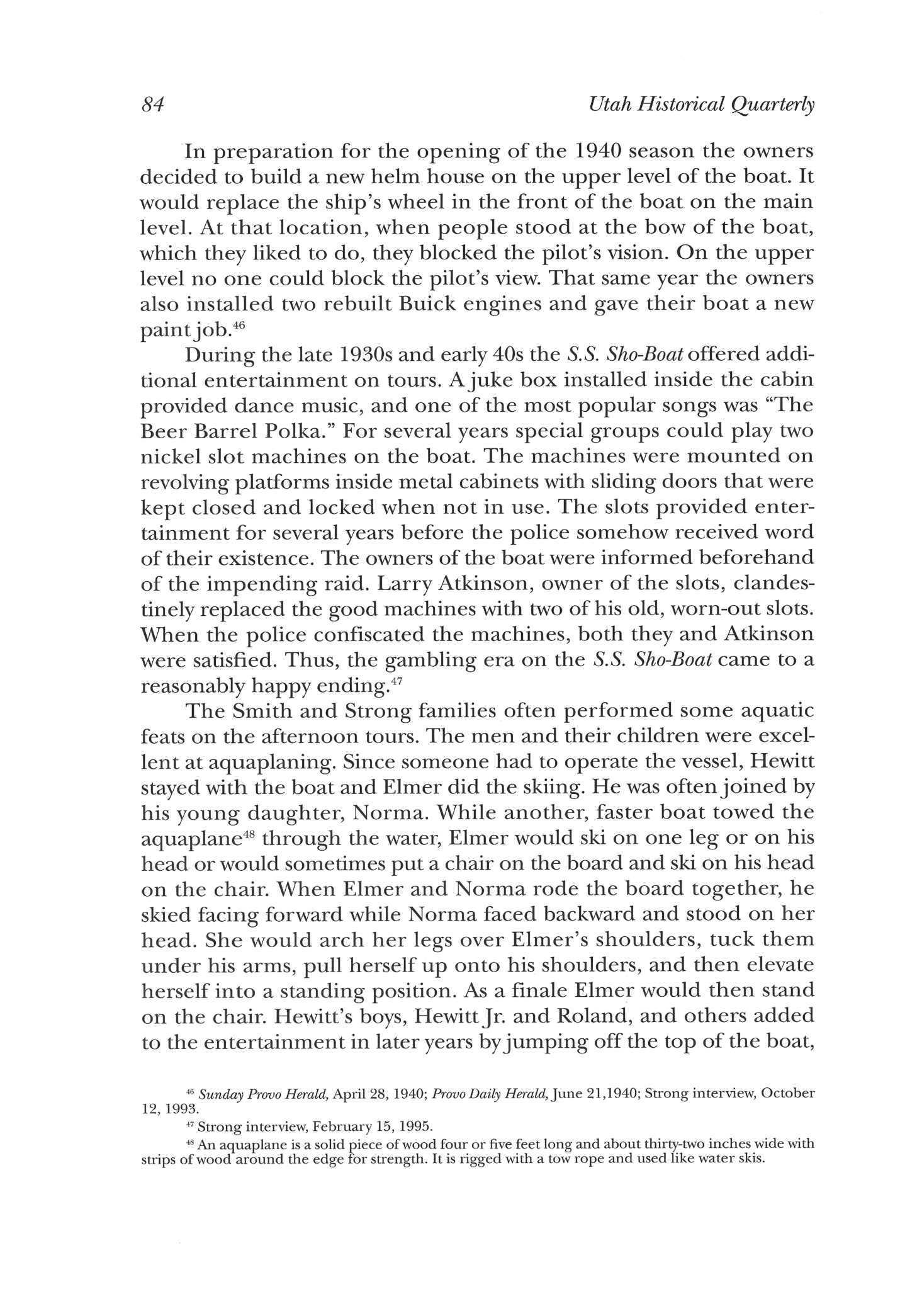
84 Utah Historical Quarterly
48 An aquaplane is a solid piece of wood four or five feet long and about thirty-two inches wide with strips of wood around the edge for strength It is rigged with a tow rope and used like water skis
drifting to the rear, swimming to a rope attached to the stern, and pulling themselves forward to the craft. It looked relatively easy, but a certain routine needed to be followed. One of the most important rules was to make a shallow dive because in many places Utah Lake is not very deep. Elmer's cousin, Jenis, who wanted tojoin the fun, was specifically cautioned about this, but he either forgot or disregarded the warning. He made a deep dive and found himself stuck head first in the muddy bottom of the lake. In his panic it seemed to take a long time to struggle free and reach the surface. The boat, which he feared had gone on, was still opposite him and its passengers were treated to a comic sight—a mud-covered head from which two wide open, frightened eyes peered anxiously around until they spotted the boat nearby.49
Although the boat was launched during the depression and could not operate for two years because of drought, it was nonetheless successful financially. No financial records are available, but both families agree that they made money Repeat cruises by church groups, women's clubs, civic clubs, public school groups, fraternal organizations, college social units, and others created this success. Some organizations reserved the boat for cruises year after year. Public tours brought in money also, but during the final years of operation the owners of the S.S. Sho-Boat did not need to run public cruises because they booked so many chartered groups Eventually the trips for public schools were discontinued because the students had become too wild and destructive. Besides, the boat was booked solid for about two years in advance. Business held up well through World War II. The people working so hard on the home front needed some way to relax and forget their worries. Geneva Steel held parties on the boat, and people even came down from Salt Lake to cruise. Advertising was no
Strong interview, October 12, 1993; Wright interview, March 9, 1993

The S.S. Sho-Boat 85 •V
Hewitt Strong on Elmer Smith's shoulders on Utah Lake. Courtesy of Norma Smith Wright.
longer necessary. The last eight years the boat operated were probably the most profitable because of repeat business
Because Elmer and Hewitt had regularjobs, profits from the boat provided extra money for their families The men got the profit from the operation of the boat, and the women got the profit from the concessions on board. Elma and Etta always claimed they made more money, and the men reluctantly agreed. The women paid only for their supplies, while the men paid for gasoline, oil, ordinary maintenance and repair, and vandalism However, both men and women were happy for the modest profit they made. Elmer used his money to help pay off the mortgage on his farm. Both families used the money for recreation that would have been impossible otherwise.50
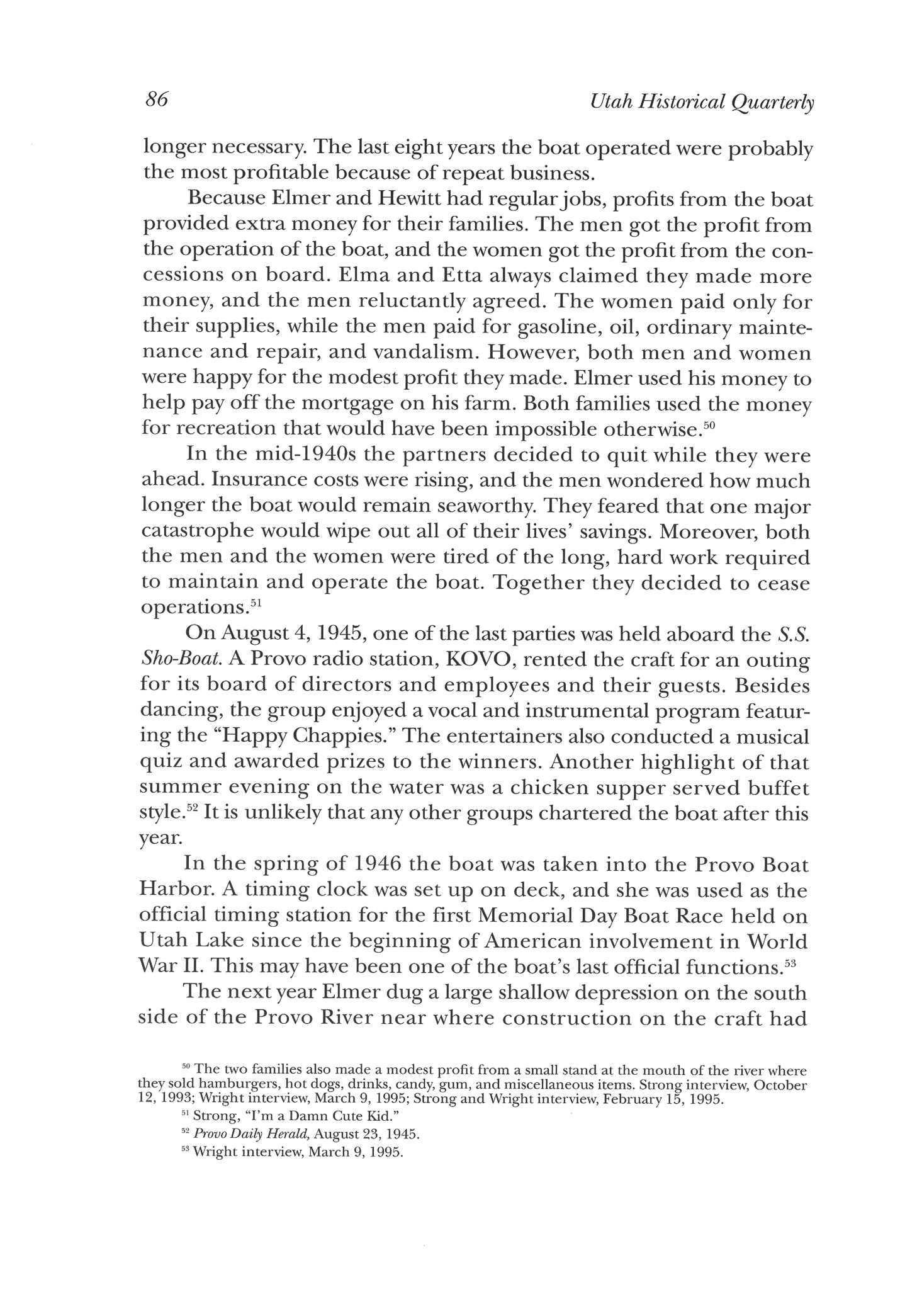
In the mid-1940s the partners decided to quit while they were ahead. Insurance costs were rising, and the men wondered how much longer the boat would remain seaworthy They feared that one major catastrophe would wipe out all of their lives' savings. Moreover, both the men and the women were tired of the long, hard work required to maintain and operate the boat Together they decided to cease operations.51
On August 4, 1945, one of the last parties was held aboard the S.S. Sho-Boat. A Provo radio station, KOVO, rented the craft for an outing for its board of directors and employees and their guests Besides dancing, the group enjoyed a vocal and instrumental program featuring the "Happy Chappies." The entertainers also conducted a musical quiz and awarded prizes to the winners. Another highlight of that summer evening on the water was a chicken supper served buffet style.52 It is unlikely that any other groups chartered the boat after this year.
In the spring of 1946 the boat was taken into the Provo Boat Harbor. A timing clock was set up on deck, and she was used as the official timing station for the first Memorial Day Boat Race held on Utah Lake since the beginning of American involvement in World War II This may have been one of the boat's last official functions.53 The next year Elmer dug a large shallow depression on the south side of the Provo River near where construction on the craft had
50
51 Strong, "I'm a Damn Cute Kid."
52 Provo Daily Herald, August 23, 1945
53 Wright interview, March 9, 1995
86 Utah Historical Quarterly
The two families also made a modest profit from a small stand at the mouth of the river where they sold hamburgers, hot dogs, drinks, candy, gum, and miscellaneous items Strong interview, October 12, 1993; Wright interview, March 9, 1995; Strong and Wright interview, February 15, 1995
begun fifteen years earlier. The hole was filled with water from the river and the boat was floated into it. The craft was blocked up and the water was pumped from the excavation. After the boat was dry docked, the owners considered converting it into a restaurant but later decided against it It was not long before vandals struck They repeatedly broke into the boat and stole things. The owners could not find an effective means of stopping them. The boat's elaborate wheel disappeared, as did the anchors and even the dual Buick engines. Almost everything that could be separated from the boat was stolen. The Strong family managed to salvage the ship's bell and its siren which had come from an old frre engine. Hewitt was pleasantly surprised some years later when he received a call from a returned LDS missionary who offered to return both anchors to soothe his guilty conscience The Strongs accepted them happily with no questions asked.54 When Utah Lake came up to a near record level in the early 1950s, water again surrounded the S.S. Sho-Boat. Cracks between thejoints in the bottom of the craft let water in. Waves sent driftwood crashing into her sides, and water inside her cabin did irreparable damage. Elmer and his son-in-law, Boyd Wright, salvaged some of the wood around 1958 to use in Elmer's new home and carport on the family farm in Edgemont near the mouth of Provo Canyon.55
Commodore Elmer Smith evidently missed having a large boat on Utah Lake. He hired a structural engineer from Geneva Steel to design a steel-bottomed boat ten feet wider and fifteen feet longer than the old one. The Korean War ended his dream. The demand for steel increased to such an extent that he could not secure enough to build the boat, and he eventually lost interest in the project.56
Since the beaching of S.S. Sho-Boat, no large excursion boat has plied the waters of Utah Lake, and it is unlikely that one ever will. Insurance expense alone would make the cost prohibitive. Today's speed- and action-oriented generation would probably not be satisfied with an eight-mile-per-hour cruise over a turbid lake to an island without a theme park. But if Lake Bonneville ever reappears and begins to fill Utah Valley, there is a house in Edgemont that will likely turn over in the water and sail like a boat toward Rock Island.
54 Strong interview, October 12, 1993; Wright interview, February 15, 1995
55 Sunday
March 9, 1995
Herald, April 6,
55 Wright interview, March 9, 1995

The S.S Sho-Boat 87
Provo
1952 Elmer also used lumber from the boat to build a workshop across the road from his home, and, ever ingenious, to convert a bread truck into a camper Wright interview,
Book Reviews
To say this is a beautiful book is an understatement To consign it to the ranks of traditional coffee table books looked at once and set down as part of a room's decor, never being read, would be a true tragedy. Smart and Telford have created a book that gives the reader a grand tour of Utah, a general scope of its history, and an introduction to the contemporary issues affecting its people While not sporting the official centennial logo, it celebrates all that the centennial is about and is an excellent commemorative work that will not be dated for some time.
Although the beautiful color photographs have a tendency to dominate one's first impressions, the text proves to be equally important From the foreword by Leonard J. Arrington to the main text written by Smart, there is a personal feeling of love and appreciation for the land, its history, and its people. It is done with gentle humor as when Arrington says: "Utahns are also a practical people. The wiser ones appreciate the state's pluralism. . . . " (p. xiv) or an account by a Dixie pioneer who described the Black Ridge as a route with only one bump—but it was forty miles long And it is done by Smart who structures the book by dividing the state into geographical quarters with a separate chapter on the Wasatch Front and describes each from three different perspectives: original accounts of others, a historical summary, and a personal essay Smart loves
good writing and beautiful words. The quotes from others are carefully selected and run the time spectrum from Father Escalante to Ed Geary with representation from articulate geologists, explorers, and literary giants like Wallace Stegner. While historical Hispanics are included, the only noticeable gap is the lack of descriptions from Native Americans, who have lived here the longest and perhaps know the land best, and other ethnic immigrants
The history sections, while general in nature, are accurate and in modern terms "user friendly." They make an excellent introduction into knowing and understanding the past of each diverse area, giving insights into geologic time as well as historical time. There is just the right amount of archaeological and botanical information to provide a vision of the past and a feeling for the present. Although the space is limited, the survey of history is interspersed with occasional human stories, and the reader stays personally involved The personal essay that concludes each section makes the narrative immediate and alive. Smart obviously loves the land and shares wonderful experiences about his coming to know it through years of hiking and exploring I did find the lines used to delineate the personal essay sections somewhat distracting. They tend to clutter up what is otherwise a very clean and artful layout Perhaps a simple graphic at the beginning of
 Utah: A Portrait. Text by WILLIAM B SMART and photographs by JOH N TELFORD (Salt Lake City: University of Utah Press, 1995 xxii + 232 pp $39.95.)
Utah: A Portrait. Text by WILLIAM B SMART and photographs by JOH N TELFORD (Salt Lake City: University of Utah Press, 1995 xxii + 232 pp $39.95.)
these sections would have been more appropriate Telford's photographs, as usual, are spectacular. Although a variety of sizes are necessary for such a book, I often found myself wishing that each print covered a full page There is a wealth of detail to be savored and studied. Often I found myself metaphorically entering into some of the images so that my own story became part of the landscape I was viewing Telford shows Utah in all its diversity and glory, depicting the change of seasons and in some instances the effects of population change. While the book is not an advocacy piece for any special interests, it does show what we, in Utah, have and what we can lose The photo chosen to close the narrative (p. 222) is both a quiet image and a statement.
Although I can never see enough of Telford's work, I did feel that the need to squeeze in several more pictures, sometimes separating the narrative and image description from an actual picture illustration by a page or two, happened a few too many times The collaboration of writer and photographer is always strongest when the words and image are on the same page and close together
Still, with only minor criticisms, this is a book I am proud to own and show to friends It is a book I will open again and again, and notjust for the pictures I do understand and appreciate Utah better after reading it.
DELMONT R OSWALD Utah Humanities Council Salt Lake City
Great and Peculiar Beauty: A Utah Reader. Edited by THOMAS LYON and TERRY TEMPEST WILLIAMS (Salt Lake City: Gibbs Smith, Publisher, 1995. xiv + 1010 pp. $49.95.)
Once you see them all in one place—Utah's authors, that is—you will be amazed and delighted as I was at the quality, the quantity, and the breadth of writing this state has produced. Many of these writers will be familiar to any lover of Utah literature, but many of you might find yourself saying, as I did, "Oh yes, I had forgotten about this writer or that one." As far as I can tell, they are nearly all here—part-timers like Mark Strand and Edward Abbey, move-aways like May Swenson and Bernard DeVoto, move-ins like Stephen Trimble and Merry Adams, and natives like Dale Morgan and Helen Papanikolas Yes, one might quibble that someone like the chronicler of the San Juan, Albert R Lyman, should have been included instead of his father, Platte D. Lyman, but the editors have done a remarkable job of combing the state's literary heritage and ade-
quately representing it in this centennial edition
The editors' premise for organizing is original. They ask the question whether the state's cultural development has been inspired by the diversity of its landscapes: "Could the literary landscapes of Utah mirror the physiographic regions they have grown out of?" Perhaps it is not surprising that a celebrated nature writer like Terry Tempest Williams and a well-known editor and scholar of nature writing like Thomas Lyon would approach their task in such a way But what they have amassed is impressive Their anthology makes for a convincing argument that in fact Utah's landscape, be it rural or urban, has largely influenced its literature. The five terrains and literary provinces they have identified are: Urban Terrace, Great Basin, Colorado Plateau, Mountains, and Dixie (a corner of the Mojave Desert)
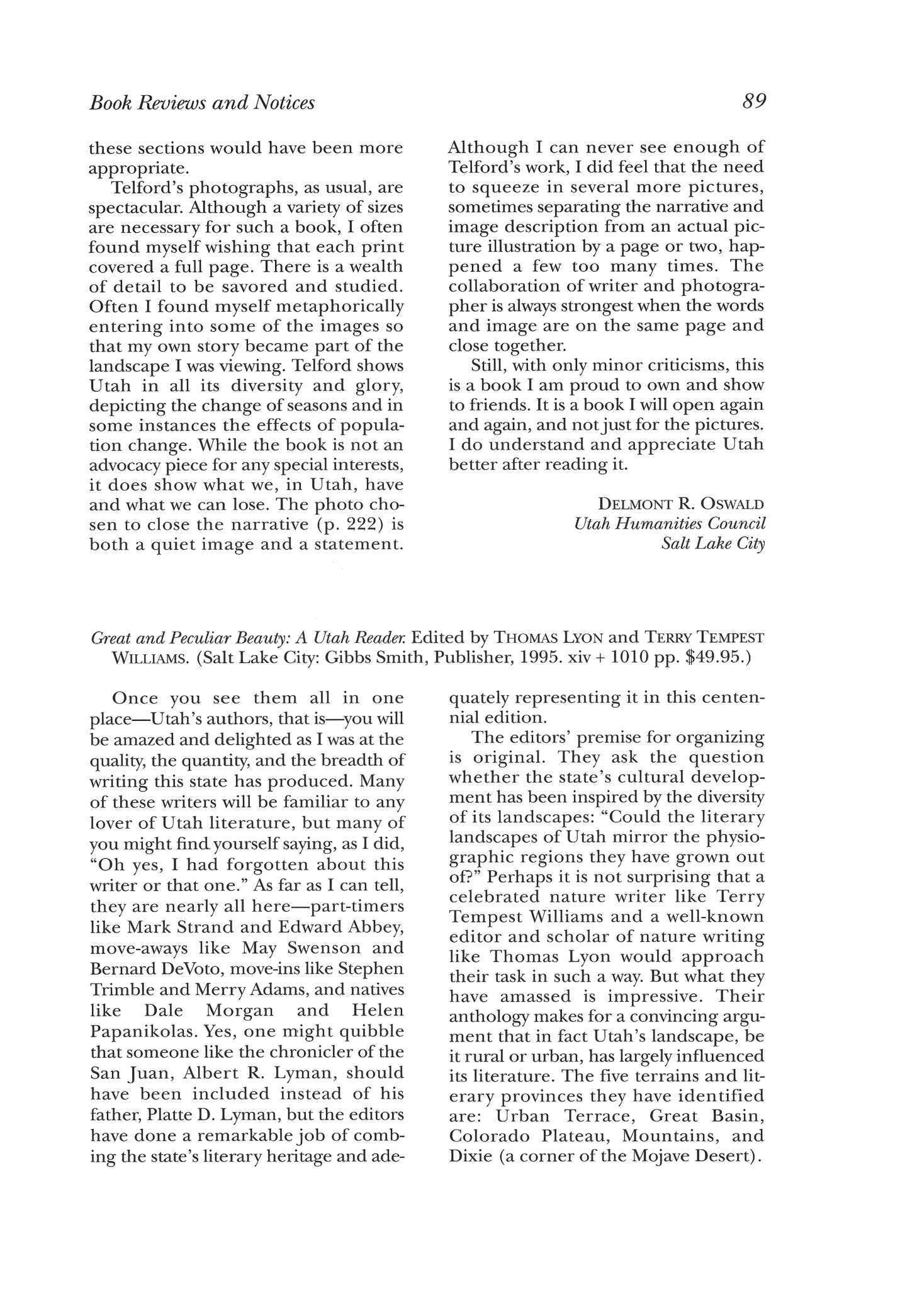
Book Reviews and Notices 89
In addition to geographical diversity, this anthology includes authors from all walks of life in Utah Thus, in addition to such mainstream writers as Wallace Stegner and Ratherine Coles, the editors have added recollections of Topaz from Marii Ryogoku and Yoshiko Uchida, a Navajo Blessingway chant from Bernice O Bia Levchuk, the letters of a polygamous wife from Catharine Cottam Romney, and the journals of explorers Dominguez and Escalante. This collection reflects Utah's cultural diversity without being "pc." And these writers do seem to rise out of the landscape
At over 1000 pages, the anthology makes for easy dipping Readers might want to read from start to finish or, as I did,just browse,jumping around from region to region, author to author
They will find a lot of what might be expected from a Utah anthology: stories of pioneer struggles, of religious predicaments, and of nature appreciation. But they will also discover writers like Dianne Nelson exploring the dark side of life in Utah Her "In the Shadows of Upshot-Knothole" looks at the frenzy of her parents' sex life in the context of an open air nuclear test.
I would like to mention every story, poem,journal, or essay that I especially like, but that would be impossible Readers willjust have to purchase this book themselves (while overlooking numerous proofreading errors) and enjoy reading their way across the Utah landscape. It is a rich one.
JAMES M ATON Southern Utah
University
Culture Clash and Accommodation: Public Schooling in Salt Lake City, 1890-1994. By FREDERICK S. BUCHANAN (San Francisco and Salt Lake City: Smith Research Associates in association with Signature Books, 1996. x + 300 pp. $24.95.)
Dr Buchanan has written a most delightful book about Utah education
As his expert and objective eyes view the volatile and emotional context of public education, the reader becomes an eyewitness to tensions between Mormons and non-Mormons, the gradual accommodation of Mormon society to national norms, the wielding of raw political power, the effect of social and economic forces on the schools, the force of individual personalities, and the interplay of national education policy and educational organizations with local needs and outcomes The book's great appeal comes perhaps from its attention to local history Yet, by the end, the reader had become familiar with most national and state trends and events.

To write this history of public education took not only someone who knows how to research and write
clearly but also someone who thoroughly knows education history, education theories and trends, and Mormon culture. It also took someone with objectivity and fairness. It took someone with a compassion for human aspirations and frailties It took someone with a passion for public education Buchanan exhibits all of these qualities
Anyone who is directly involved in shaping public school policy will be surprised when reading this book to find that most issues facing today's schools—diversity, urban decay, crime, school closure, drop-outs, school-towork, student achievement, national educational goals, religion in the curriculum, school financing—have all been faced and dealt with many times before. The consequence of this revelation is a confirmation of Buchanan's thesis: namely, that schools have had
90 Utah Historical Quarterly
only a limited effect in trying to correct society's ills. He believes that "schools mirror the societies that maintain them" and that "schools tend to follow, rather than precede, social and cultural change." Thus, the book gives policy makers and the public a muchneeded perspective on the limitations of public school policy and the need for a much broader base for effecting social change Nevertheless, Buchanan holds out the hope that teachers and administrators, when working closely with parents, can be called upon to help society at least address the problems of gangs, drugs, teen pregnancy, illiteracy, racism, and bigotry while promoting higher-order thinking skills in all students across the curriculum.
Buchanan's stated purpose for the book is to "communicate some understanding of how the schools came into being, the important changes that
occurred and the issues and problems which were faced during the first century." He has succeeded in that purpose by tracing changes in the public's view of the city's schools as a bulwark against the "world" to the theme of the 2002 Winter Olympics that "The World Is Welcome Here."
The book is meticulously researched and well written. It will be counted as one of the finest of the many centennial historical contributions and will likely be the definitive history of Utah schools during the first one hundred years of statehood. But most of all, the book demonstrates the basic motivation of most people involved in public education—to do what is best for the children
The Frontiers of Women's Writings: Women's Narratives and the Rhetoric of Westward Expansion. By BRIGITTE GEORGI-FINDLAY (Tucson: University of Arizona Press, 1996. xxii + 349 pp. Cloth, $45.00; paper, $19.95.)
In A Century of Dishonor (1881) Helen Hunt Jackson aimed at the nation's Indian policy. In Frontiers of Women's Writings we have another study of a century of dishonor. The difference is that Georgi-Findlay has discovered the dishonor to have been of women That was, some of the women who made their way to the frontier were, as Georgi-Findlay frames the charge, "complicit" in the "westward expansion" (p. x). Of course, some did not make themselves accessories to that fact But insofar as women didjoin with men in the national enterprise, they stand guilty in Frontiers of the felony charge of "imperialism" (p xi)

Now, it would be misleading to weight Georgi-Findlay's words more carefully than she appears to have used them. But words are all we have to
think with; words do reveal dispositions of mind; words can bewitch other intelligences That the Untied States should be lumped with those regimes to which "imperialistic" does apply is the first of the logical high hurdles you will go over.
There are more barriers to jump, notably four of them The women's "rhetoric" was so diverse that it elicited four modes of theoretical analysis: feminine discourse, narrative discourse, colonial discourse, and nationalistic discourse.
These amount to an awful tangle of jargon as, for instance, in a claim with respect to All Over Oregon and Washington, a guidebook published in 1872 by Frances Fuller Victor "It illustrates," according to Georgi-Findlay, "how a woman historian in search of a
Book Reviews and Notices 91
ROGER H THOMPSON Salt Lake City
profession abandons a subjectivist personal narrative and suppresses discourses of femininity (and feminism) in the service of promotionalism" (p 197) Overlooked or denied is the possibility that women, too, could have thought the West a promising place for, say, those things basic to life—like putting up a house and bringing in a garden in advance of the coming cold season.

It is not the specific ills of the republic that come under attack. GeorgiFindlay's discontent lies with some vague concept of western civilization. But note well, it is the abstraction of civilization that has lately served the ambitious post-modern theorist as a "straw man." Civilization here is an idea that can be easily knocked down in the service of Utopia (My bet is the author
makes her bed in a house and drives a car, like the rest of us.)
But on paper, hers is the stirring of—virtually the outline of—a new body politic. Culture will here ever after be regarded with the relativism holding that one is every bit as good as the next All this nasty business of seemingly strong cultures overwhelming or subsuming weaker cultures has got to stop
Georgi-Findlay's critique may serve that end Or the result may be a perverse throwing away of even such fundamental civilization as frontier women helped found
As far as I know, this book is unique in that it combines a popular history of our great traditional western trails— Lewis and Clark, Santa Fe, OregonCalifornia, and Mormon—with three nontraditional or "communication trails"—the Pony Express, the transcontinental telegraph, and the transcontinental railroad An unusual combination, but it works (Of course, one can argue that there was/is no such thing as the Lewis and Clark "trail." It was a boat's wake, an exploring route.)
Although not quite a coffee table book, it has an uncommon 10 by 7.5inch format and is printed on slick paper loaded with fifty-three handsome illustrations in full color, scores of valuable black and white photos from many archives, and twelve good maps.
One the plus side, this work makes excellent armchair reading and recounts the "big picture" by present-
ing the background of each trail. The author tells many fascinating stories of the various trails and enlivens the account with good quotations. (After all, history is hi-story or narrative—or is supposed to be.)
On the minus side, the author makes no pretense of scholarship. The jacket blurb gives him a Ph.D from Columbia University but fails to say in what discipline—I suspect French studies The book is largely anecdotal, episodic, and often discursive. The chapter on the Mormon Trail, for example, is as much a quickie history of that church as of that trail. While the Mormon account is objective, it is also often wrong The Book of Mormon had nothing to do with the Mormons' going west; it is twelve apostles, not elders; the chronology is a bit mixed up here and there; Brigham Young did not replace Joseph Smith in 1844 or in 1845 (it was in 1847); the number of
92 Utah Historical Quarterly
RUSSELL BURROWS Weber State University Ogden, Utah
Seven Trails West. By ARTHUR KING PETERS (New York: Abbeville Press, 1996. 252 pp. $39.95.)
plural marriages is wildly exaggerated; Emma Smith never divorced Joseph; just where Young said "this is the place" is debatable; the original pioneering trek lasted 111 days, not 100; the returning pioneers of 1847 did not "unexpectedly" meet westbound Mormons; and the handcart trail was more than 1,000 miles long, up to 1,300.James Marshall, by the way, was not a Mormon There are also a good many mistakes in the Santa Fe Trail chapter Such errors raise red flags
The fifty-six-item bibliography is very basic and does not list many of the best trail studies There are only eightynine endnotes. Not only is this book
armchair reading, but it appears to have been armchair written There is only the slightest evidence that the author has followed any parts of his chosen trails—been out "in the dirt." I found, for example, no photographs taken by him.
It is difficult to recommend this book It really is a "good read" and so well illustrated. I read every word and liked the author's style, but readers must be advised that the scholarship is exceptionally questionable
STANLEY B KIMBALL Southern Illinois University Edwardsville
A World We Thought We Knew: Readings in Utah History. Edited byJOH N S. MCCORMICK and JOH N R SILLITO (Salt Lake City: University of Utah Press, 1995 x + 491 pp Cloth $65.00; paper, $24.95.)
This commemorative volume, edited by two well-known Utah historians, comprises thirty rather uneven selections treating issues ranging from Mormon-Indian relations to Salt Lake City prostitution in the late nineteenthcentury, from the election to local office of scores of Socialists between 1900 and 1920 to the internment of Japanese Americans during World War II, from environmental history to the growth of a new urban West.
Unfortunately, the selections are not new, and so one wonders about the validity of this volume All but one of the articles selected have appeared in magazines,journals, or books, some of them as long ago as the 1970s, with the great majority having appeared in Utah Historical Quarterly. In organizing the selections into one volume, the editors said they were trying to "illustrate the expanding boundaries of Utah's history, and contribute toward building a more complete understanding of the state's past."
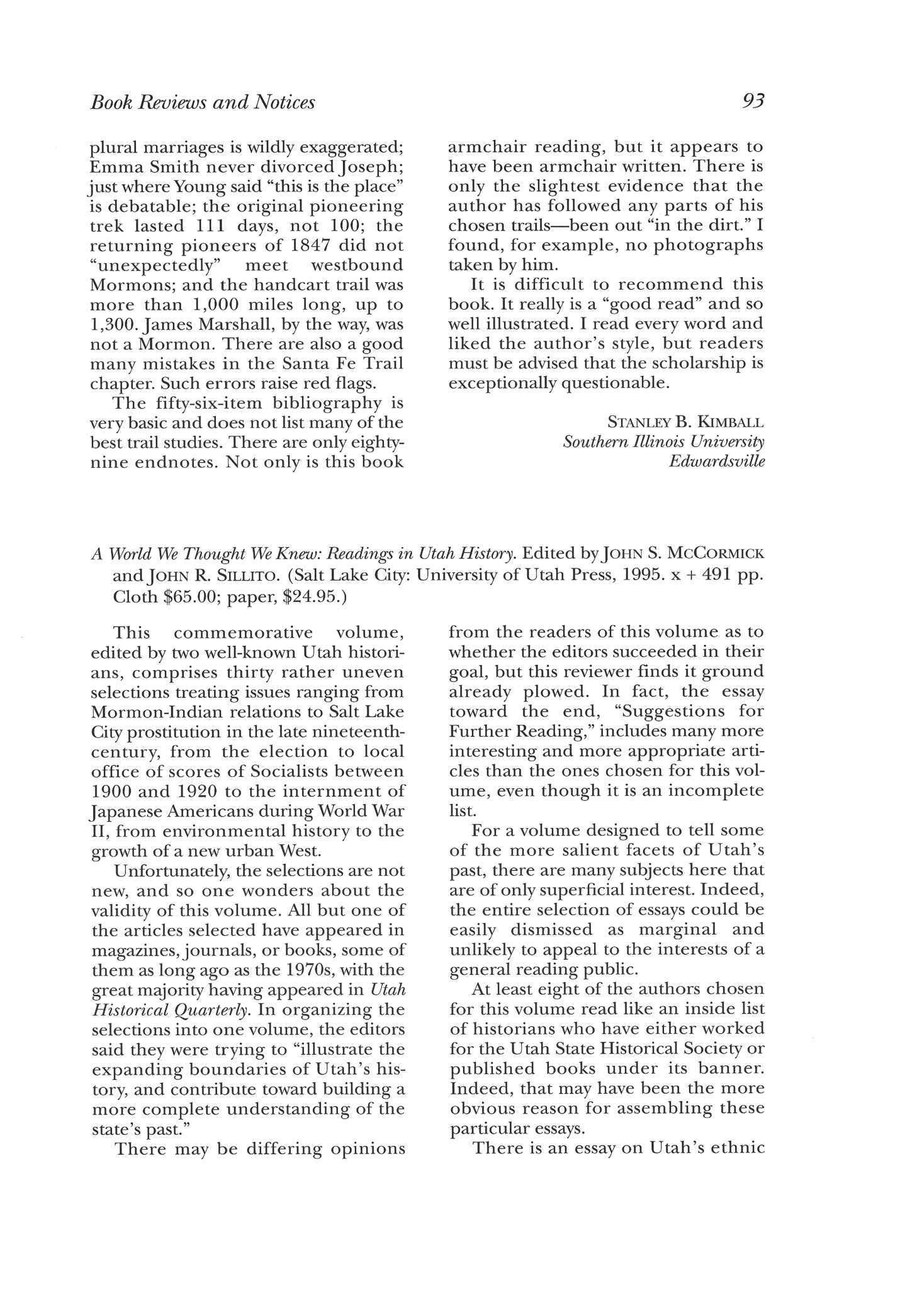
There may be differing opinions
from the readers of this volume as to whether the editors succeeded in their goal, but this reviewer finds it ground already plowed. In fact, the essay toward the end, "Suggestions for Further Reading," includes many more interesting and more appropriate articles than the ones chosen for this volume, even though it is an incomplete list
For a volume designed to tell some of the more salient facets of Utah's past, there are many subjects here that are of only superficial interest Indeed, the entire selection of essays could be easily dismissed as marginal and unlikely to appeal to the interests of a general reading public.
At least eight of the authors chosen for this volume read like an inside list of historians who have either worked for the Utah State Historical Society or published books under its banner Indeed, that may have been the more obvious reason for assembling these particular essays
There is an essay on Utah's ethnic
Book Reviews and Notices 93
diversity, but there is no attempt to delve into the fascinating history of blacks in early Utah There are essays on the fur trade, prostitution, and the seagull, but virtually nothing about the importance of the Mormons in Utah's history Although the volume professes to place special interest on the twentieth-century, there is only a single essay about twentieth-century politics— Ernest Wilkinson's unsuccessful race for the U.S Senate in 1964 Strangely, there is nothing at all about the really important politicians in twentieth-century Utah, such as Governor J Bracken Lee, who stands out above all other political figures, or Calvin Rampton and Scott Matheson, who presided over a Democratic dynasty that endured for twenty years
Clearly, Wilkinson, who raised many hackles in a lengthy tenure as president of Brigham Young University, had almost no political career at all, and therefore rates only an asterisk in Utah's political history
In a collection made up mostly of
academic articles, there are a few that seem glaringly out of place—such as reminiscences and puff pieces from the now defunct Utah Holiday Magazine. If the editors wanted to go in a less scholarly direction, they could have balanced their approach by including any number of better or more representative feature stories about Utah life and politics from the Deseret News and the Salt Lake Tribune. But do they want academic analysis, or do they want journalistic descriptions and impressions? The decision should have been made prior to publication.
There are only two essays that make an important enough contribution to Utah's history to in factjustify the price of the book—Robert Goldberg's fine essay on "Building Zions: A Conceptual Framework" and Sandra Taylor's insightful piece on theJapanese internment at Topaz

94 Utah Historical Quarterly
DENNIS L LYTHGOE University of Utah
M4f m&mmM Book Notices mm
Buckskin Entrepreneur: Antoine Robidoux and the Fur Trade of the Uinta Basin, 1824-1844. By JOH N D. BARTON. (Vernal, Utah: Oakfield Publishing Co., 1996. viii + 120 pp. Paper, $9.95.)
John Barton, a Uinta Basin native who has been teaching history at Utah State University's Vernal campus since 1988, has had a life-long interest in local history, especially the fur trade Locally, Antoine Robidoux was the central figure in that trade for two decades, but historians have not really given the Basin fur trade or Robidoux the attention they merit. Barton took up the quest first with his master's thesis and later with additional research that led to the publication of this modest book. "After exhaustive research this is all the information that could be found," Barton apologizes in his preface It is certainly enough to give readers a far better concept of Robidoux's career in the Basin than they have previously had and to present evidence for dating both the building and the burning of Robidoux's forts This gem of a book is what good local history is all about. Polygamous Families in Contemporary Society. By IRWIN ALTMAN and JOSEPH
GINAT (New York: Cambridge University Press, 1996. xv + 512 pp. Cloth, $54.95; paper, $27.95.)
Social psychologist Irwin Altman of the University of Utah and Joseph
Ginat, an anthropologist at the University of Haifa, Israel, examine husband-wife and wife-wife relationships within contemporary Mormon polygamous families in this intriguing book Using interviews and observations, they describe how spouses in plural families cope with their complex lifestyle in everyday life, including courtship, weddings, honeymoons, living arrangements, and the husband's rotation among his wives The authors also look at budget and resource management, psychological attachments to homes, and the social and emotional relationships among family members. The authors were accepted into numerous homes where they observed family dynamics and talked informally with husbands and wives Their comprehensive analysis of life in presentday fundamentalist groups, both urban and rural, is scholarly, dispassionate, and very readable. Their research will be used and cited for years to come.

Western Lore and Language: A Dictionary for Enthusiasts of the American West. By THOMAS L CLARK (Salt Lake City: University of Utah Press, 1996 xvi + 266 pp $24.95.)
From Area Fifty-One (the Nevada Test Site associated with extraterrestrials) to zaguan (the long entryway in a hacienda), this book is meant for browsing rather than for use solely as a reference work. The entries are minitales of life in the western states, including Alaska. They are informative,
amusing, and thought provoking in turn Clark tells us, for example that carrot eater/carrot snapper and cricket stomper are derogatory terms Idahoans use for a Utahn, particularly a Mormon—sometimes in response to being called spud head or spud eater by a Utahn or a Mormon The author is sure to get many suggestions for inclusion in a future revised edition.

side of the psyche Hisheroes are complex figures with both strengths and weaknesses and conflicting moral codes. Bugles in the Afternoon (1944), one of Haycock's best-known novels, even won grudging admiration from Bernard DeVoto, who thought itwas historically sound and "almost a good novel."
Stephen Tanner, a professor of English at Brigham Young University, examines Haycock's life and development asa writer and brings a fresh, critical perspective to a genre that is often dismissed as second-rate.
Originally issued in 1979, Elliott West's look at the role of the saloon in mining towns provides insights into both economic and social history Park City saloonkeeper Jack Pape, for example, is cited as an example of the barkeeper with a conscience. He sponsored benefits to raise money for a firehouse, cemetery improvements, aid to orphans, etc West traces the evolution of saloons from tents and shanties to elaborate establishments that offered gambling and other forms of entertainment, not to mention vice
White Man's Wicked Water: The Alcohol Trade and Prohibition in Indian Country, 1802-1892. By WILLIAM E UNRAU (Lawrence: University Press of Kansas, 1996. xi + 180 pp. $25.00.)
Ernest Haycock. By STEPHEN L TANNER Twayne's United States Authors Series. (New York: Twayne Publishers, 1996. xii + 150 pp. $26.95.)
Ernest Haycock was a highly successful writer of westerns In moving from pulp magazines, to slicks like Collier's, to books selected by literary clubs, Haycock broke away from stereotypes of the genre and explored the darker
This book is not for the fainthearted In his epilogue, William Unrau, a distinguished research professor at Wichita State University, horrifies us with late twentieth-century statistics on alcohol and American Indians: Alcohol-related deaths are three to four times higher for Indians than the rest of the population; alcohol is a significant factor in high rates of homicide, suicide, car accidents, and family abuse; and chronic alcohol consumption bypregnant Indian women is having a devastating effect on their unborn children White Man's Wicked Water is not about this appalling situation, however, but about howand why an alcohol-sodden white society introduced drink to Native Americans in the nineteenth century and subsequently tried, with little success, to prohibit the sale of alcohol to Indians
96 Utah Historical Quarterly
The Saloon on the Rocky Mountain Mining Frontier. By ELLIOTT WEST. (Lincoln: University of Nebraska Press, 1996. xvii + 197pp.Paper, $12.00.)
UTAH STATE HISTORICAL SOCIETY
Department of Community and Economic Development Division of State History
BOARD O F STATE HISTORY
PETER L GOSS, Salt Lake City,1999 Chair
CAROL CORNWALL MADSEN, Salt Lake City,1997 Vice-Chair
MAX J EVANS, Salt Lake City Secretary
MARILYN CONOVER BARKER, Salt Lake City, 1999
BOYD A BLACKNER, Salt Lake City, 1997
CRAIG M CALL, Plain City, 1997
LORI HUNSAKER, Brigham City, 1997
CHRISTIE SMITH NEEDHAM, Logan, 1997
RICHARD W SADLER, Ogden, 1999
PENNY SAMPINOS, Price, 1999
Paul D Williams, Salt Lake City,1999
JERRY WYLIE, Ogden, 1997
ADMINISTRATION
MAX J EVANS, Director
WILSON G MARTIN, Associate Director
PATRICIA SMITH-MANSFIELD, Assistant Director
STANFORD J LAYTON, Managing Editor
The Utah State Historical Society was organized in 1897 by public-spirited Utahns to collect, preserve, and publish Utah and related history Today, under state sponsorship, the Society fulfills its obligations bypublishing the Utah Historical Quarterly and other historical materials; collecting historic Utah artifacts; locating, documenting, and preserving historic and prehistoric buildings and sites; and maintaining a specialized research library. Donations and gifts to the Society's programs, museum, or itslibrary are encouraged, for only through such means canit live up to its responsibility of preserving the record of Utah's past
This publication has been funded with the assistance of a matching grant-in-aid from die Department of the Interior, National Park Service, under provisions of the National Historic Preservation Act of 1966 as amended
This program receives financial assistance for identification and preservation of historic properties under Title VI of the Civil Rights Act of 1964 and Section 504 of the Rehabilitation Act of 1973. The U.S. Department of the Interior prohibits discrimination on the basis of race, color, national origin, or handicap in its federally assisted programs If you believe you have been discriminated against in any program, activity, or facility as described above, or if you desire further information, please write to: Office of Equal Opportunity, U.S Department of the Interior, Washington, D.C 20240
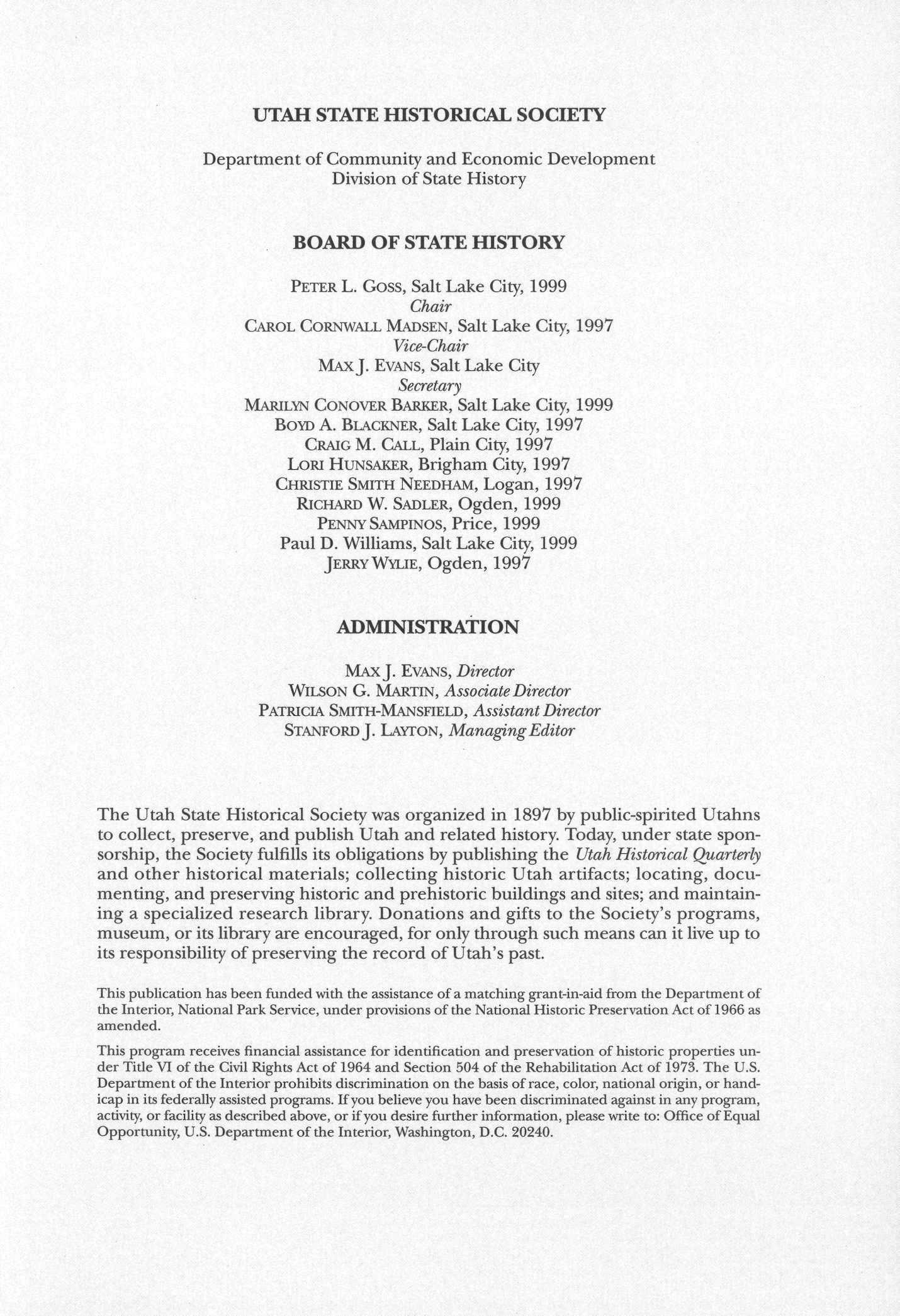






 BYROBERT S MCPHERSON
Dr McPherson, a member of the Advisory Board of Editors of Utah Historical Quarleiiy, teaches history at the College of Eastern Utah-San Juan Campus, Blanding
BYROBERT S MCPHERSON
Dr McPherson, a member of the Advisory Board of Editors of Utah Historical Quarleiiy, teaches history at the College of Eastern Utah-San Juan Campus, Blanding




















 BY CRAIG L. FOSTER
BY CRAIG L. FOSTER























 BYCATHERINE H. ELLIS
BYCATHERINE H. ELLIS














 BYD. ROBERT CARTER
BYD. ROBERT CARTER










 21 Wright interview, March 9, 1995, provided a detailed description of the interior of the boat Pictures taken by Hewitt Strong again proved very valuable See also Provo Evening Herald, August 4, 1932 A ladder near the door of the motor room also led to the upper deck 2s provo Evening Herald, April 1, 1932 Only the General Garfield on the Great Salt Lake in the late nineteenth century was larger.
21 Wright interview, March 9, 1995, provided a detailed description of the interior of the boat Pictures taken by Hewitt Strong again proved very valuable See also Provo Evening Herald, August 4, 1932 A ladder near the door of the motor room also led to the upper deck 2s provo Evening Herald, April 1, 1932 Only the General Garfield on the Great Salt Lake in the late nineteenth century was larger.












 Utah: A Portrait. Text by WILLIAM B SMART and photographs by JOH N TELFORD (Salt Lake City: University of Utah Press, 1995 xxii + 232 pp $39.95.)
Utah: A Portrait. Text by WILLIAM B SMART and photographs by JOH N TELFORD (Salt Lake City: University of Utah Press, 1995 xxii + 232 pp $39.95.)













